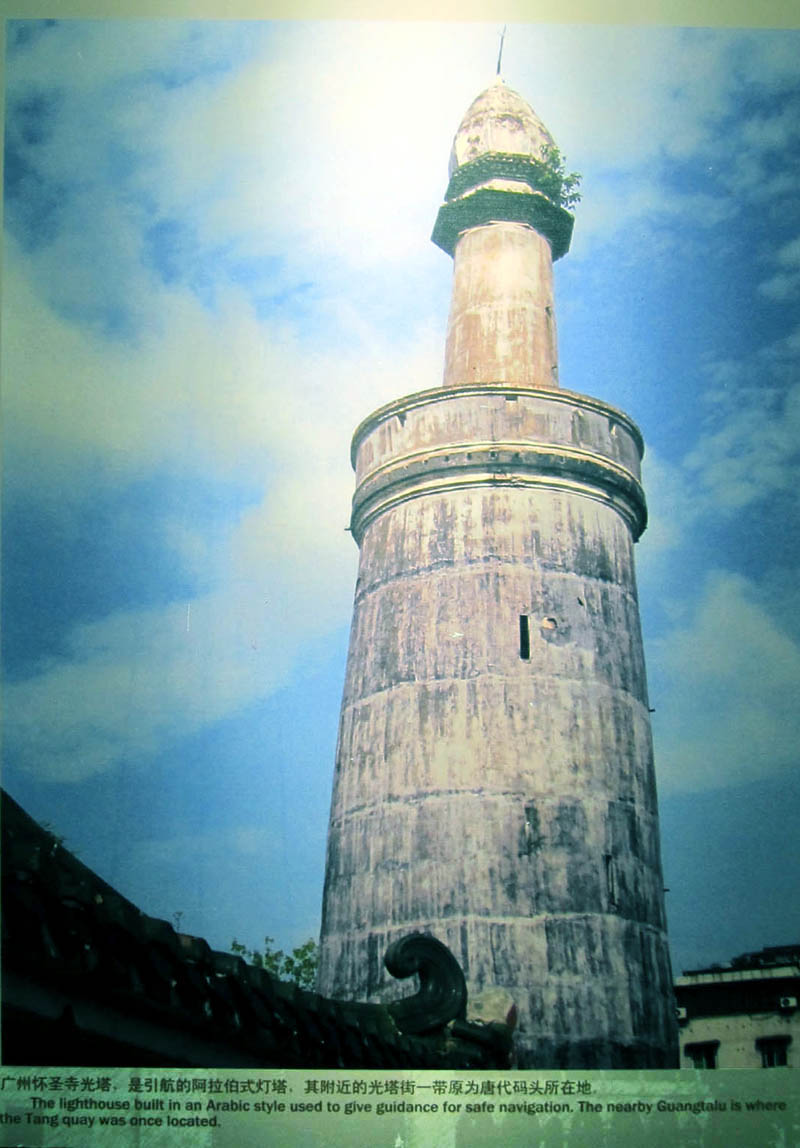
Tang/Song Guangdong Trade Ceramics
Tang Green glaze ware
Since time immemorial, the Chinese civilisation was known to have contact with the West. The overland silk route through central Asia was firmly established by the Han period and served as the main conduit for the exchange of goods and culture with the west. By the Tang period, an alternative maritime trade route emerged. Guangzhou became the main gateway for the maritime trade with Nanhai (i.e. Southeast Asia region) and the west. Shipping vessels facilitated the transportation of larger volume of commodities and heralded the first peak of maritime trade in Chinese ceramics. The Arabic style Guangzhou Huaishen mosque (广州怀聖清真寺) lighthouse witnessed a glorious chapter in the history of maritime trade. The light from the lighthouse guided ships entering Guangzhou port during the Tang Dynasty. It is located near Guangta (光塔路) road and was where an area, termed fanfang (番坊),was designated for foreigners to stay. Majority of the residents were Persian and Arab traders. A further testament and echo of its past history are many of the streets with name related to the type of transacted business/trade.

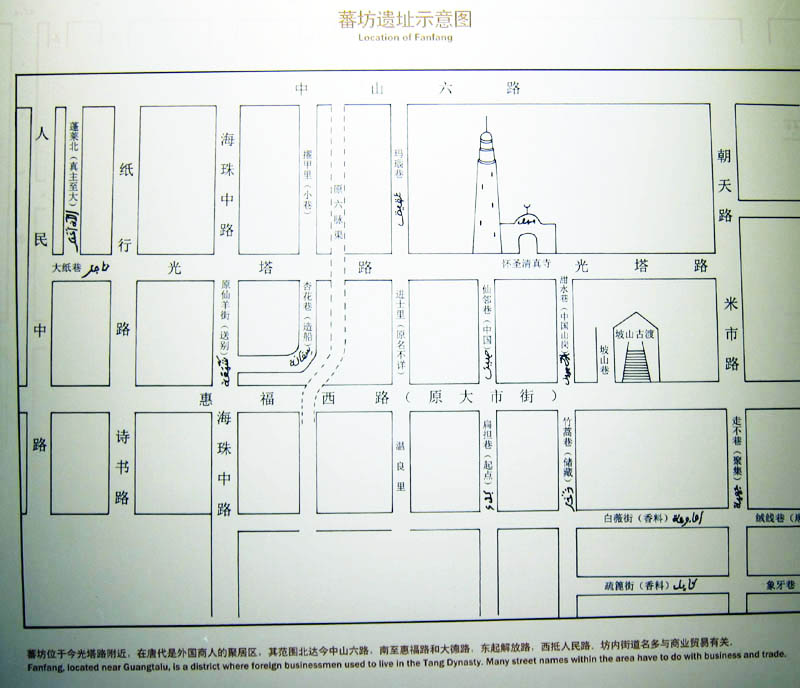
In the last 50 years, archaeological excavations of kilns sites, ancient habitation/burial sites and shipwrecks have provided wealth of information important for our understanding of trade in ancient Chinese Ceramics. With significant degree of confidence we can piece together the broad picture and know where the main ceramics products were produced and its export markets. During the Tang phase besides the famous Yue, Changsha, Xing/Ding wares and Guangdong celadon wares also formed an important component of ceramics cargo mix. Guangdong kilns with its natural and strategic advantage of proximity to Guangzhou port became important suppliers of export ceramics products. Historical and archaeological evidence clearly shows that the fortune of many of the coastal kilns was inextricably tied to the rise and demise of the neighboring port.
Large Guangdong celadon jars featured among its most prominent export. Besides serving as a commodity, they were also used as storage for smaller ceramics vessels and water during transportation. The main production sites of such large jars were kilns located in the vicinity of tributaries of the Pearl river delta. So far, archaeological surveys have uncovered production sites in Xinhui(新会) , Heshan (鹤山) and Gaoming (高明). The most well-known site excavated was the Guanchong kiln (官冲) in Xinhui . The glaze has a characteristically snake skin-like uneven and runny appearance .
Guangdong Tang celadon jars from Belitung wreck
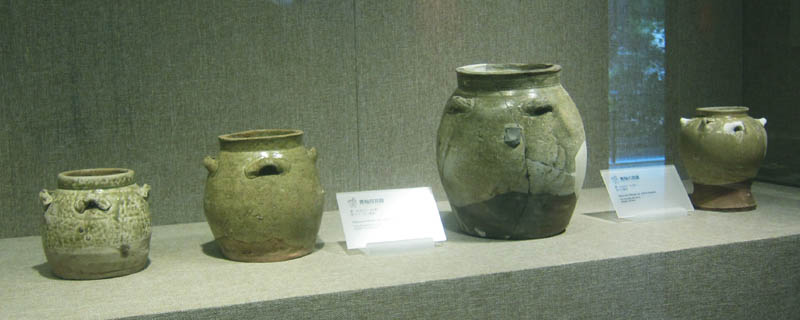
| Guangdong Tang celadon jars exhibited in the Guangdong Nanyue Palace Museum |
The typical uneven and runny glaze on Guangdong celadon jar
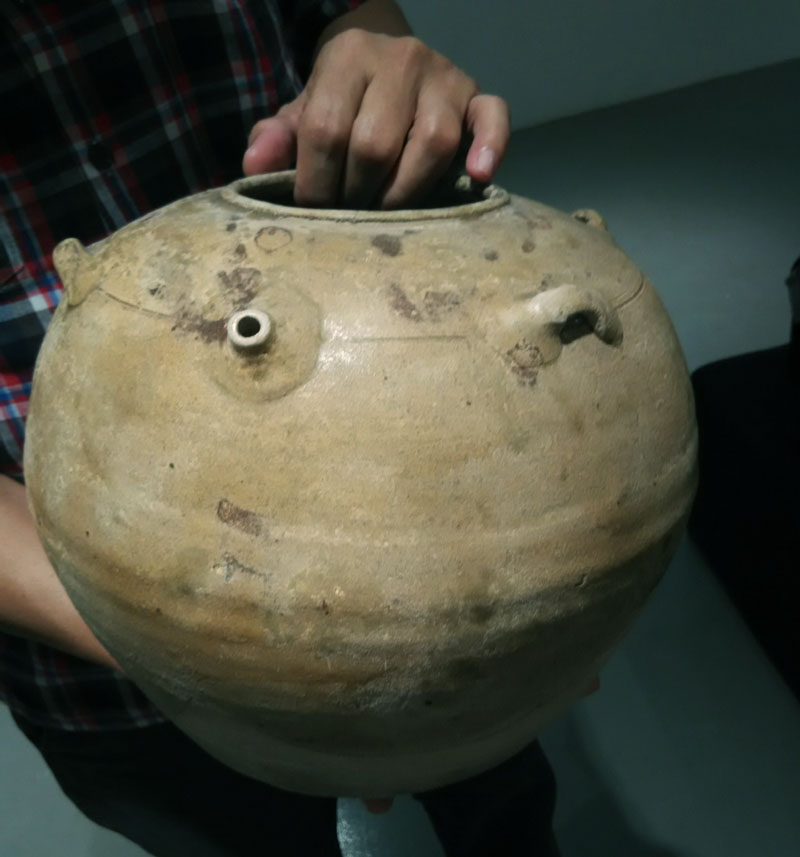 |
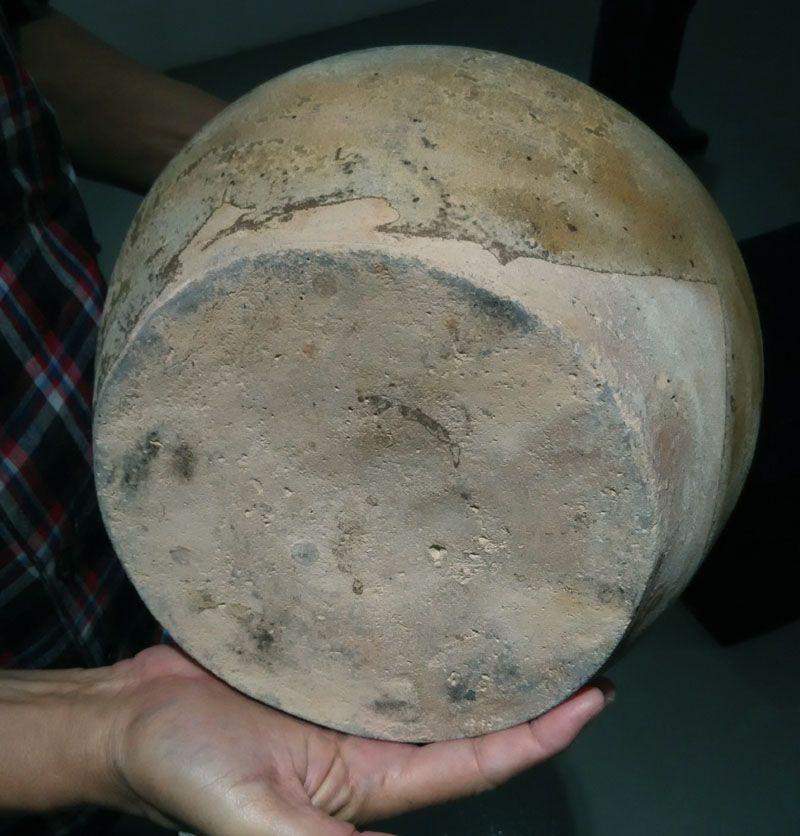 |
| Guangdong Jar from Belitung wreck | |
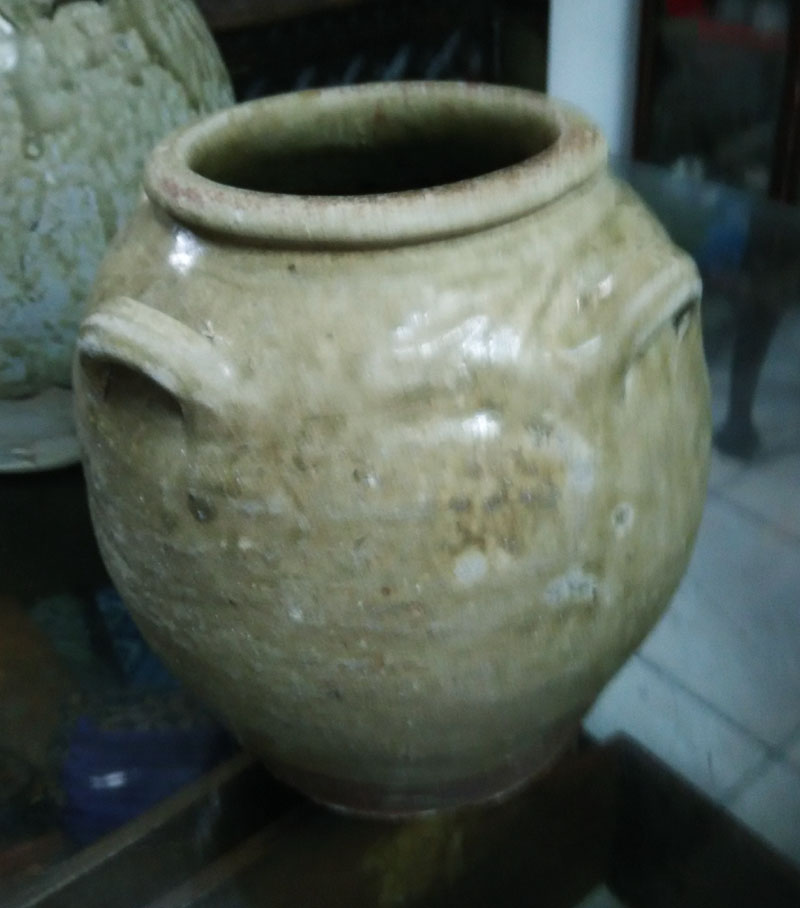 |
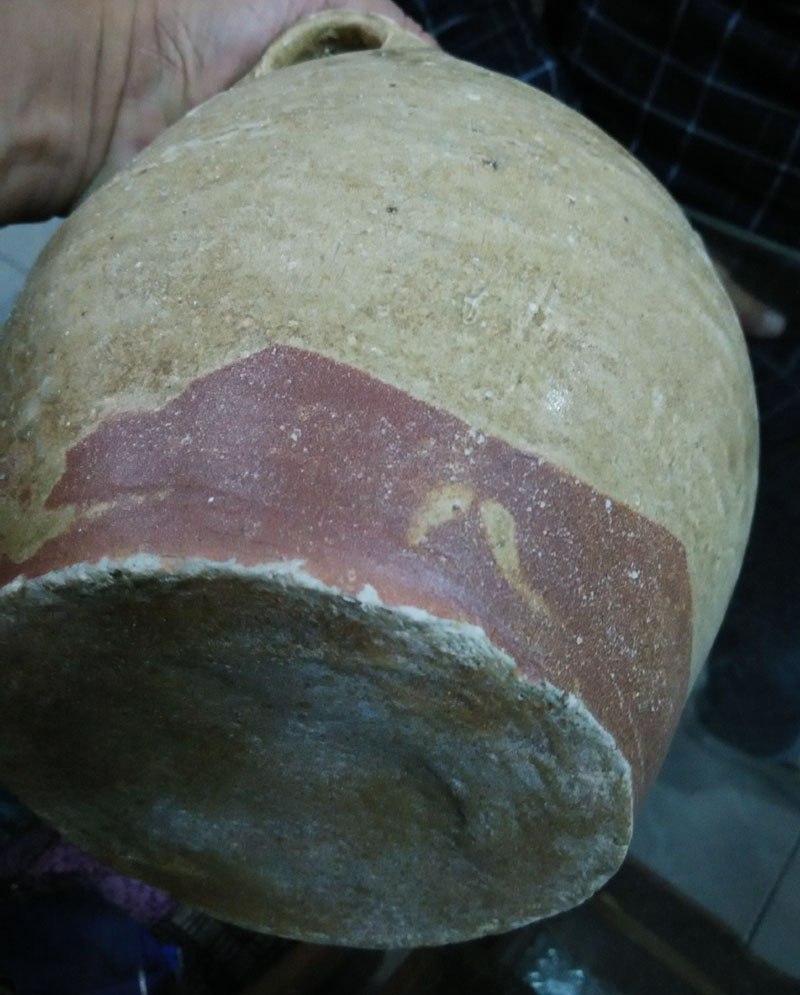 |
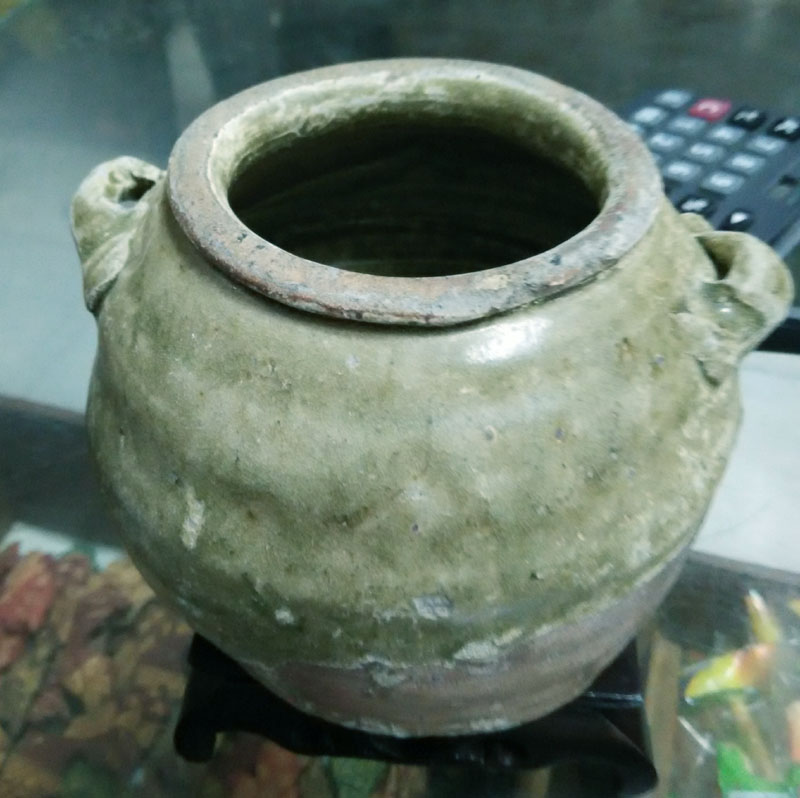 |
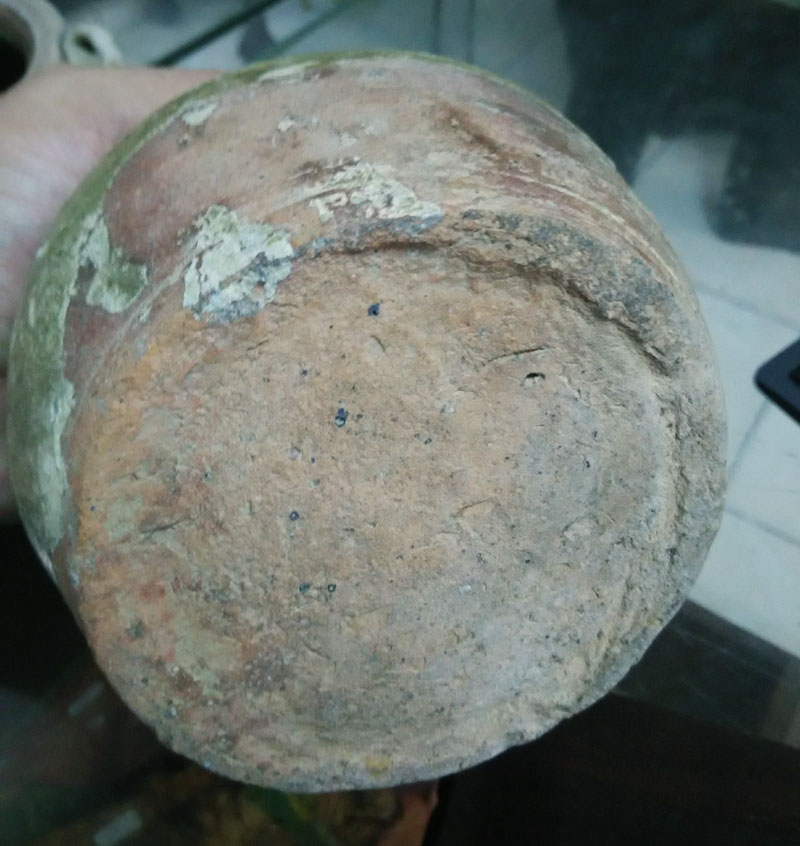 |
| Guangdong Green glaze jars found in Indonesia | |
Besides jars, Guangdong kilns also exported other vessels such as bowls, dishes, basins, ewers and etc. Two examples of bowls recovered from the Indonesia Palembang Musi rivers are shown below:
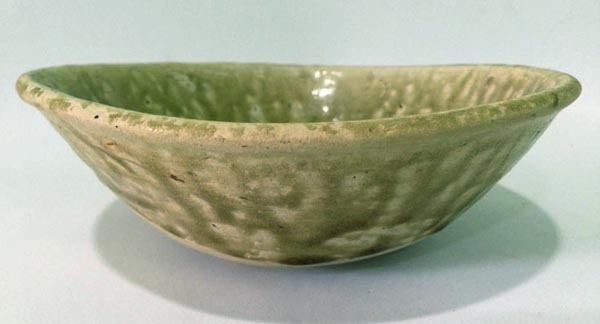 |
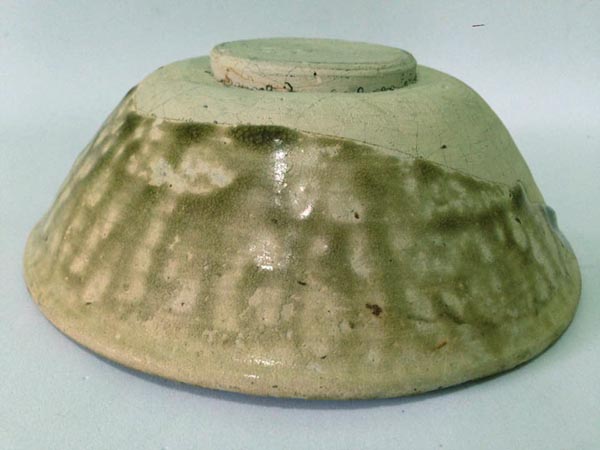 |
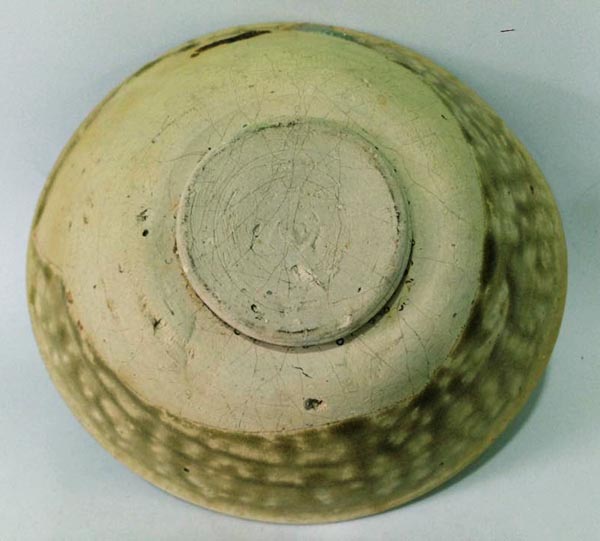 |
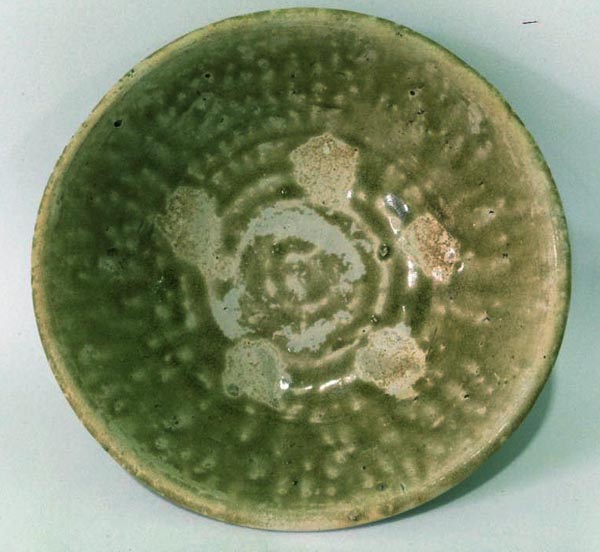 |
| Celadon bowl recovered from Indonesia Palembang Musi river. A distinctive feature of such bowls from Guanchong and the neighboring kilns such as Gaoming/Heshan is the patches left by clays lumps used as separators for stacking of bowls during firing. | |
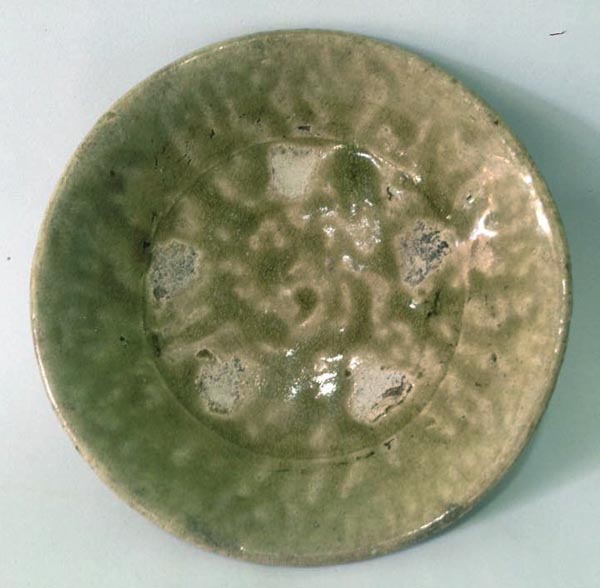 |
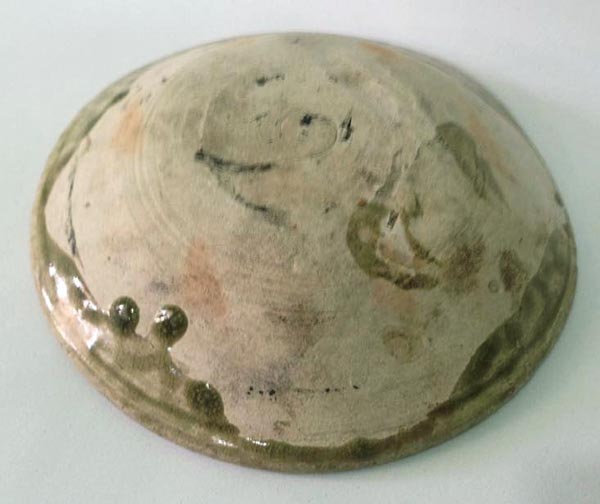 |
 |
A dish-shaped vessel from Guanchong or nearby kiln |
 |
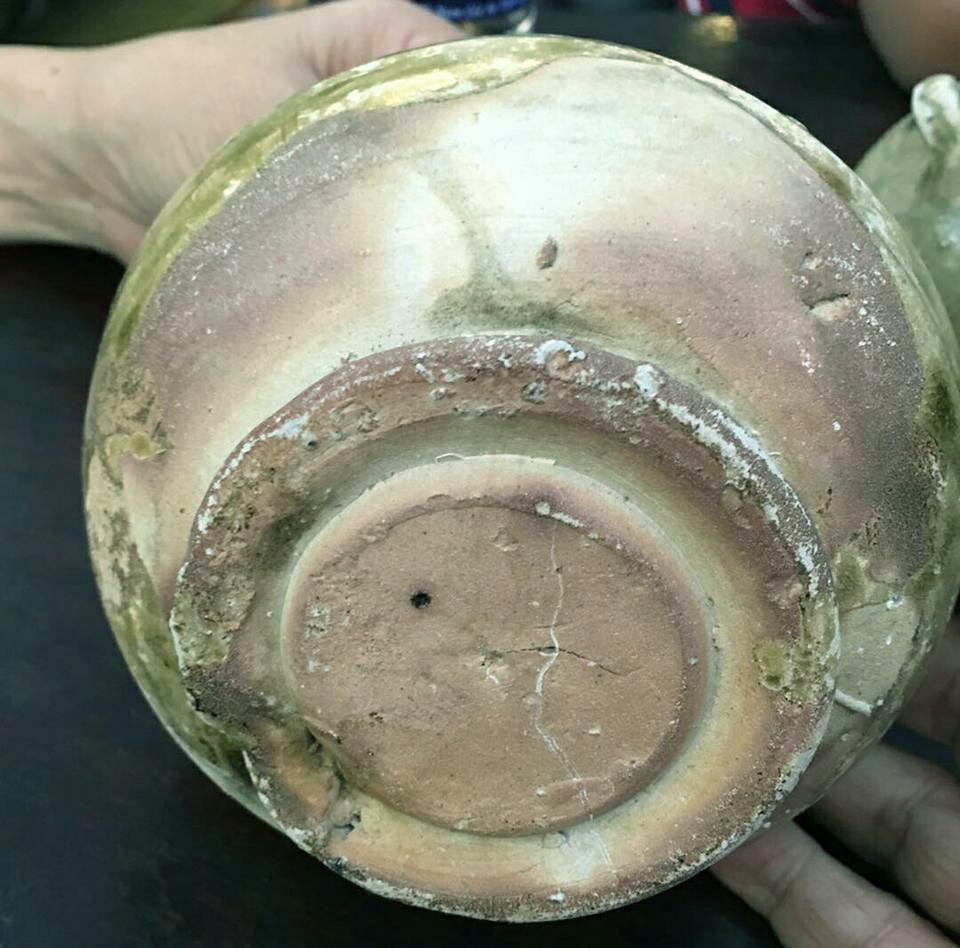 |
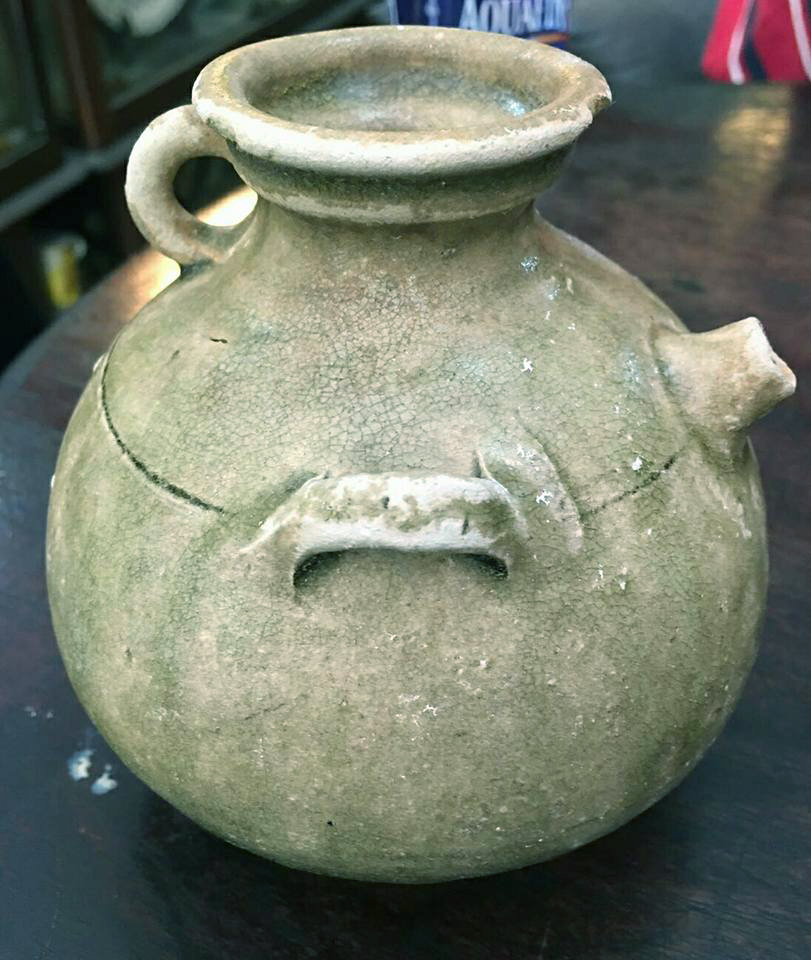 |
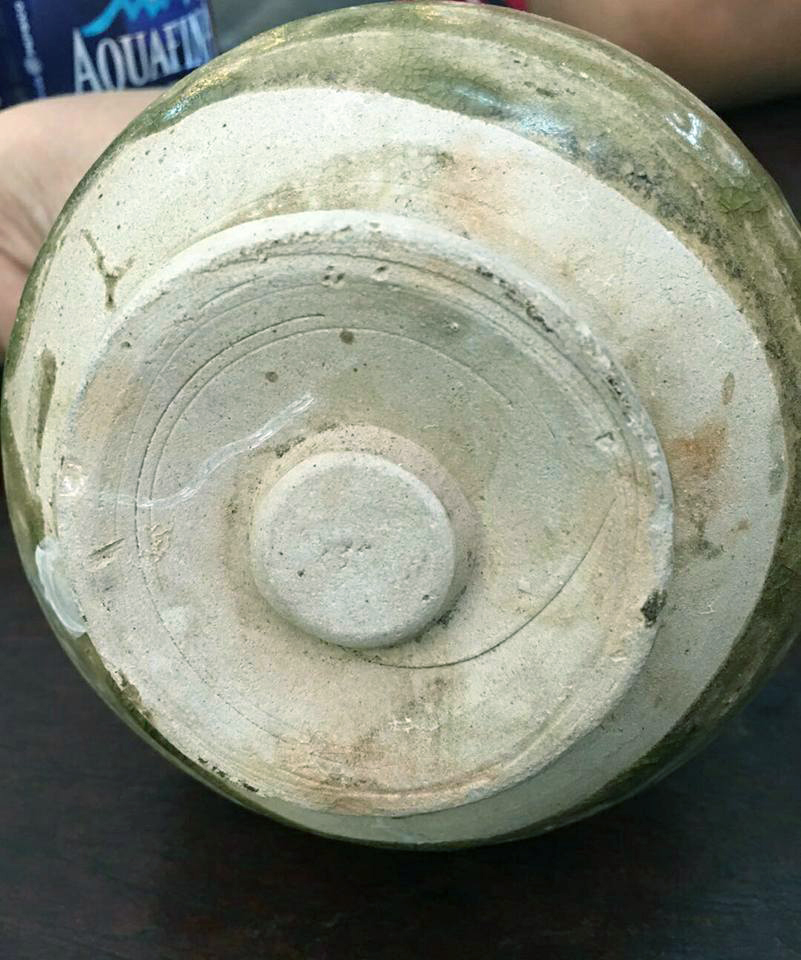 |
| Two Tang Guangdong ewers from a Vietnam wreck | |
In 2017 I was able to make a study trip to Guangdong to visit some of the kiln sites and museums. We had to opportunity to view and handle some of the Guanchong greenwares recovered from the kiln site in the Xihui Museum. Below are some of the pieces:
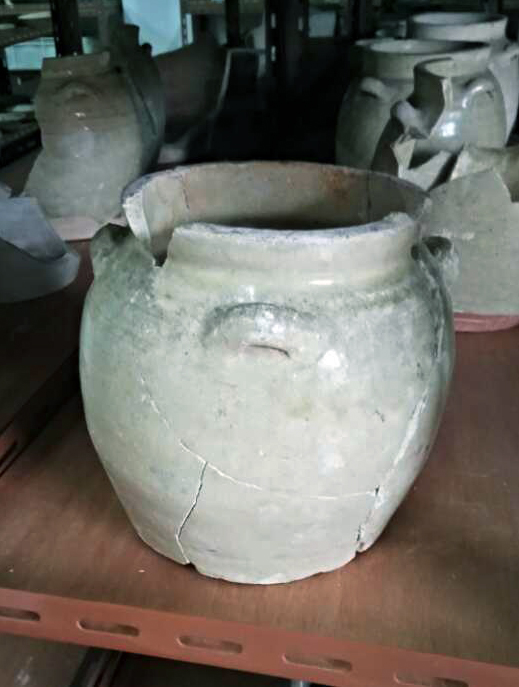 |
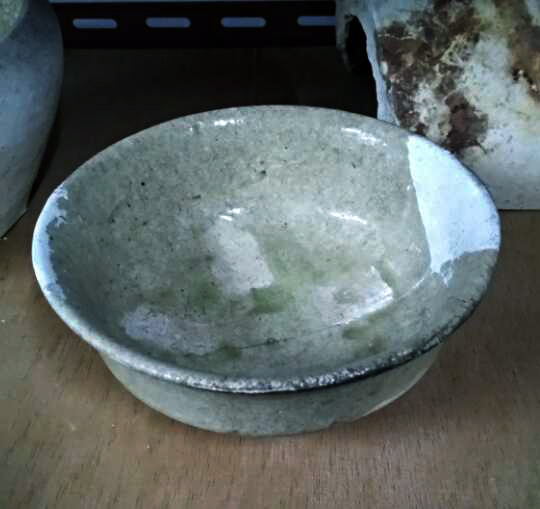 |
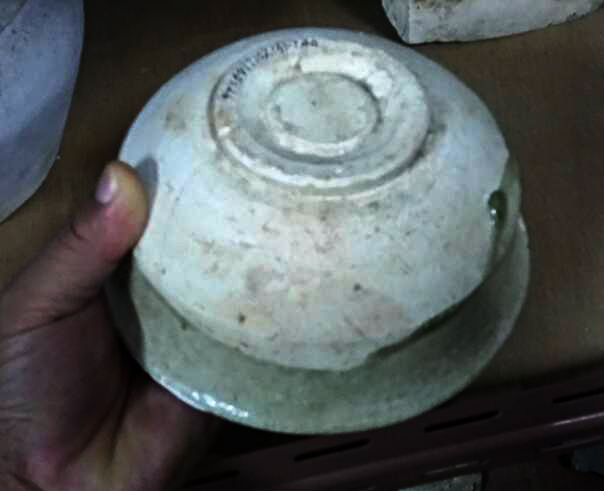 |
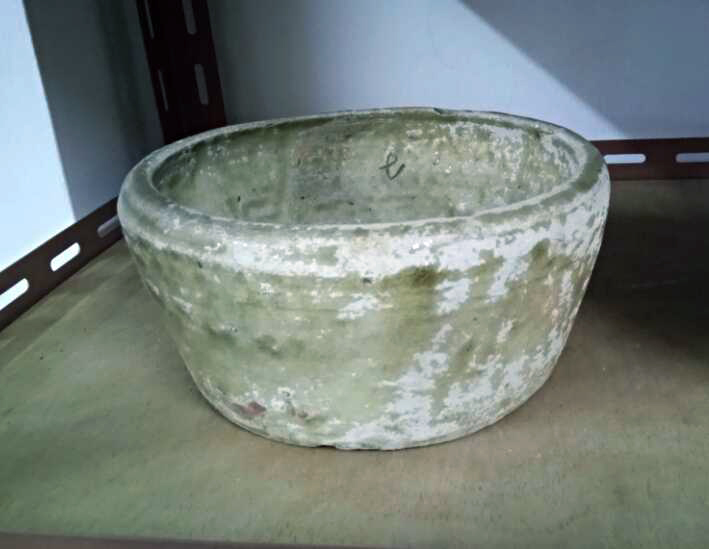 |
 |
 |
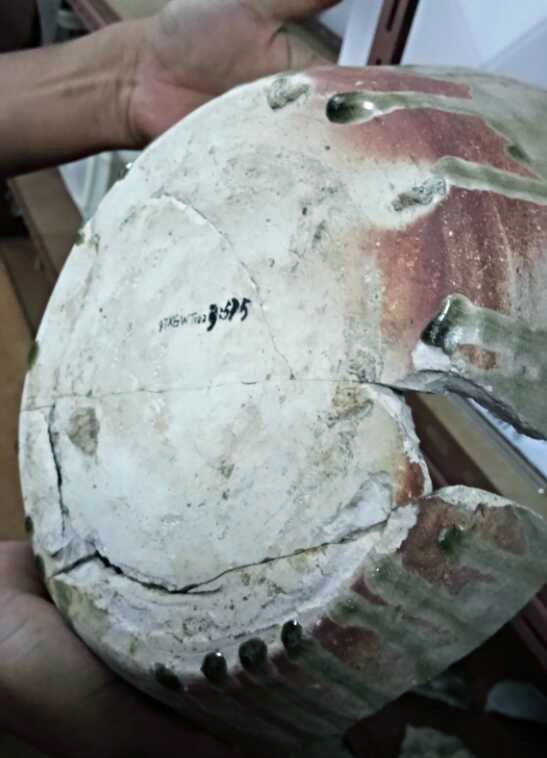 |
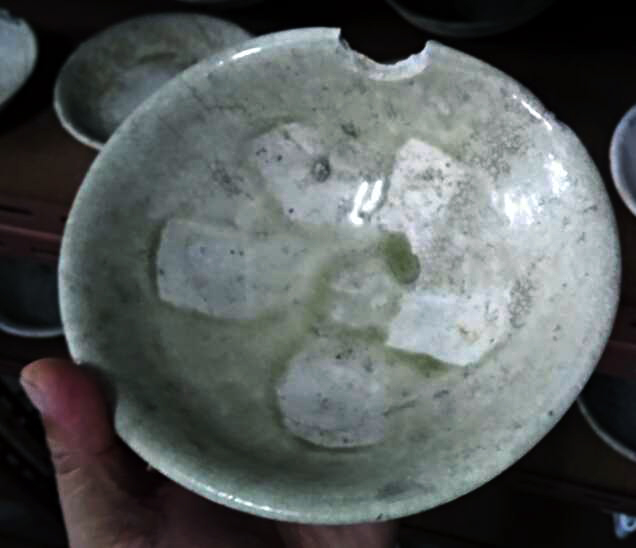 |
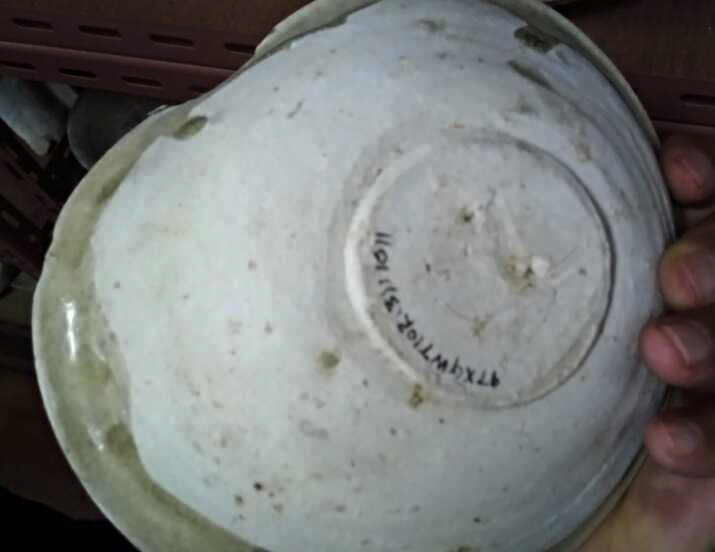 |
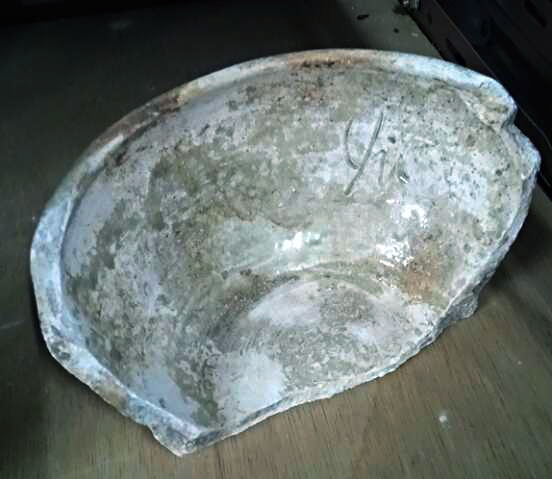 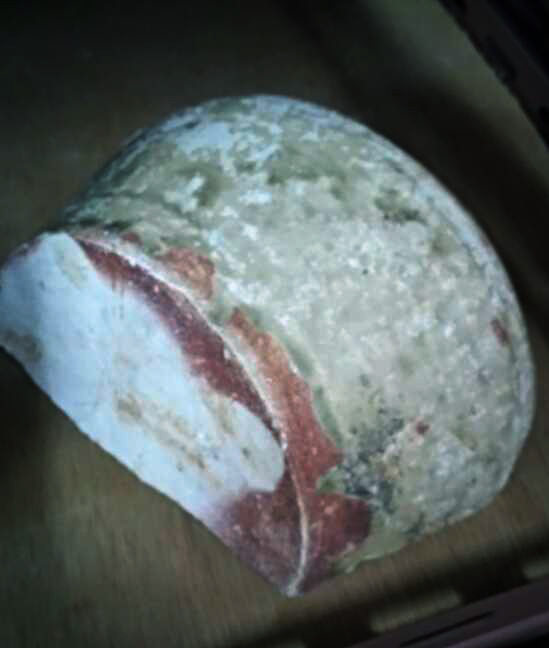 |
| Some examples of Guanchong greenware in the Xinhui Museum |
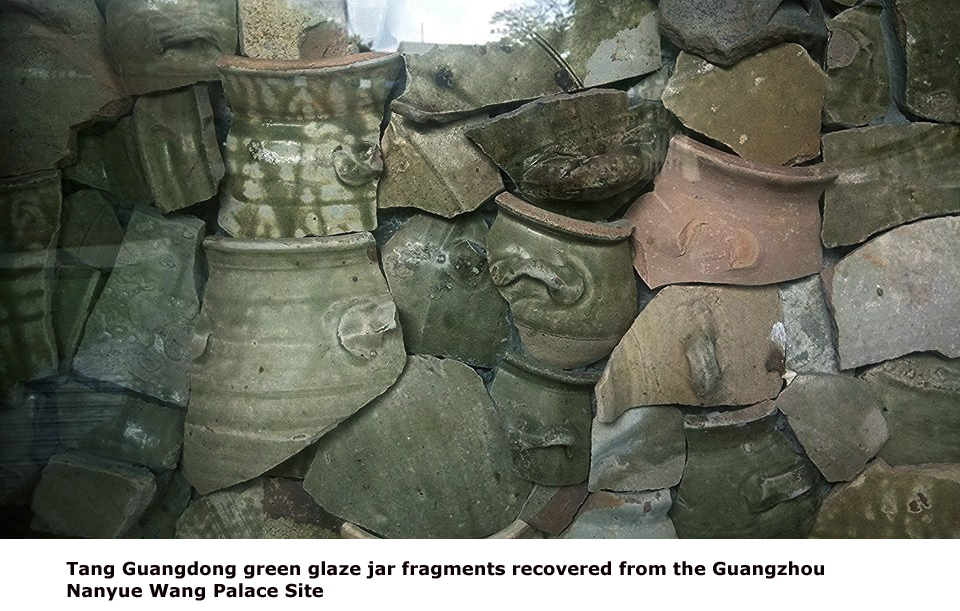
In 2018, excavation was carried out at Guangzhou Panyu Zengbian kiln (番禺曾边窑). The green glaze vessels found were similar to that from Guanchong kiln but have deeper green colour and more grayish paste. It is likely that some of the Guangdong green glaze wares from Belitung could be from this kiln. Incidentally, an ancient habitation site was excavated in Guangzhou near Zhongshan 6 road which is a short distance west of the Fanfang (番坊). Significant number of green glaze jars and bowls were found in the Tang stratigraphic layer.
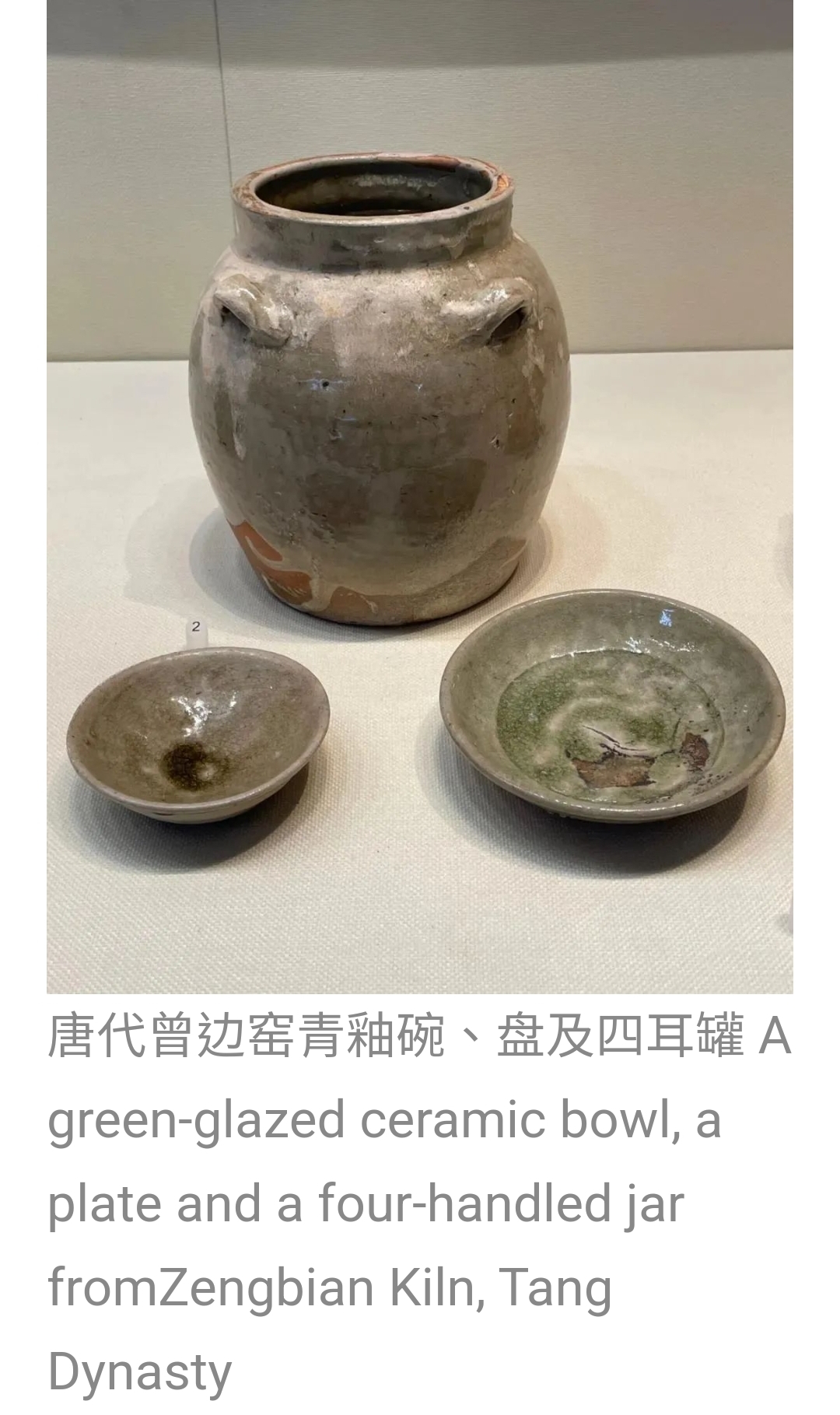 |
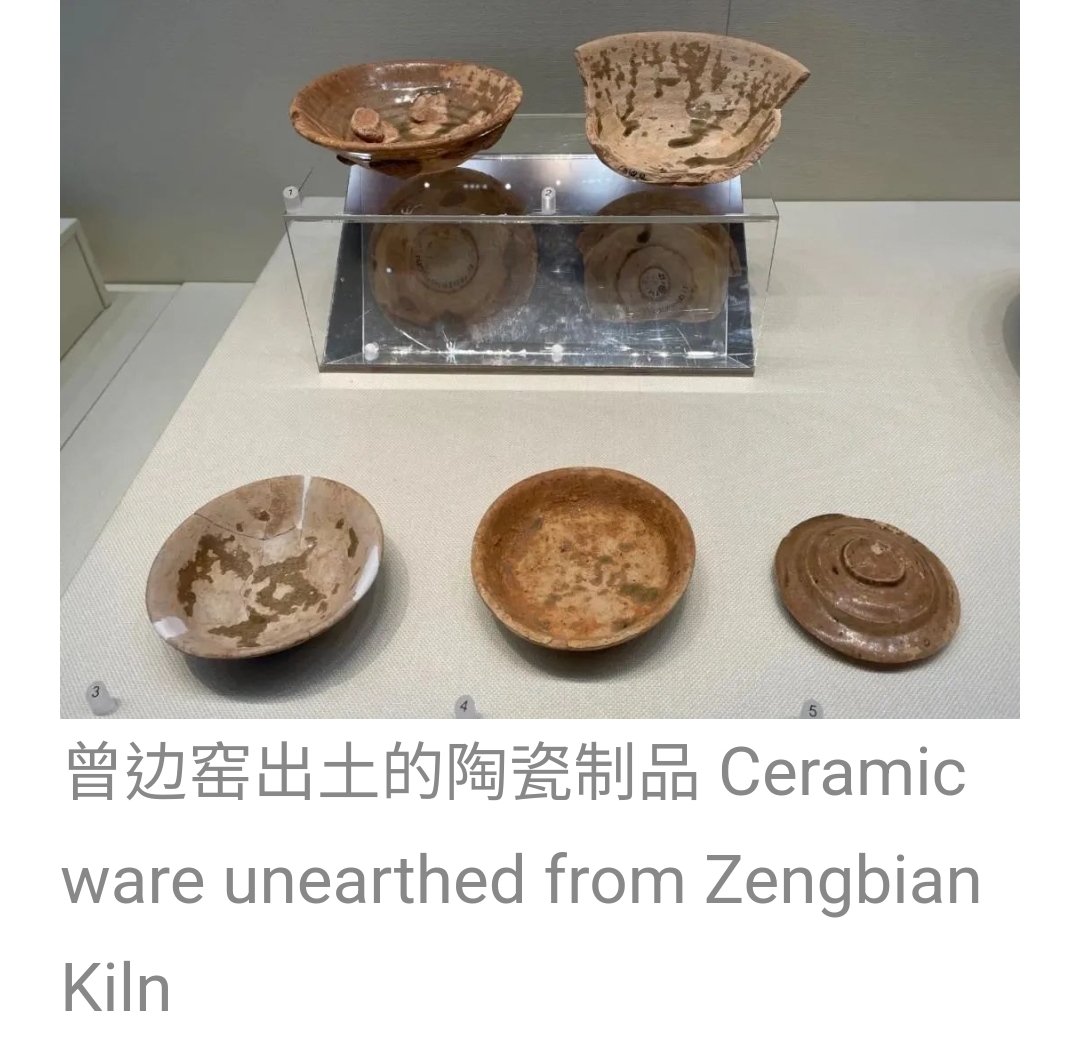 |
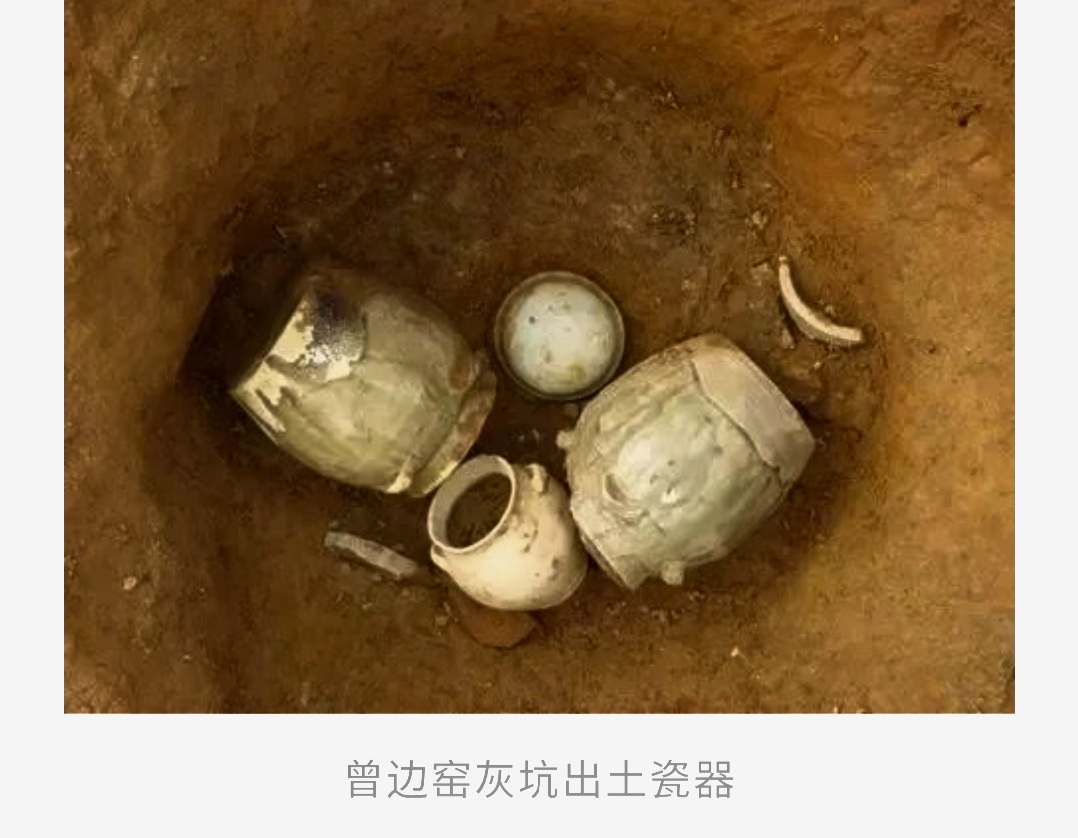 |
| Tang green glaze wares from Guangzhou Panyu Zengbian kiln |
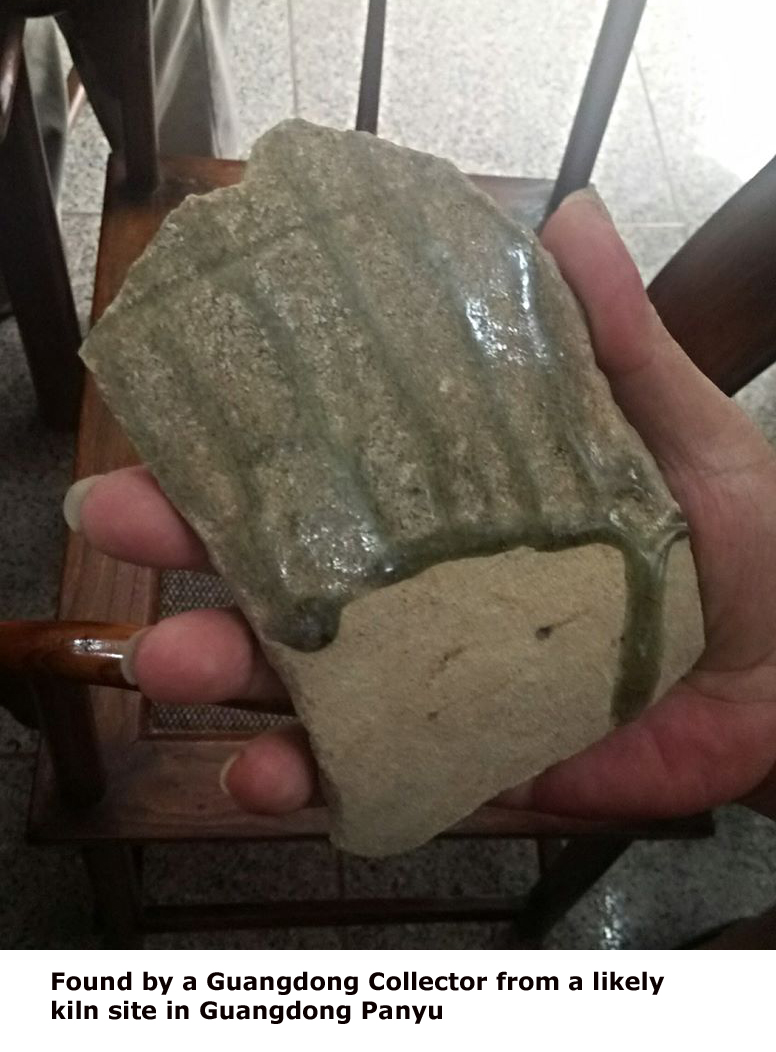 |
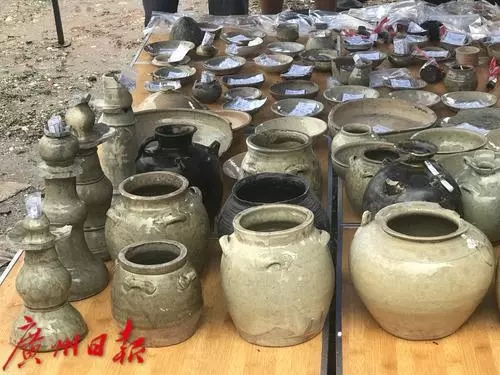 |
| Green glaze wares recovered from the Tang stratigraphic layer in an ancient habitation site in Guangzhou |
Archaeological excavations revealed that the best quality Guangdong greenwares were produced in kilns in Chaozhou Beijiao (潮州北郊) , Chaozhou Beiguan (潮州北关) and Meixian shuiche (梅县水车). Some Chaozhou vessels were found in the Tang Belitung wreck. The glaze of Chaozhou celadon is thicker and glassier than those found on Yue celadon and usually have fine crackles. Products from Meixian and Chaozhou kilns, which were located near the Hanjiang river (韩江), were transported down the river to the Chaozhou port.
During the Chinese economic boom of the last few decades, Hanjiang river was dredged for sands required by the Chaozhou building industry. Together with the sand, sizeable quantity of Meixian and Chaozhou celadon wares were recovered. Most of them were intended to be transported to the Chaozhou port but were discarded most likely because of damages or ended up in the river because of sunken vessels.

|
Chaozhou celadon wares from the Belitung wreck. The typical Chaozhou bowl has 3 unglazed patches on the foot |
Chaozhou celadon wares in the Chaozhou shi
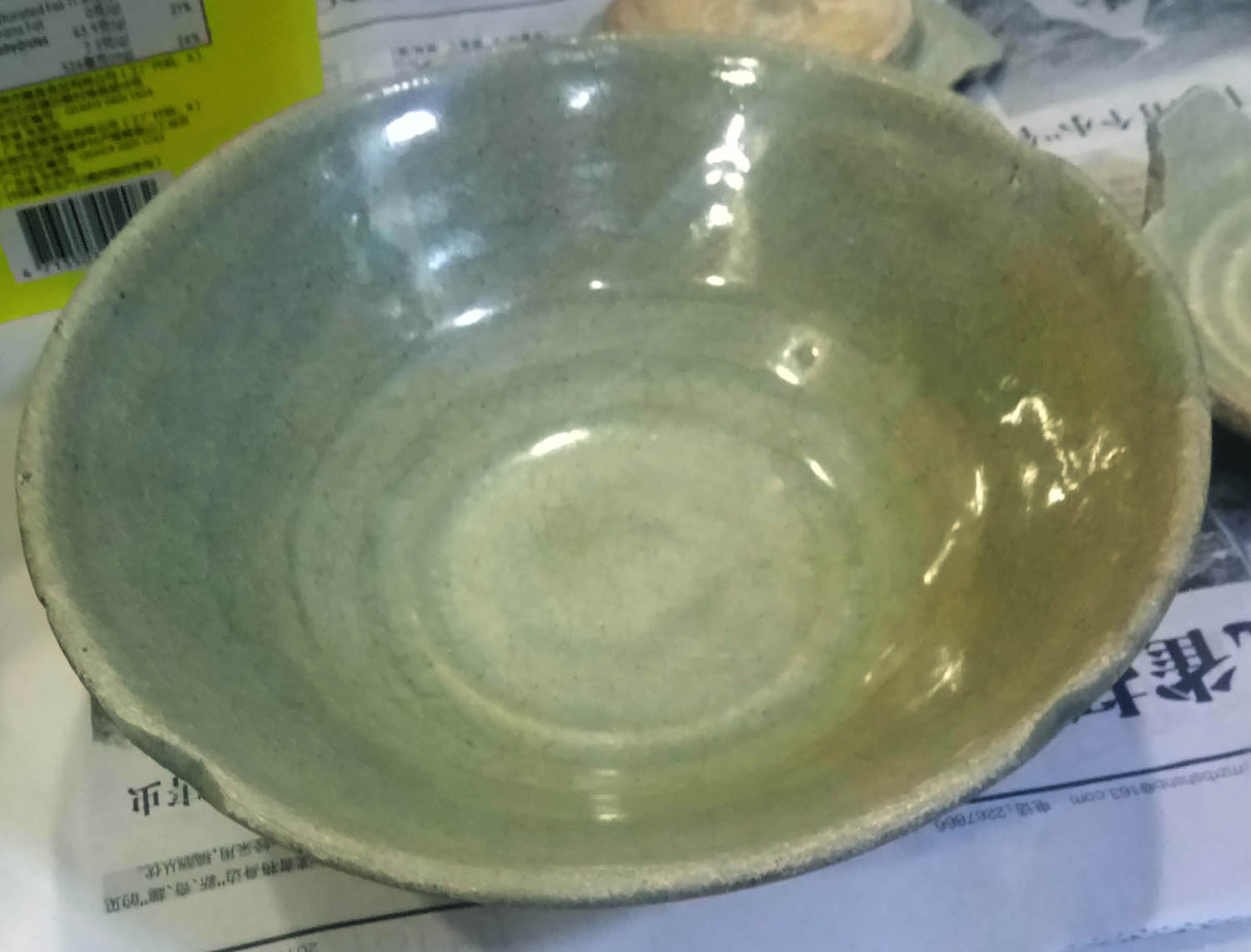 |
 |
|
Bowl from the Meixian Shuiche kiln |
 |
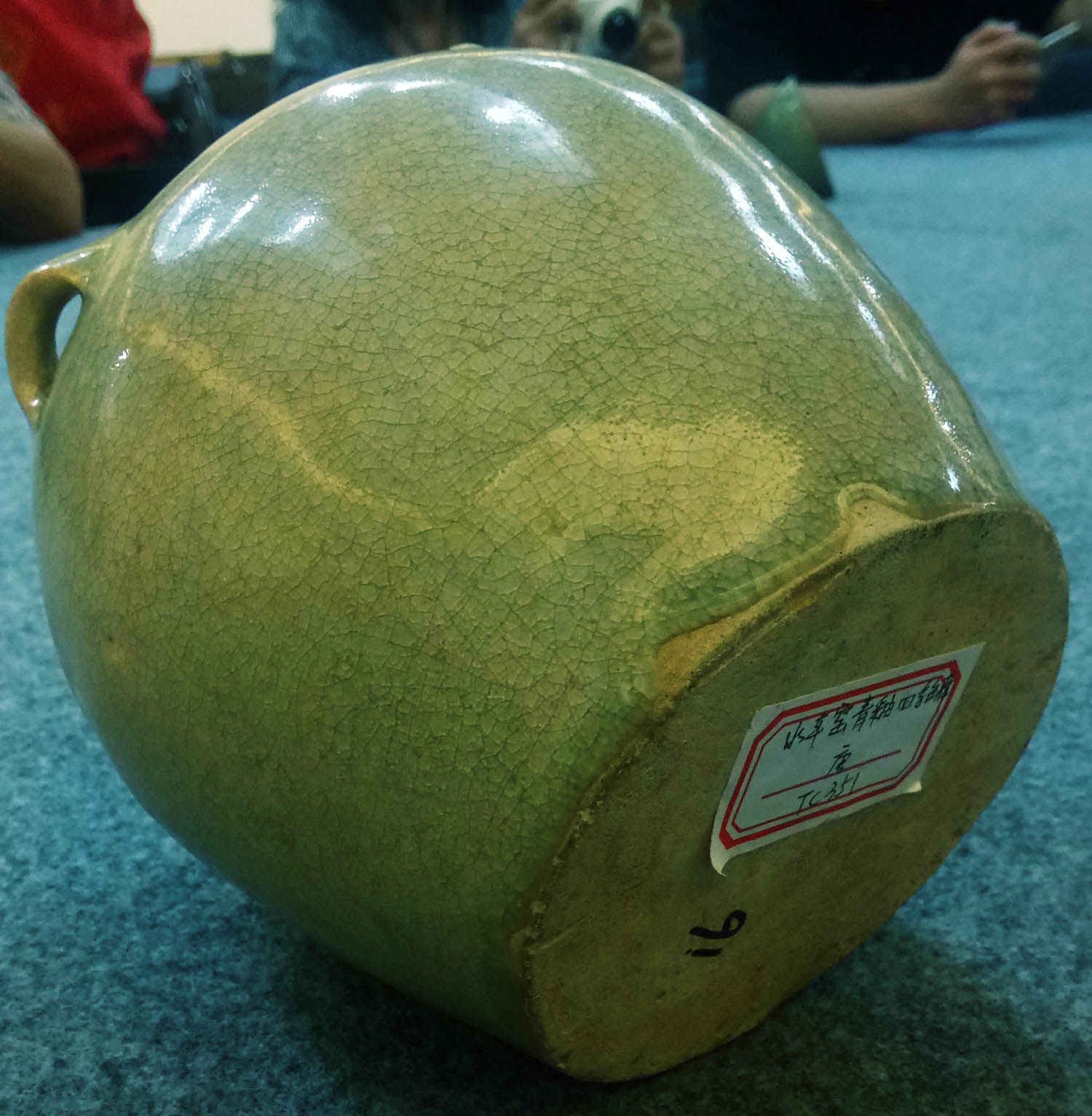 |
| Tang Meixian Shuiche Jar |
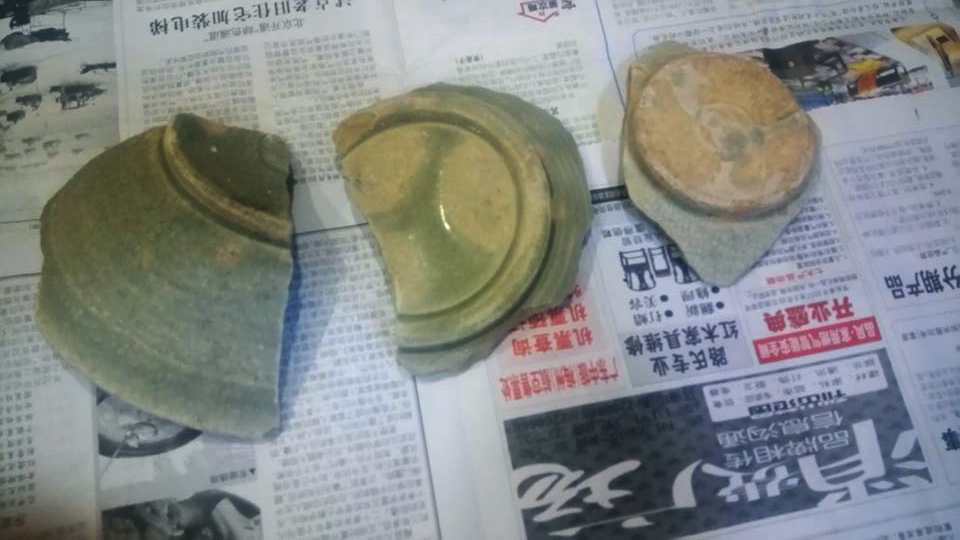 |
| Some samples of the foot of bowls from Meixian kiln |
Song Guangdong Ceramics
The Northern Song regime was relatively weak and the North/Northwest region was frequently troubled and raided by nomadic tribes. The constant unrest disrupted the flow of goods along the overland silk route. Foreign trade was an important source of revenue for the court. Hence, special attention was paid to implement policies and measures to stimulate and promote the maritime trade. Mingzhou was established as the gateway for trade with Korea and Japan and Guangzhou for Southeast Asia and further west to India and the Middle East. In 971 A.D, the Song government established an Office of Maritime Trading in Guangzhou. Its main roles were to collect tax, administer and regulate the flow of import and export of goods. Guangzhou port maintained its dominant position until the end of Northern Song period. It was displaced by Fujian Quanzhou when northern China fell to the Jin and the Song imperial family fled and established its court in Hangzhou. Quanzhou was designated as the main port of exit for trade with Nanhai and the West.
The traditional Guangdong green glaze vessel is typically more coarse paste and has the runny patchy snake skin-like glaze appearance. Many utilitarian wares, especially jars of varied dimension were produced in kilns situated in the Pearl river delta and exported since the Tang Dynasty. During the Tang period, the glaze is more light green or green in colour tone. By the Northern song period, it generally has a more brownish green hue and majority fired at a lower temperature. As a result, it has poorer glaze vitrification and tends to flake easily. Many from the shipwrecks suffered from severe degradation with the body almost totally denuded of the glaze. The most common vessel forms consisted of jar, ewer and basin. A significant number of the vessels are decorated with impressed flowers in various arrangement. There are some other rarer designs such as dragon and phoenix. I have seen one in a Philippines collection which has an impressed twin phoenix which is stylistically very similar to the incised version found on Yue ware. From the known shipwrecks, it can be determined that traditional Guangdong green glaze ware remained a staple in the cargo till end of Northern Song period.
In the Lingga wreck, there are many brownish green glaze basin-shape vessels with impressed flower. Such items are products of the Xicun kiln. The Pulau Buaya wreck also carried some quantity of such vessel.
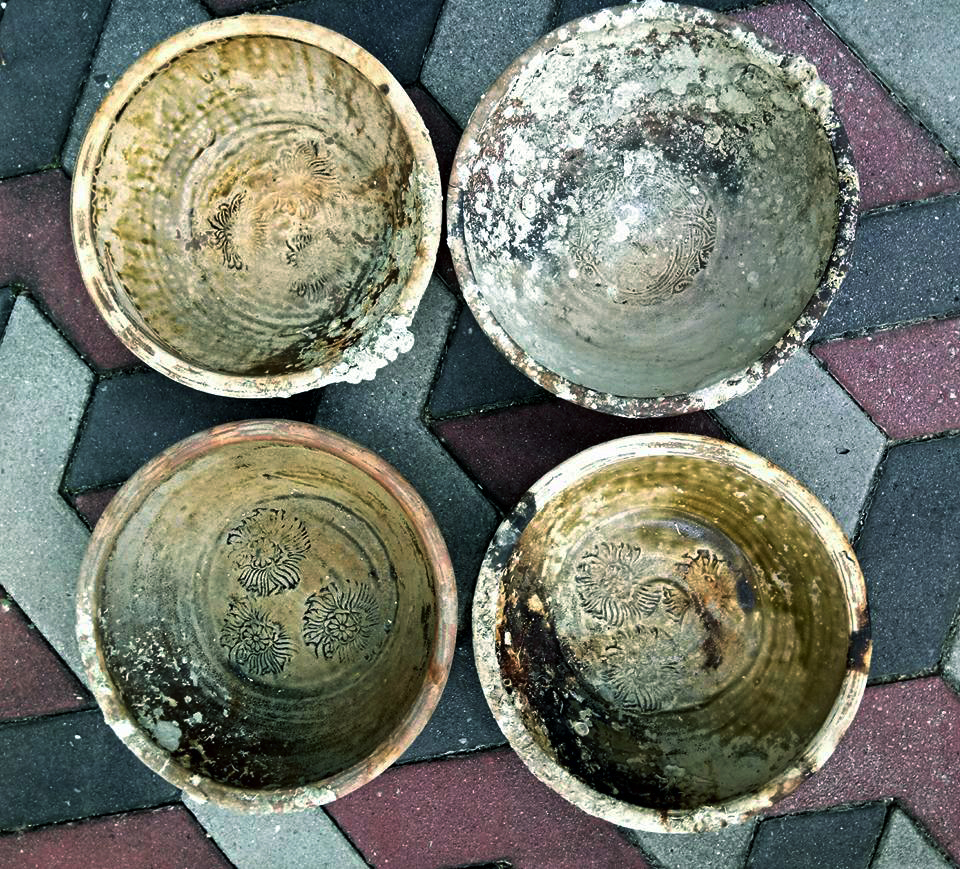 |
| 3 Green glaze basins with impressed floral and one with dragon decoration from the Lingga wreck |
|
|
| 3 ewers from a wreck near Pulau Buaya in the Lingga Archipelago. There are still some remnant traces of the glaze on the ewers which display typical Guangdong physical glaze characteristic. The two ewers on the right were found in large quantity in several wrecks and many habitation and burial sites in Southeast Asia. For the ewer on the left, it is a kendi form particularly popular in Southeast Asia. Similar form with unglaze creamy paste were believed to be produced in Satingphra in Southern Thailand. |
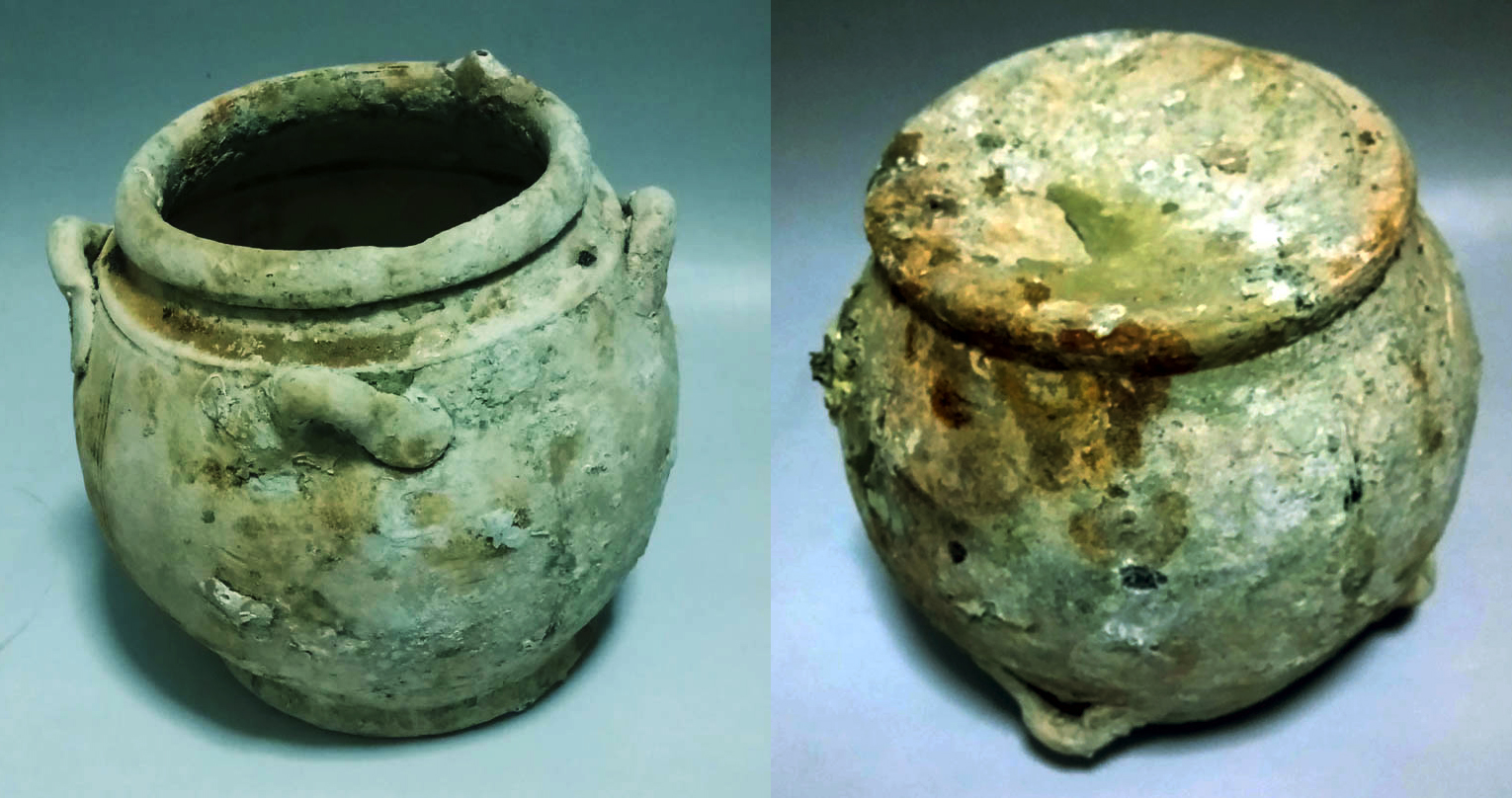 |
| This jar with lugs on the shoulder is another classic Guangdong utilitarian ware which was produced since the Tang period. The form has basically remained similar and continued to be demanded during the Northern Song period. |
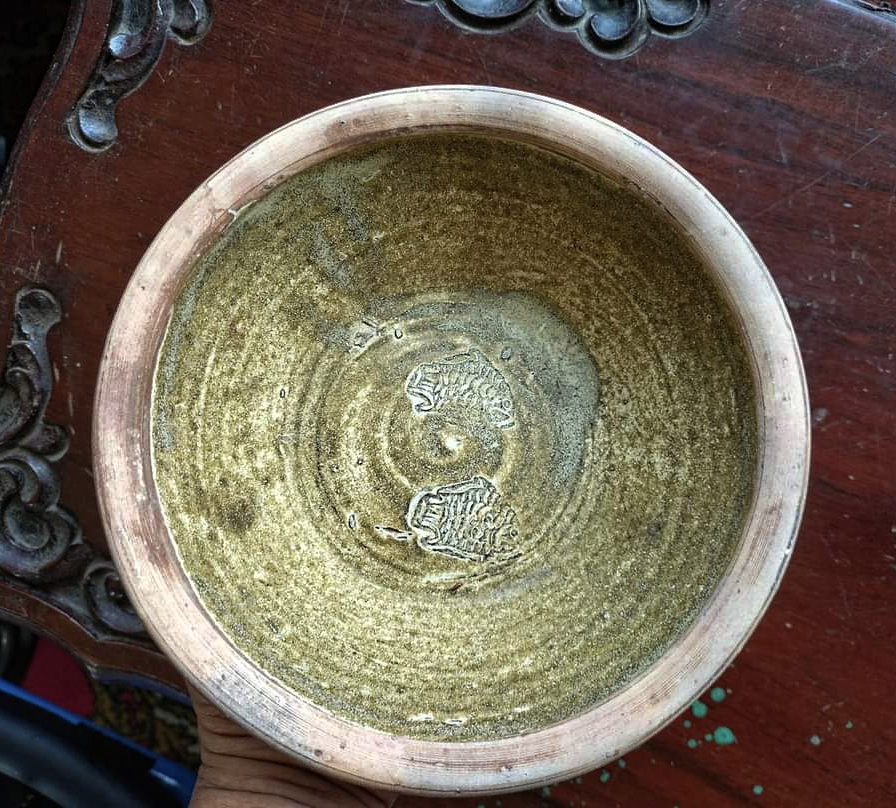 |
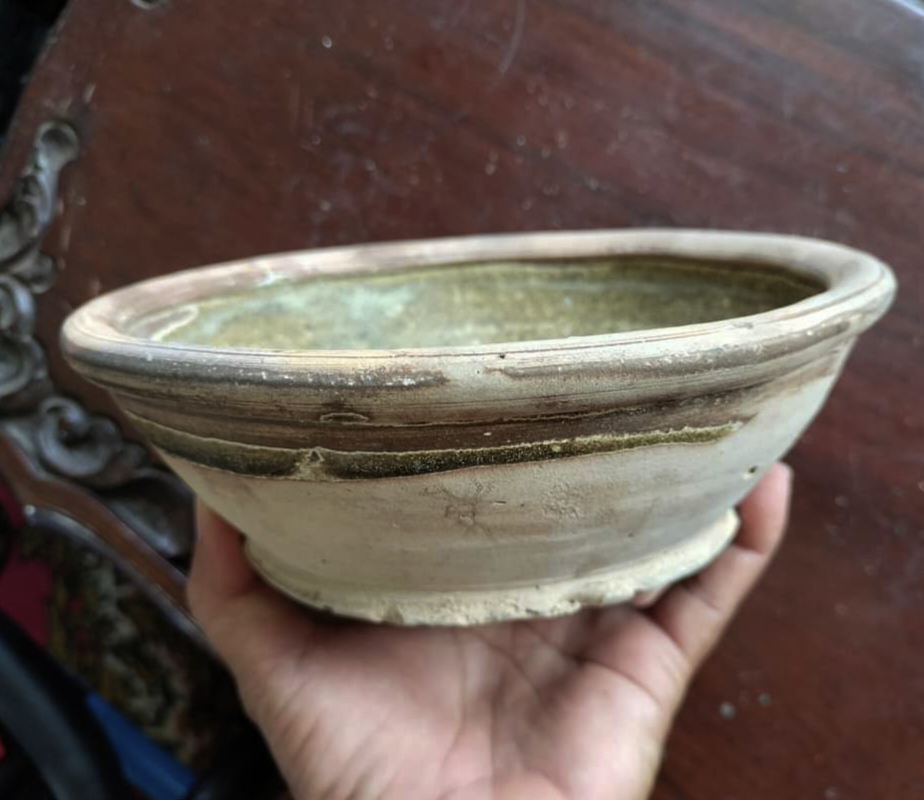 |
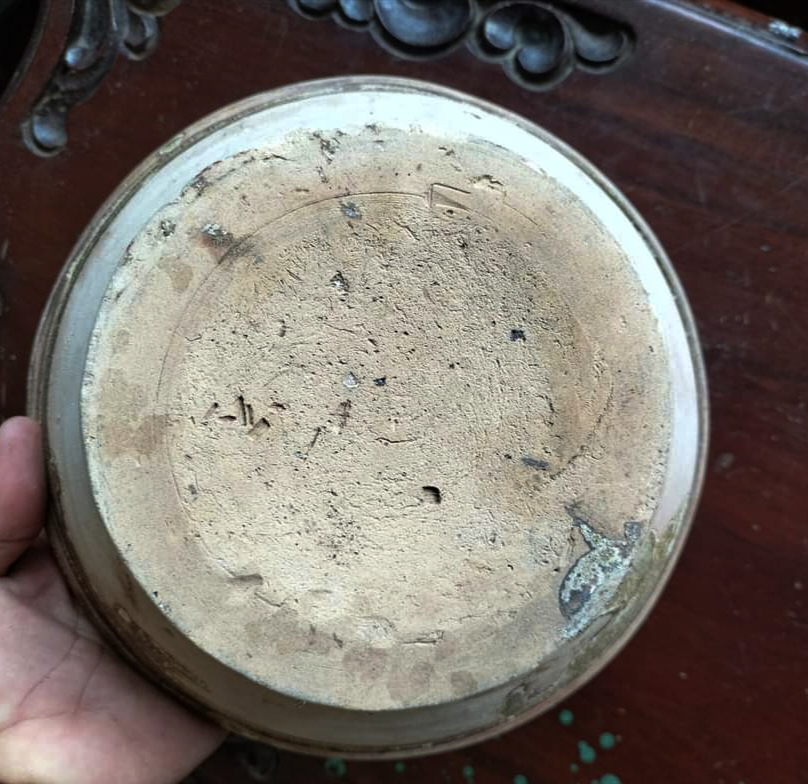 |
| Basin with impresed fishes motif. Recovered from river in Sumatra. |
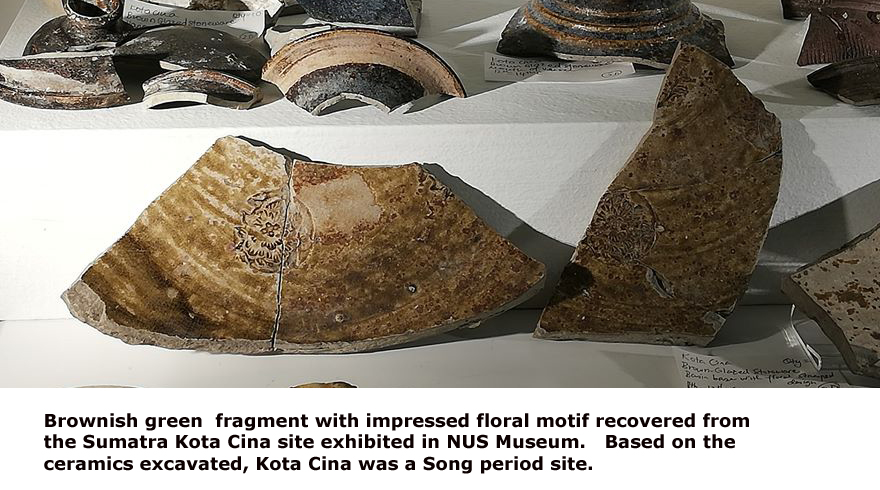
The glaze of majority of the shipwrecked Guangdong traditional green glaze wares suffered substantial degradation and it is rather hard to imagine its original look. Fortunately I was able to take photos of excavated pieces found in the Philippines location collections , chiefly the Bautista collection and the Ching Ban Lee gallery.
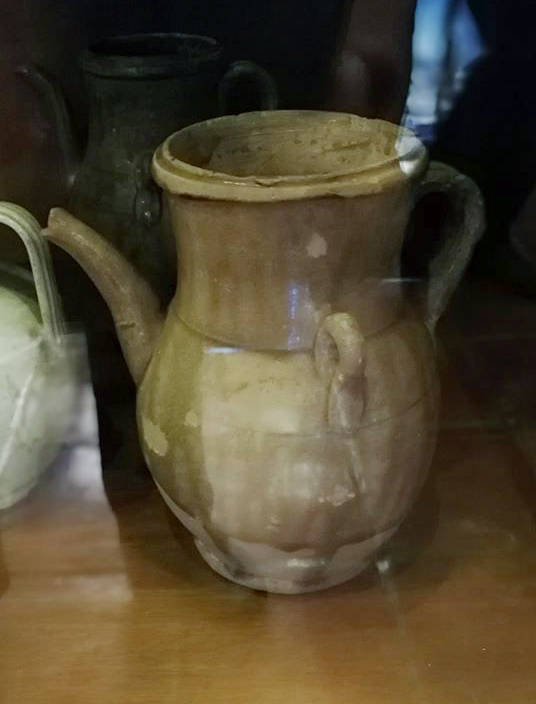 |
 |
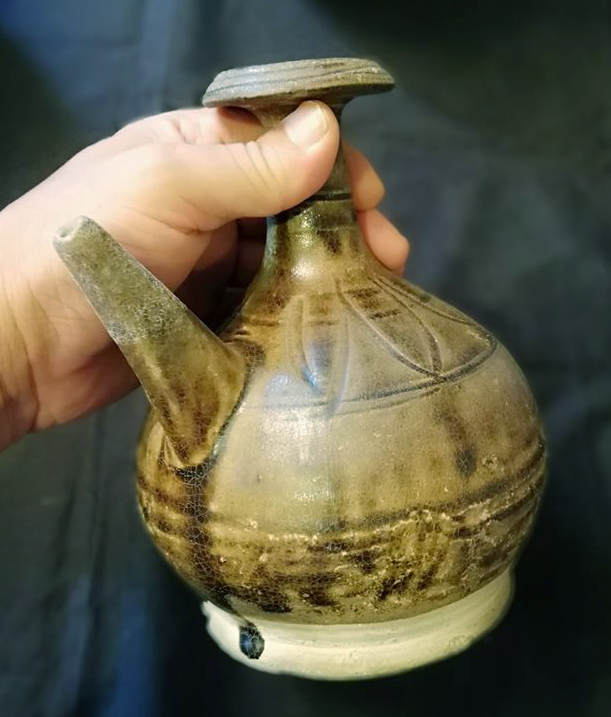 |
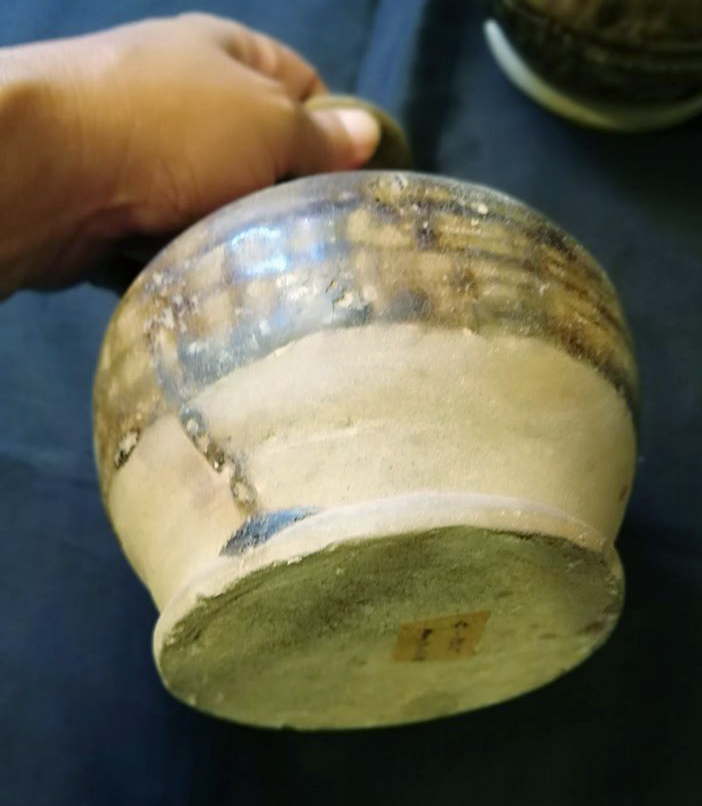 |
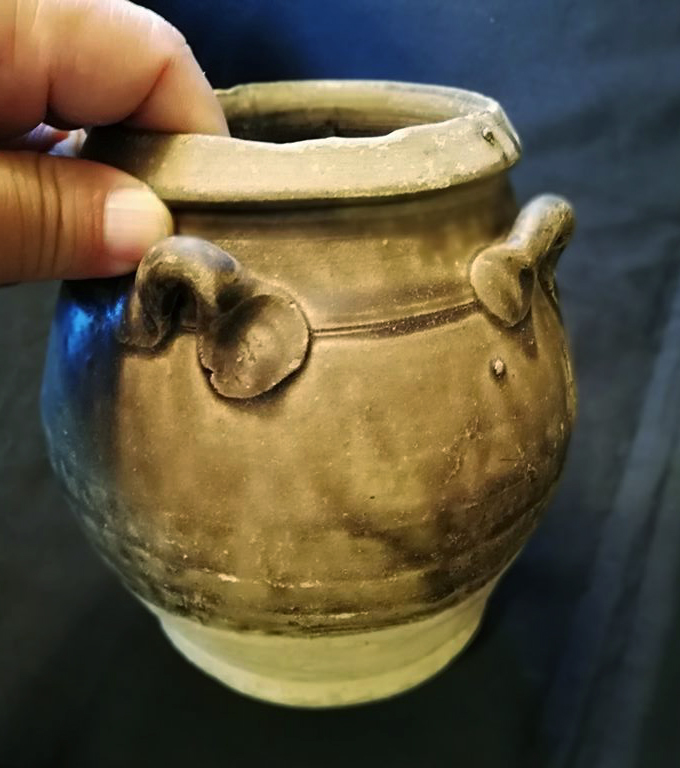 |
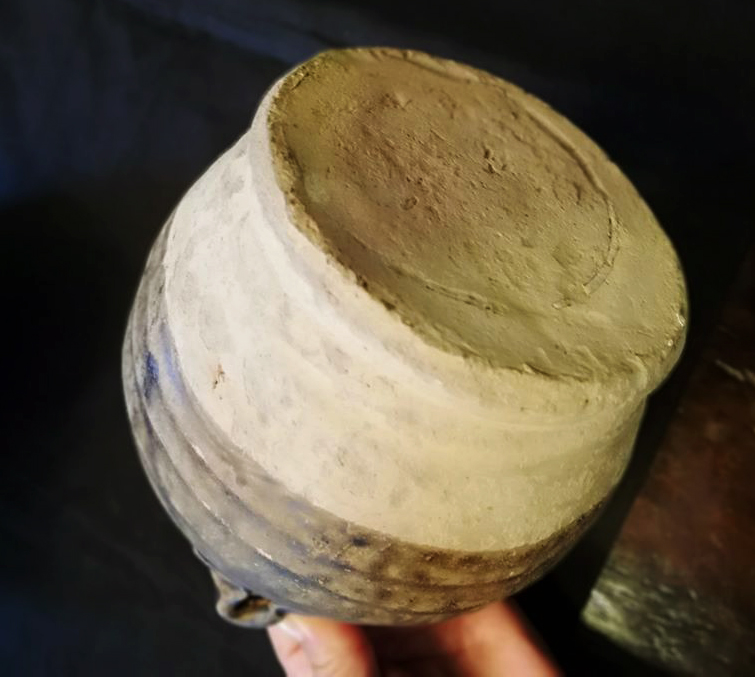 |
| Good condition excavated Guangdong Traditional green glaze wares from the Bautista Collection |
 |
 |
| Examples on display in the Ching Ban Lee Gallery |
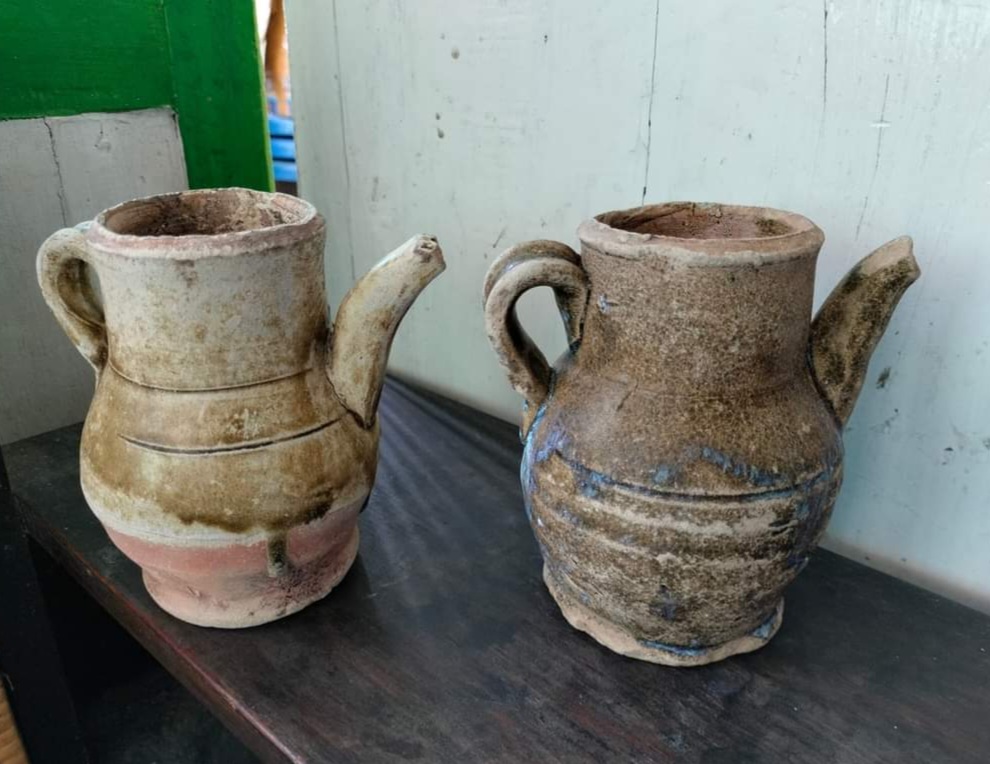 |
 |
| Two examples found in Sumatra |
In the Lingga wreck, there are also some brownish green jars but most with the glaze missing. They share common characteristics in term of glaze and paste with the Xicun basin and could also be from Xicun or Qishi kiln.
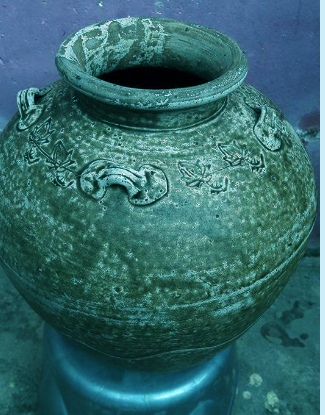 |
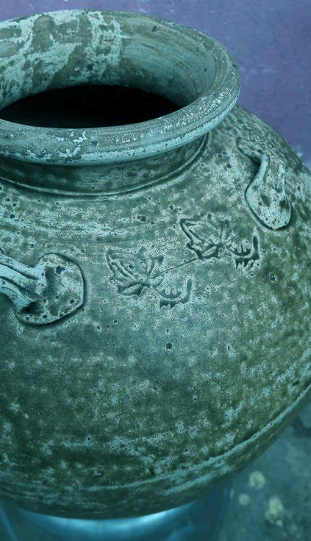 |
| Green glaze jar with impressed floral motif on the shoulder. This is another popular form and enjoyed a long duration of demand. The flower is stylistically similar and glaze indistinguishable from those on the Xicun basin. One kiln which is positively identified as producer of such jars is Nanhai Qishi kiln (南海奇石窑). Many such jars were found in several of the wrecks in the Lingga Archipelago which attested to its popularity in Southeast Asia. |
In the Pulau Buaya wreck, there were some quantity of big storage jars with brownish green glaze. The shoulder has impressed floral motif. Such jars could be found in many of the Southeast Asian ceramics collections. They are products from the Nanhai Qishi kiln. There are also those with impressed Chinese characters such as that indicating the year of production, Zhenghe sixth year (政和六年) i.e. 1116 A.D , identifying ownership Pan Residence (潘宅) and etc. If you look at the below Qishi jar fragment, it would appear more brown than green. But the greenish tinge can still discernible.
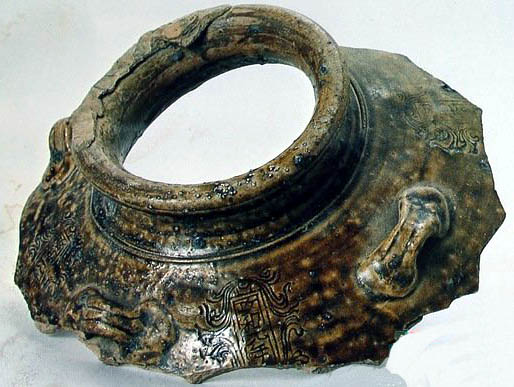 |
| Fragment of Big Jar from Nanhai Qishi kiln and with Zhenghe 6th year mark |
|
|
|
| Rubbings of the impressed markings and drawing of the storage jar based on the finds in the Nanhai Qishi kiln |
In the Lingga wreck, there is also a form of bulbous jar with brown glaze. Similar jars were found in the Pulau Buaya wreck found in 1989. They should be products from a Guangdong kiln but could not be positively link to any of the known kilns.
|
|
|
Bulbous jar with the brown glaze missing from the Riau wreck
|
|
|
|
| Bulbous jar with Yellowish brown glaze. Similar type were salvaged from the Pulau Buaya wreck. Most probably from unknown Guangdong kiln | |
In the past, it has been suggested that Xicun iron-brown painted decoration was Cizhou inspired. However, the Xicun version of the flower is stylistically very different from Cizhou. Furthermore, it has green glaze whereas Cizhou version has white transparent glaze. There were two likely sources for the proto type that this category of decoration may have borrowed from. Zhejiang Yue kilns were known to have produced a small quantity of iron-brown painted wares and more recent archaeological findings revealed that Ou kilns (瓯窑)produced a relatively large quantity of such wares. Those from the Ou kilns showed strong similarity to and likely influenced by the Tang period Changsha ware.
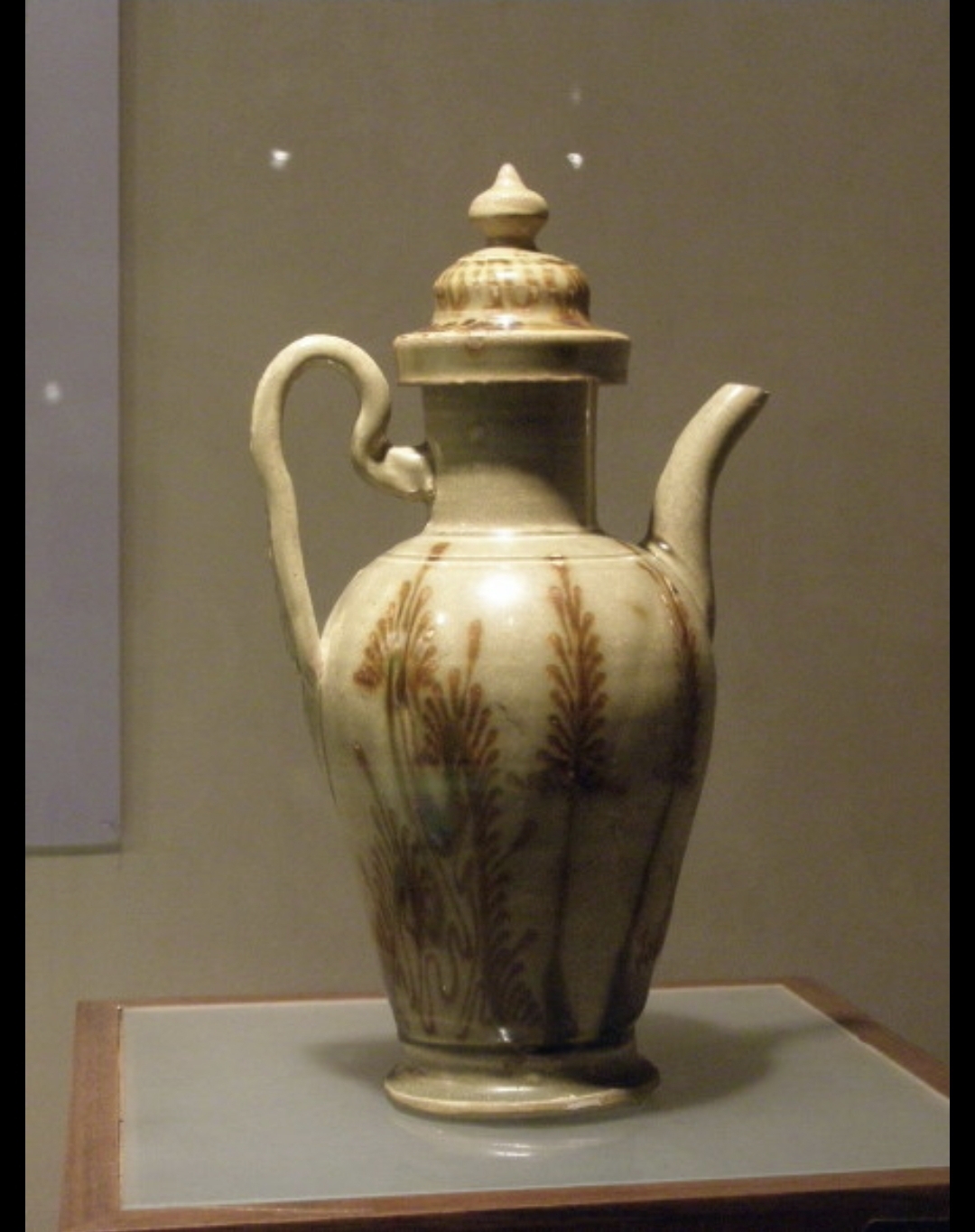 |
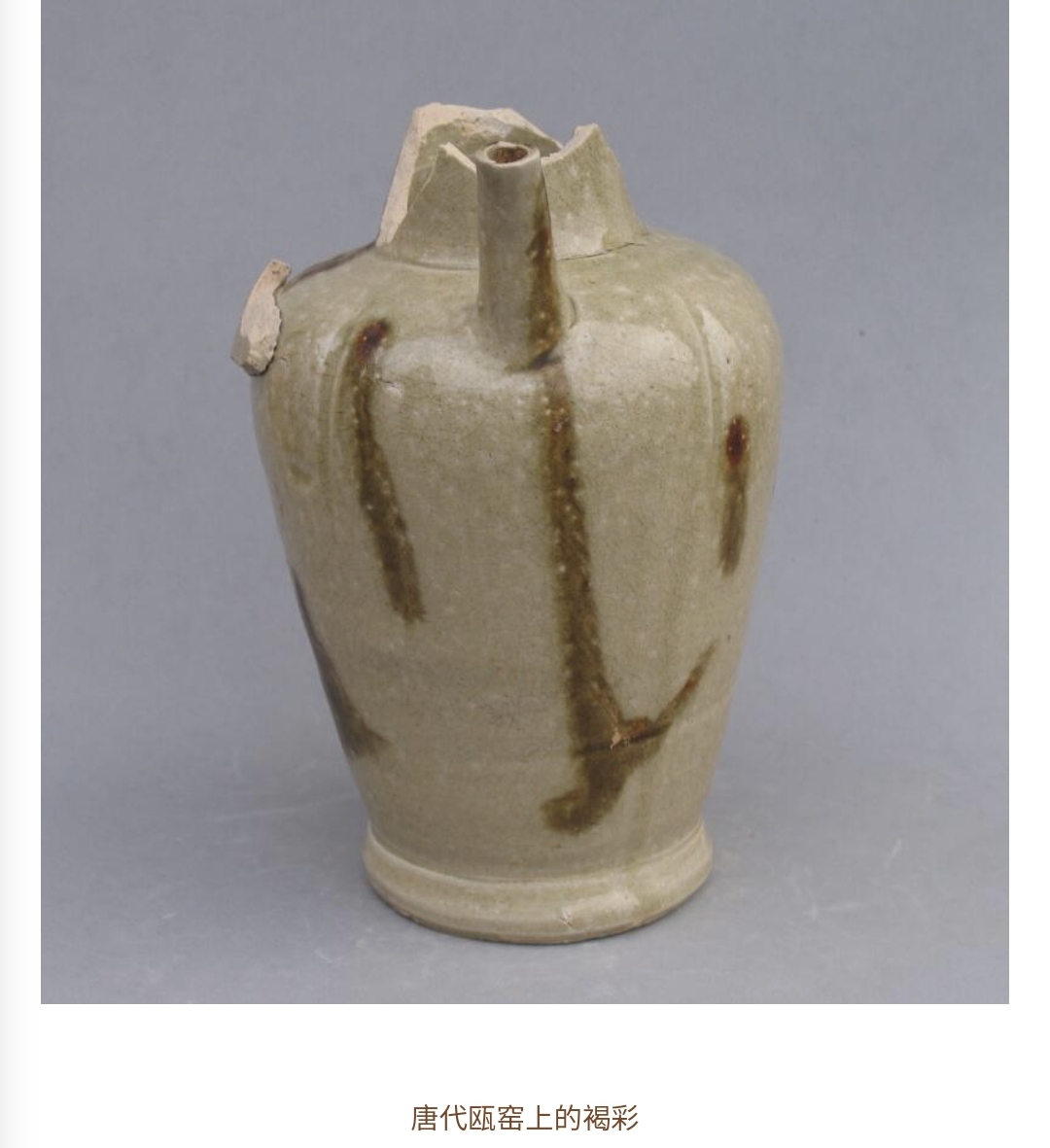 |
| Northern Song Wenzhou examples with iron-brown painted decoration | |
Examples of excavated Xicun wares from Philippines Butuan and Malaysia Tioman Islands were published in the 1980s. In 1989 a wreck discovered near Pulau Buaya of the Lingga archipelago (about 90 km south of Batam) carried a substantial quantity of Guangdong ceramics and small quantity of Jingdezhen and possibly Fujian ceramics. However, there were no bowls with painted floral motif among the ceramics finds. But in 2012, some large Xicun bowls with iron-brown painted floral motif surfaced in the Singapore antique market. They were salvaged from a wreck also near Pulau Buaya of the Lingga archipelago.
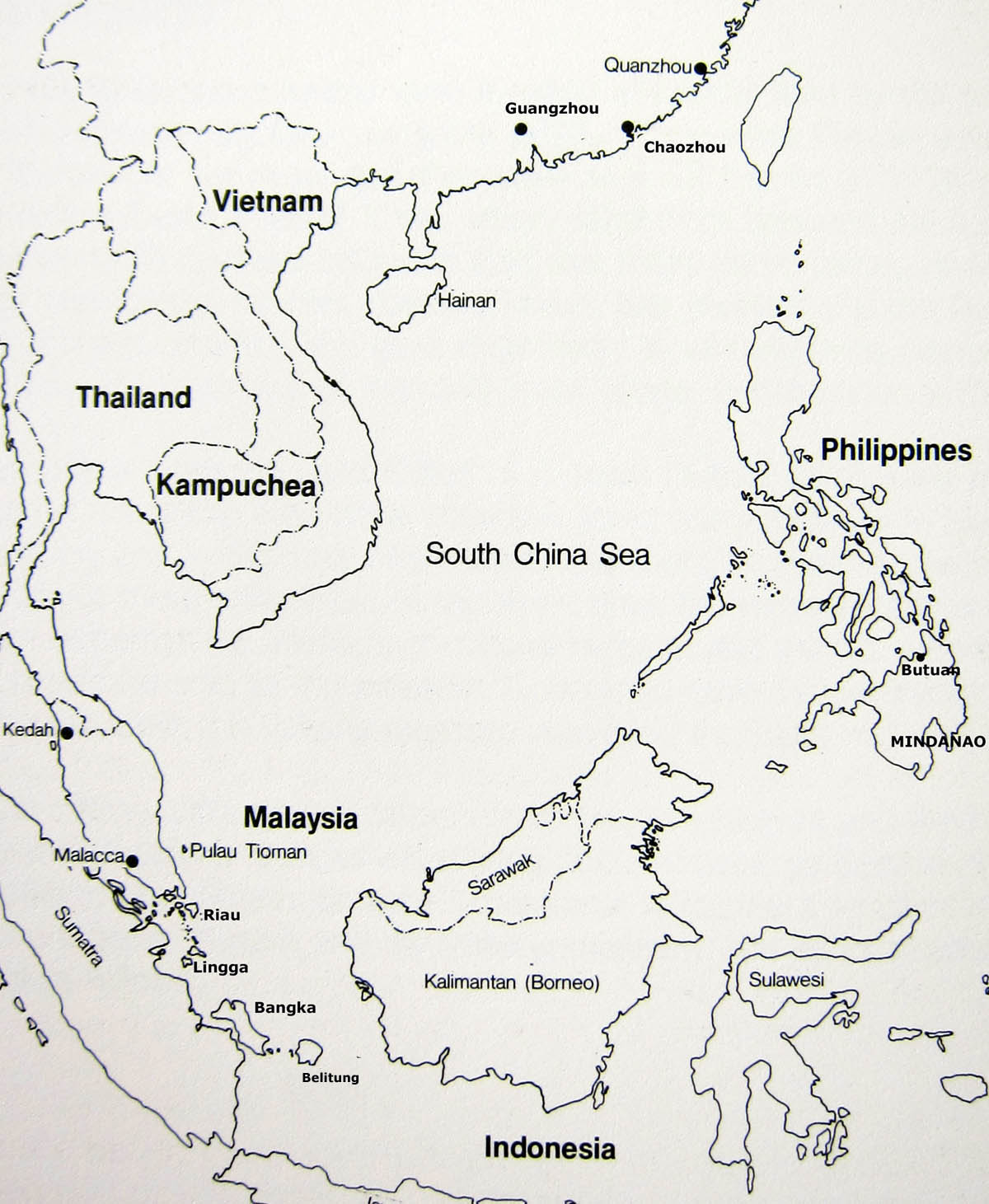
The big celadon (grayish green) bowls (dia. 33 and 23 cm respectively) have boldly painted iron-brown floral motif. There were also some bowls (dia. 23 cm) decorated with 4 characters in running script that read Zhihe Yuan nian (至和元年)。Zhihe was one of the reign marks of Emperor Renzhong and hence suggesting a date of 1054 A.D. However, the wreck carried some copper coins with various reign marks, the latest during the reign of Zhenghe, beginning of the 12th cent. It is an anomaly but not an isolated occurance, for example the Korea Sinan wreck dating ot Yuan has some Northern Song Jian Temmoku and the Qing Daoguang Tek Sing wreck some Late Ming Longquan incense burners. Some possible explanations include: they were old stocks or the calligraphic decoration was popular and continued to be produced to meet demand for a prolonged period of time. But it is tenable that it was first introduced in 1054 A.D possibly initially of a commemorative nature.
| Some celadon bowls with iron brown painted floral motif from the Riau wreck |
|
The 23 cm bowls have more crudely formed foot
|
|
|
The bigger 33 cm bowl has well form and finer paste foot
|
|
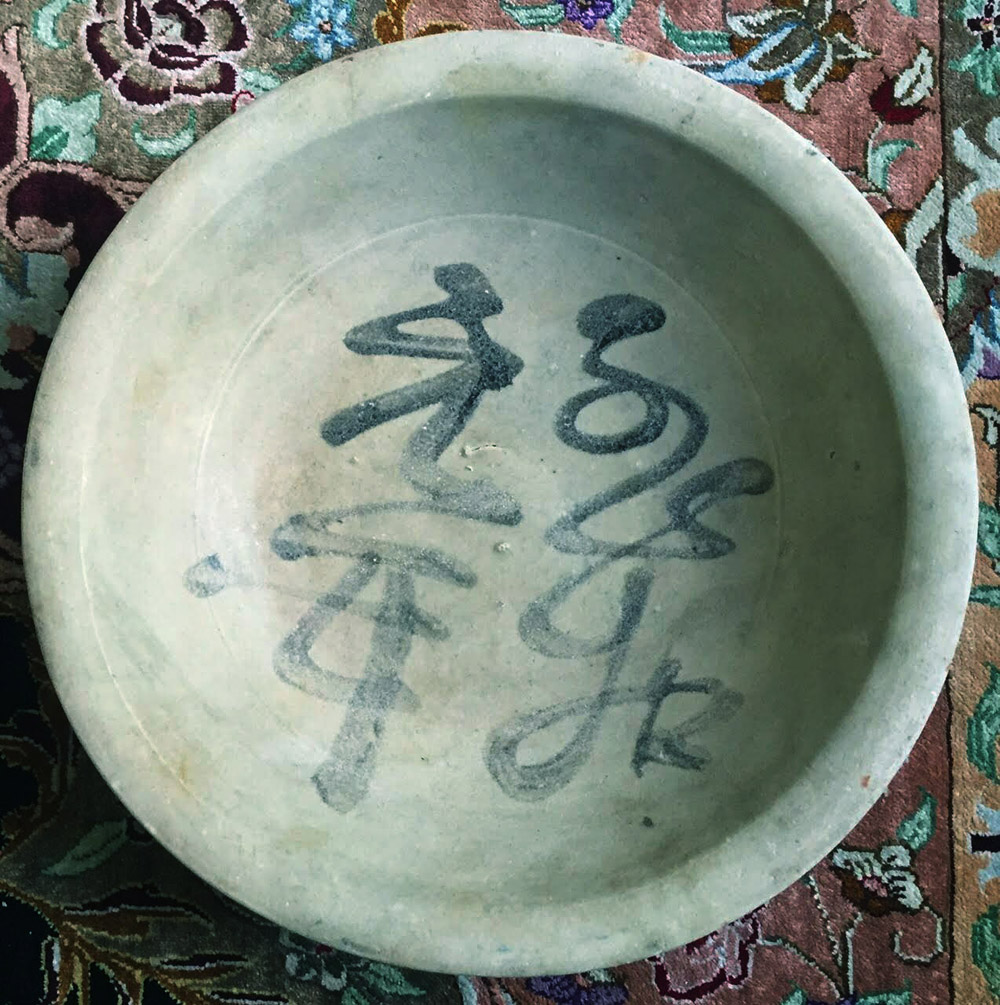 |
 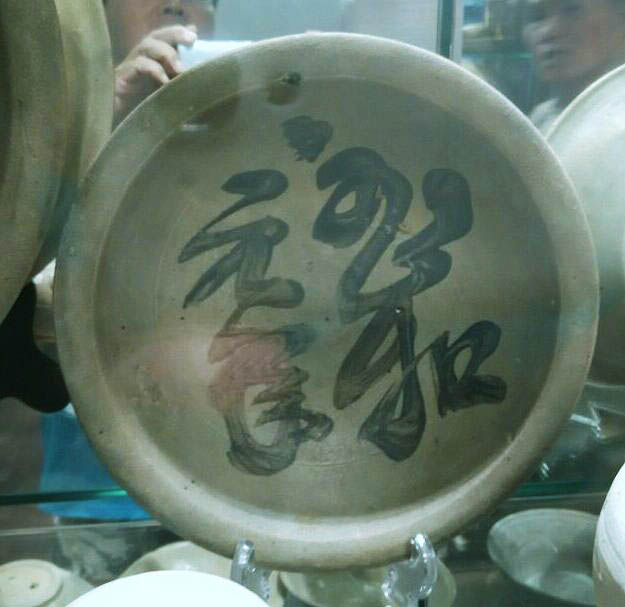 Bowls with 4 characters Zhihe Yuan Nian (至和元年) i.e. 1054 A.D |
 |
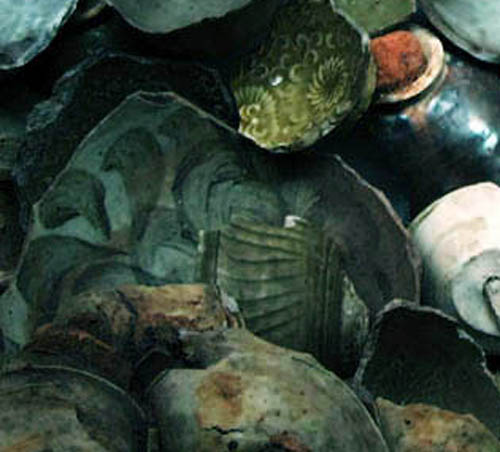 |
|
Examples of iron-brown painted motif on pillow and fragment of a bowl exhibited in Guangdong shi museum |
|
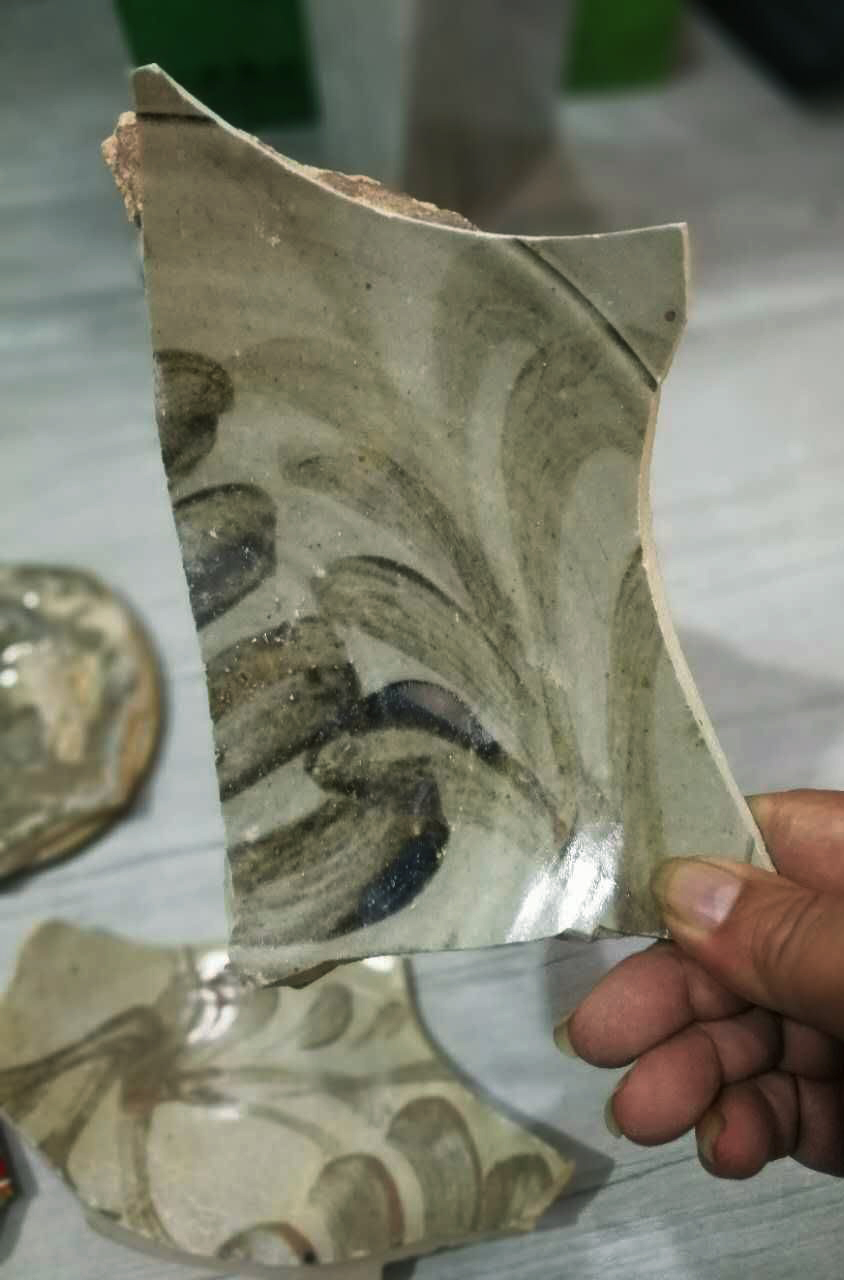 |
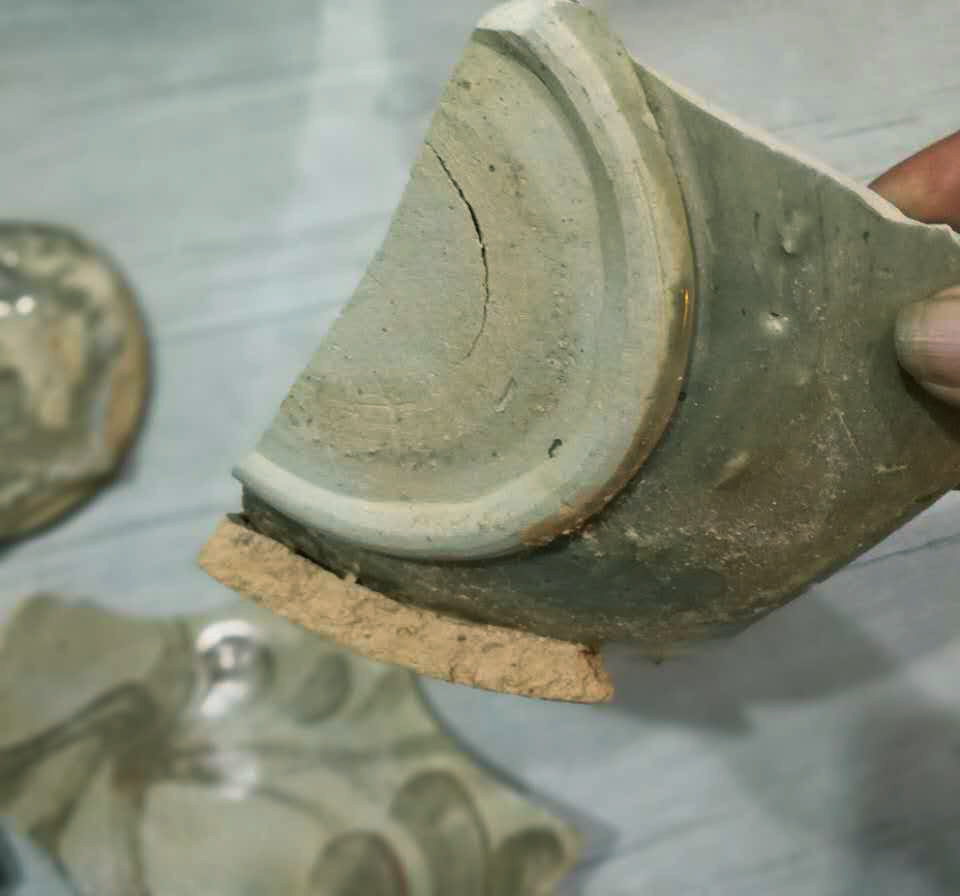 |
| Shards recovered from the Guangdong Shabian Kiln site | |
From some known collections, there are excavated examples of iron brown floral painted bowls which have carved floral motif on the inner wall. There is an example excavated in Sarawak and some illustrated in the book on "Guangdong ceramics from Butuan and other Philippines sites". From some known collections, there are excavated examples of iron brown floral painted bowls which have carved floral motif on the inner wall. There is an example excavated in Sarawak and some illustrated in the book on "Guangdong ceramics from Butuan and other Philippines sites". This is in effect a hybrid form, combing the Yue inspired carving and Changsha inspired iron-brown decoration.
| An iron painted floral bowl with carved floral motif on inner wall from the Sarawak museum |

On the subject of iron-brown painted vessels, the Guangdong archaeologist Zheng Guangyi in the book "Ceramics Finds from the Tang and Song kilns in Guangdong", mentioned that two sites in Nanhai , i.e. Qishi (奇石) and Jiaotou Ling (交头岭) produced iron painted vessels decorated with a variety of motif such as orchid, floral scrolls, reeds, bamboo leaves, human motif and etc. Recently, I learnt that similar iron-painted wares were also produced in Panyu Shabian kiln (番禺沙边窑). Indeed, some iron-brown painted fragments were excavated from the Nanyue Palace site.
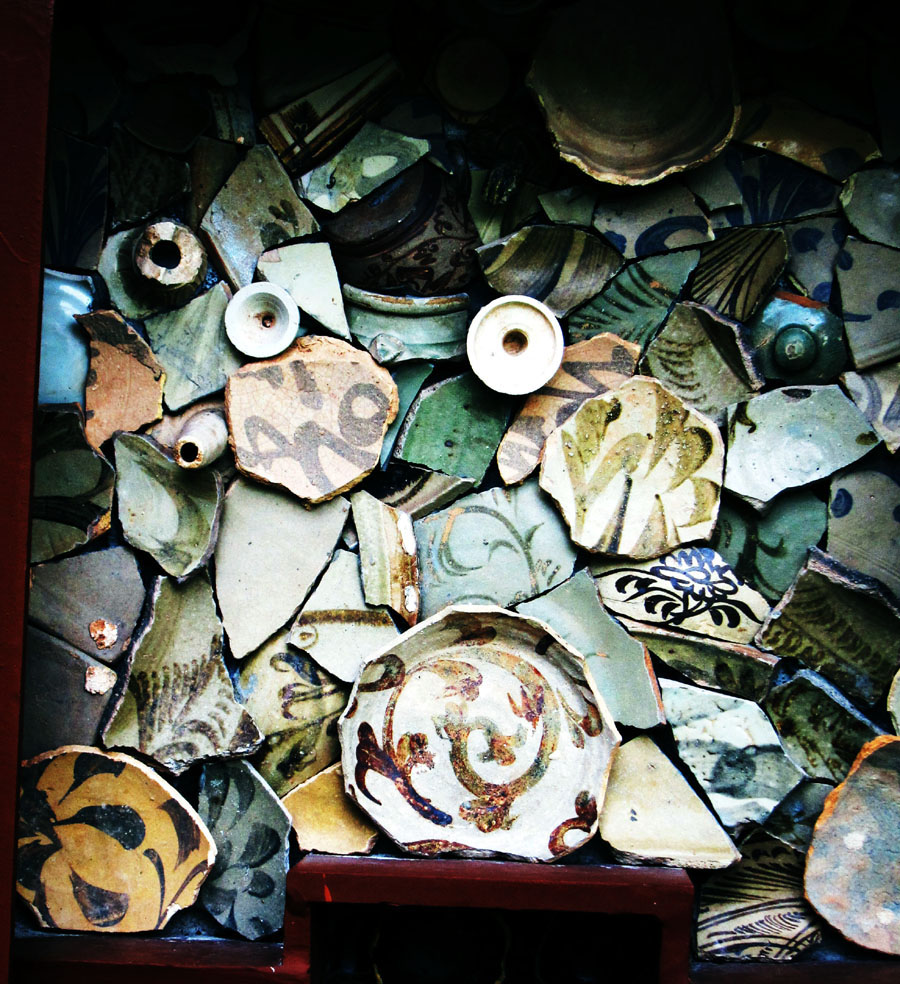
Iron painted fragments in the Nanyue Palace Museum
Another interesting and rare variation has carved slanting lines on the internal and outer wall.
 |
 |
| A rare iron-brown painted floral example with carved slanting lines on inner and outer wall of bowl. It was found in Sumatra. |

| Two examples of Yue style carved/combed decoration from Xicun kiln in Guangdong Shi Museum. On the right, a 5 Dynasties/Northern Song Yue fragment. |
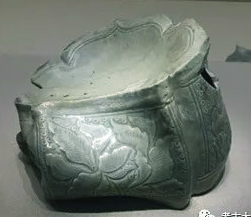 |
| Green glaze pillow recovered from the Xicun kiln site |
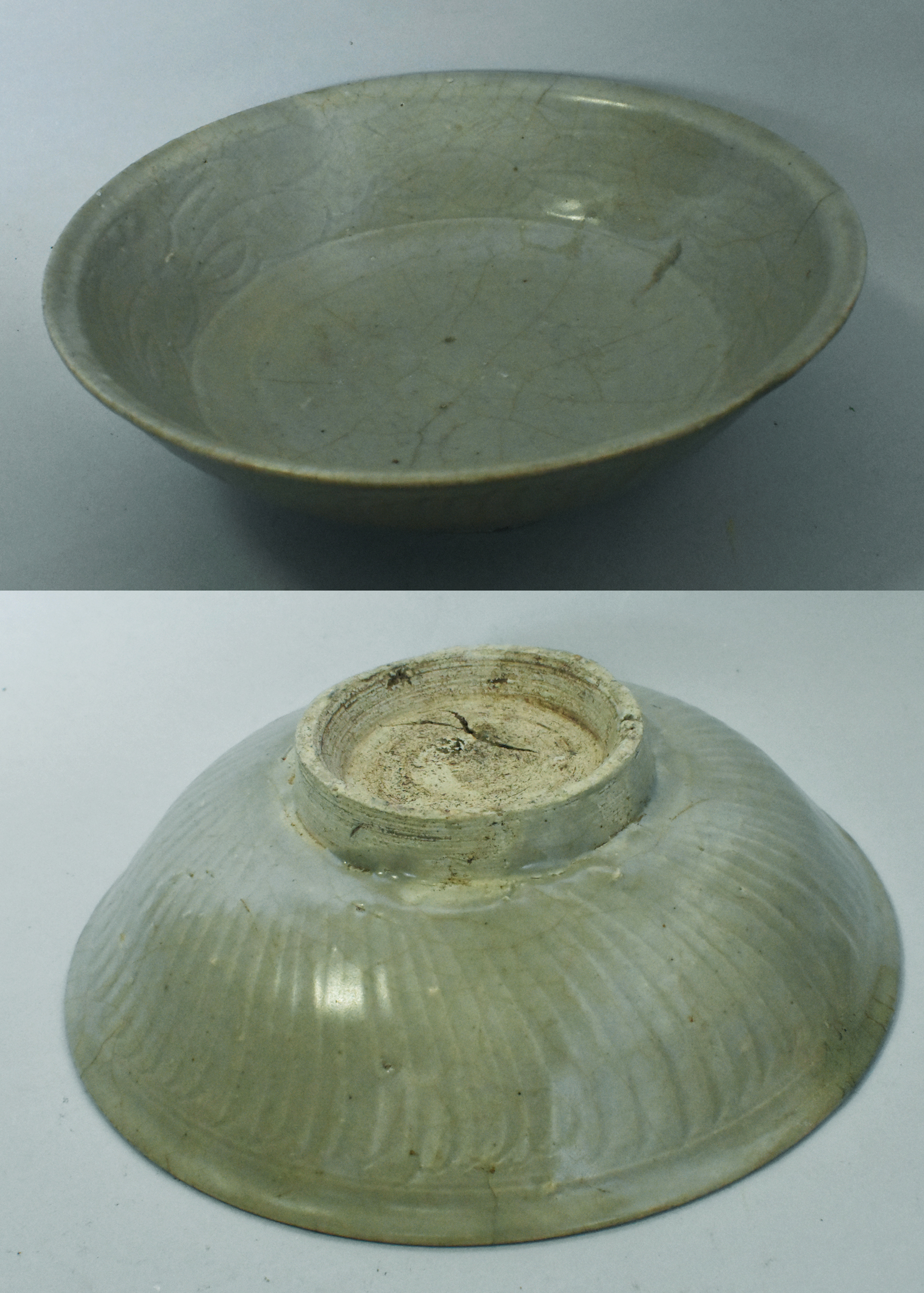
| Xicun bowl with carved decoration on the inner wall. Artifact was found in Indonesia. |
Among the repertoire of decorative elements, carved '[' line was one widely used by various kilns in China during the Northern Song period. For those rough version, the '[' lines resemble sketchily carved slanting straight lines. Xicun and other Guangdong kilns also frequently used this decorative element on their green and qingbai glaze wares.
|
|
|
| Example of Xicun green glaze bowl with external wall decorated with carved “[” lines in the Guangdong Shi Museum |
Xicun potters introduced subsequently a distinctive decorative element to their carved floral decoration. The outline of the flower is formed by stamped arcs. From some known examples, such floral style is sometime further decorated with iron-brown painted dots. There is a likelihood that when this type was introduced, the iron-brown floral decoration may have been phased out or less frequently used.
There were some such bowls with carved floral decoration recovered from an unknown wreck near Karang Cabang, Pulau Buku Limau, east of Belitung Island.
|
|
|
|
|
The flower has the outline formed by stamped arcs. Example came from the "Belitung" wreck |
|
|
|
Example from Xicun Huangdi Gang exhibited in Guangdong shi Museum |
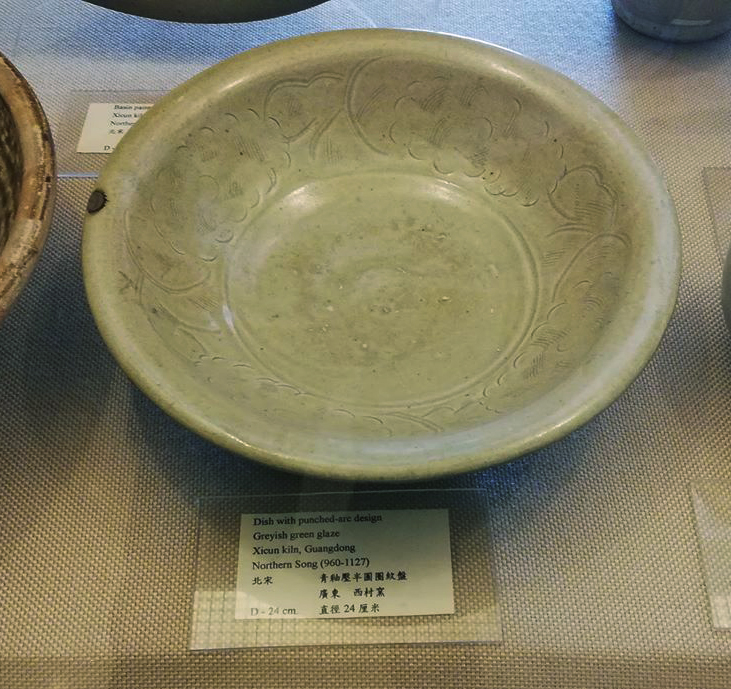 |
| Example from the Ching Ban Lee Gallery |
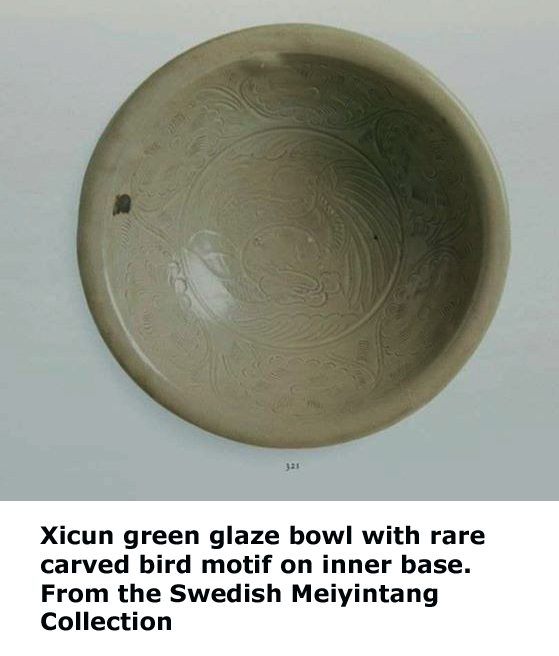
There are also those further decorated with iron-brown dots placed in random manner or in group which looks like a rosette. I have also came across an excavated big bowl (33 cm) with the floral petals further decorated with cluster of 6 iron brown spots.
|
|
|
|
| Bowl found in Indonesia and belonged to an Indonesian collector |
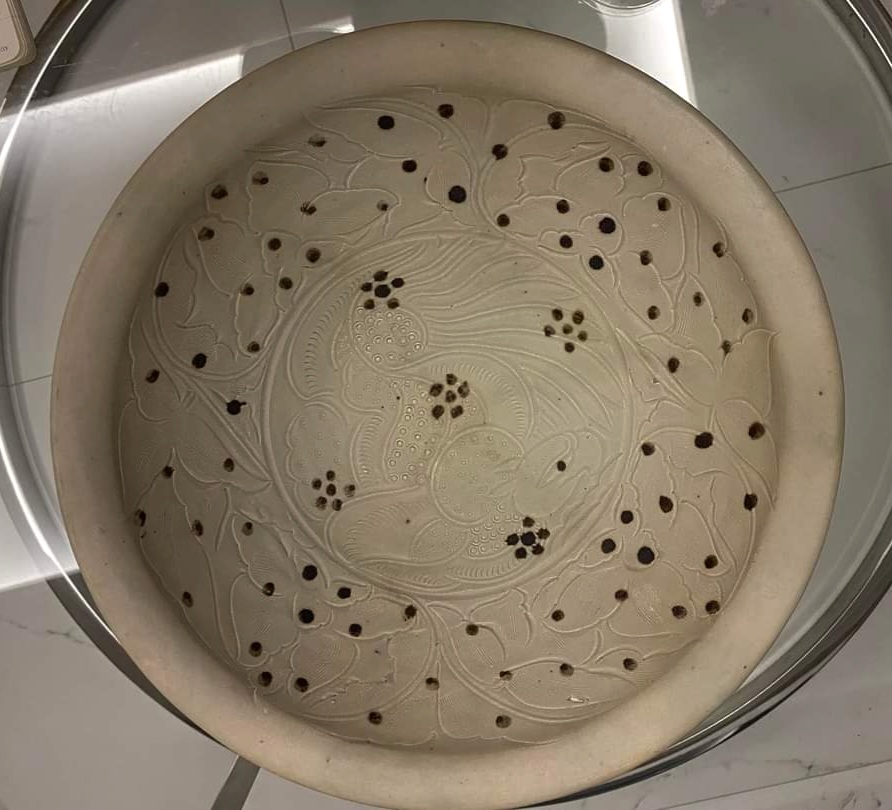 |
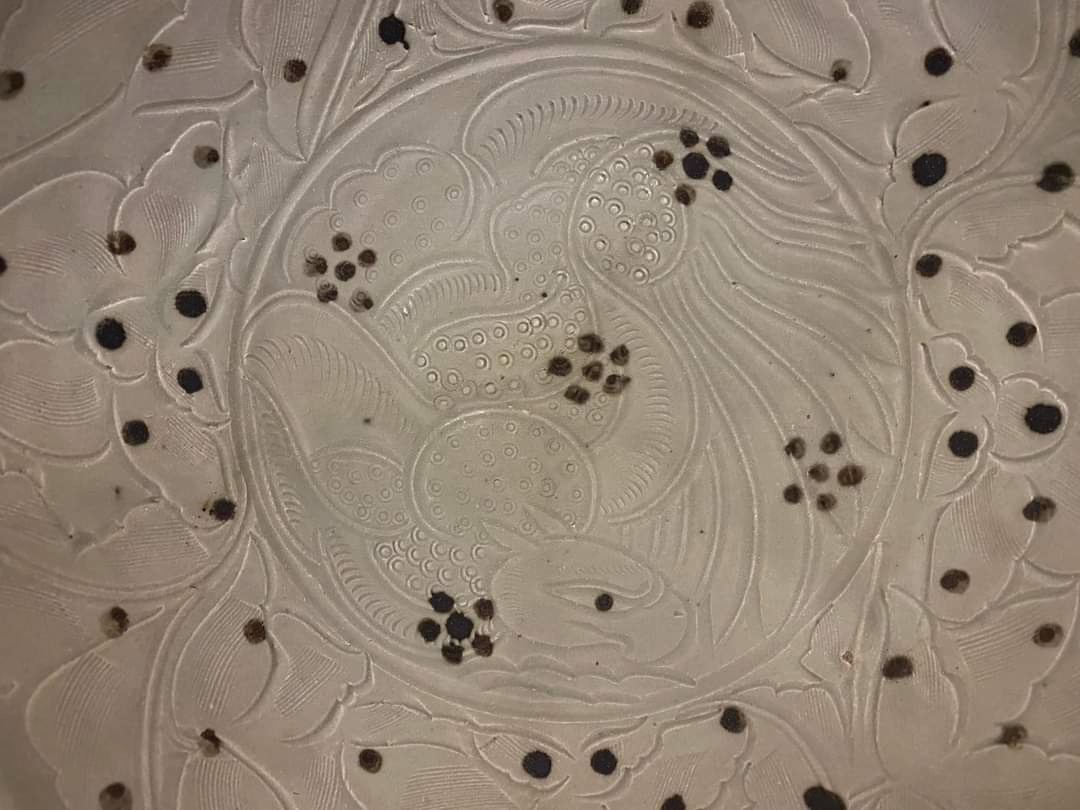 |
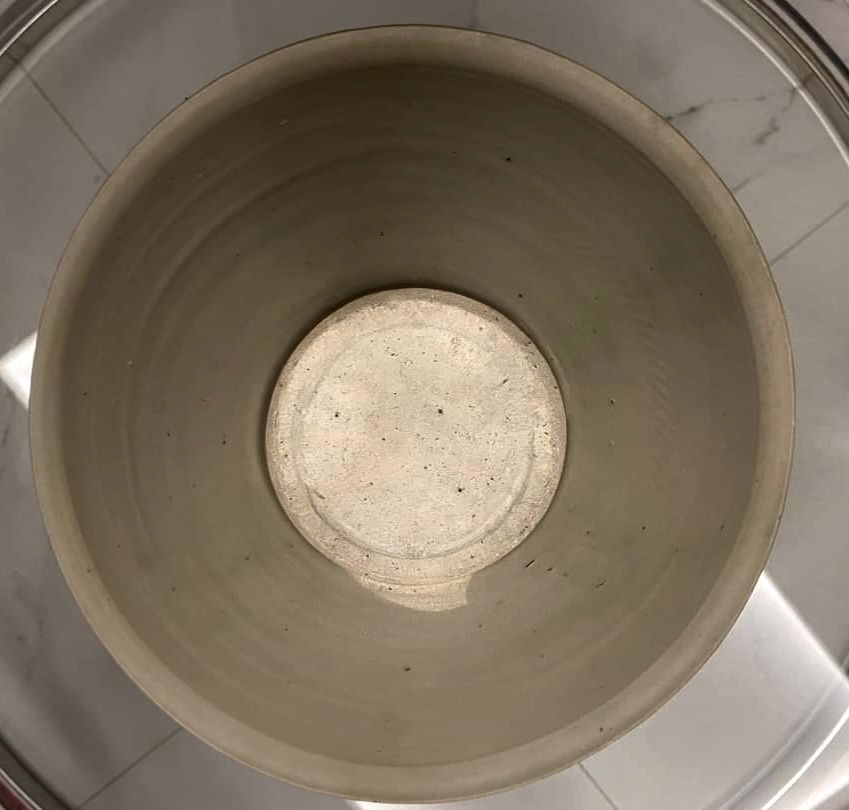 |
| Xicun kiln excellent example with carved bird/floral decoration. Found in the Philippines. |
|
|
| Fragment of a cover of a box with intricately carved floral decoration on stamped circles ground. This beautiful sample was recovered from a wreck near Qui Nhon city of Central Vietnam. |
Lotus petals had been a particularly popular decorative element on Chinese ceramics since the Southern Dynasties period. It was also widely used on Guangdong vessels during the Northern Song period. There are two forms: either with the petals carved in high relief giving the embossed visual effect or a later version with lotus petals in carved outlines. The latter was likely introduced sometime later.
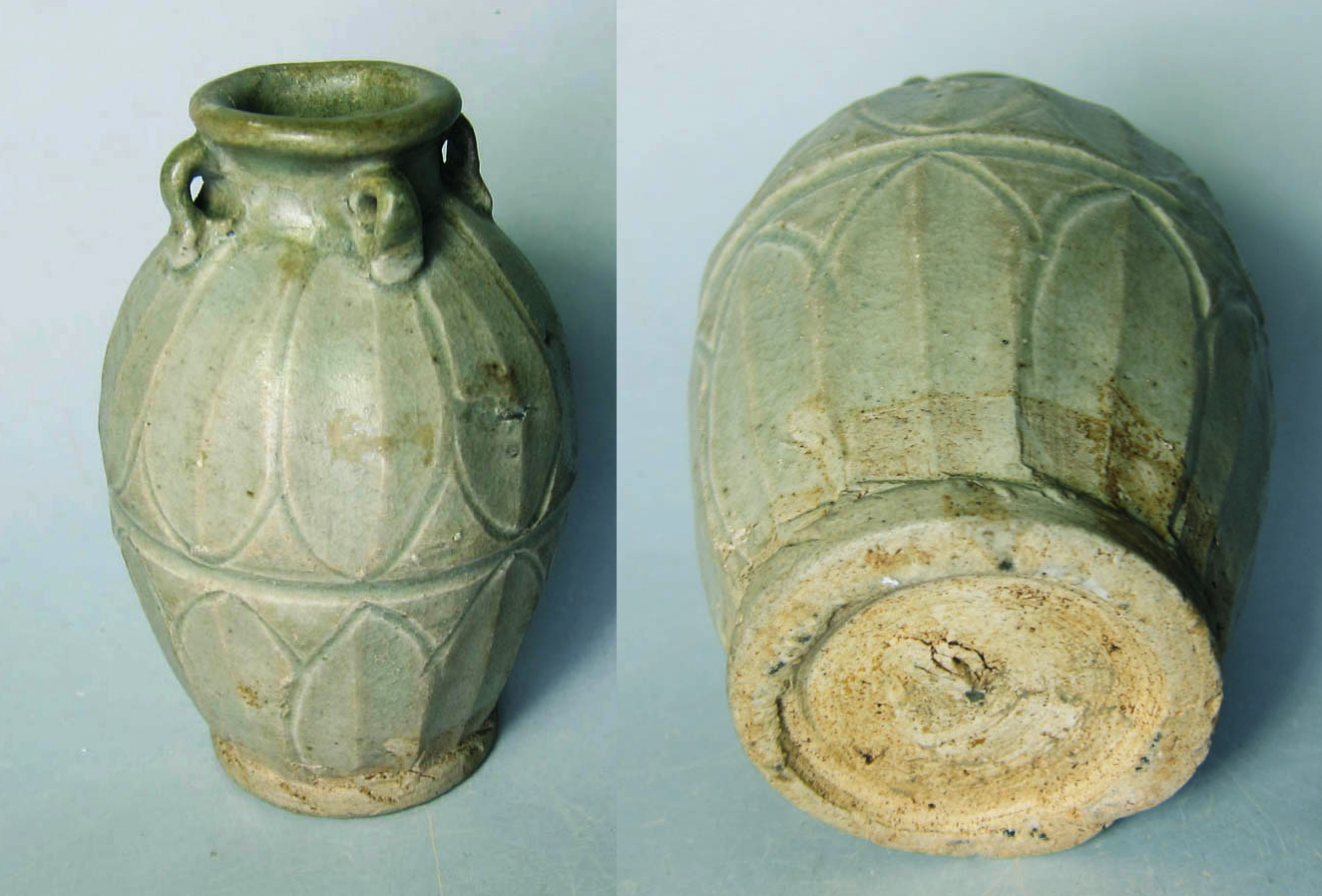 |
| Xicun jarlet with two bands of carved lotus petals in high relief. |
 |
| Two examples of grayish green jarlets with lotus petals in carved outline form. Left came from a wreck near Belitung and the other Singkep Island |
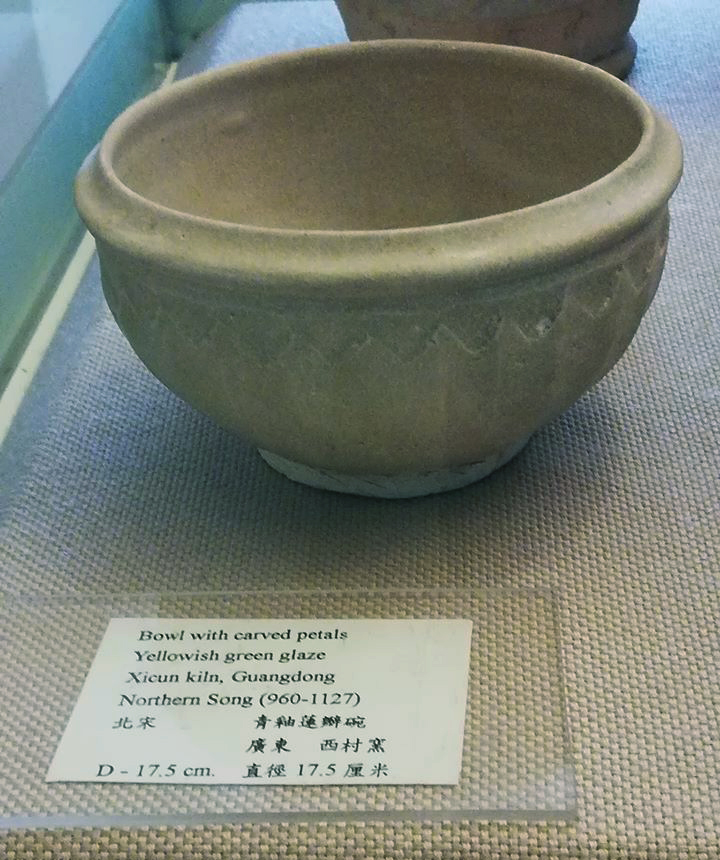 |
| An Example with stylised lotus petals in the Ching Ban Lee Gallery |
 |
| Two green vase jarlets from a wreck near the Island Singkep Island |
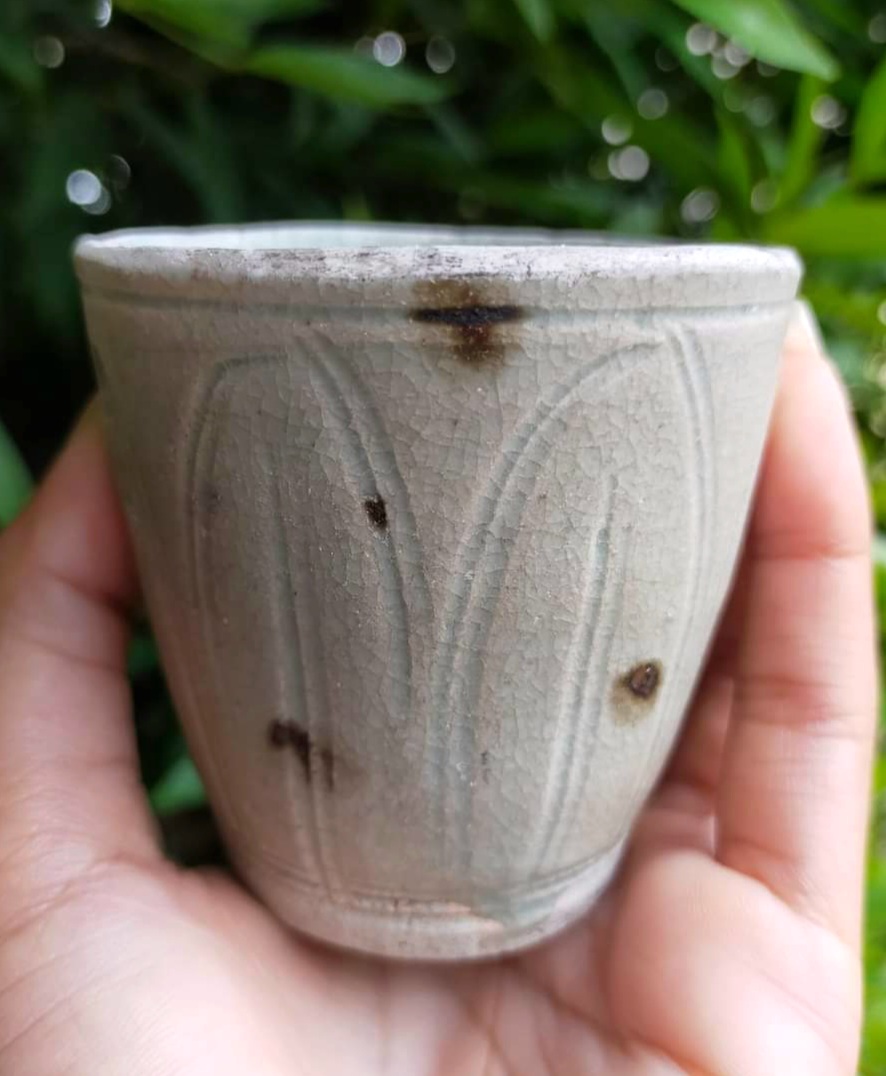 |
 |
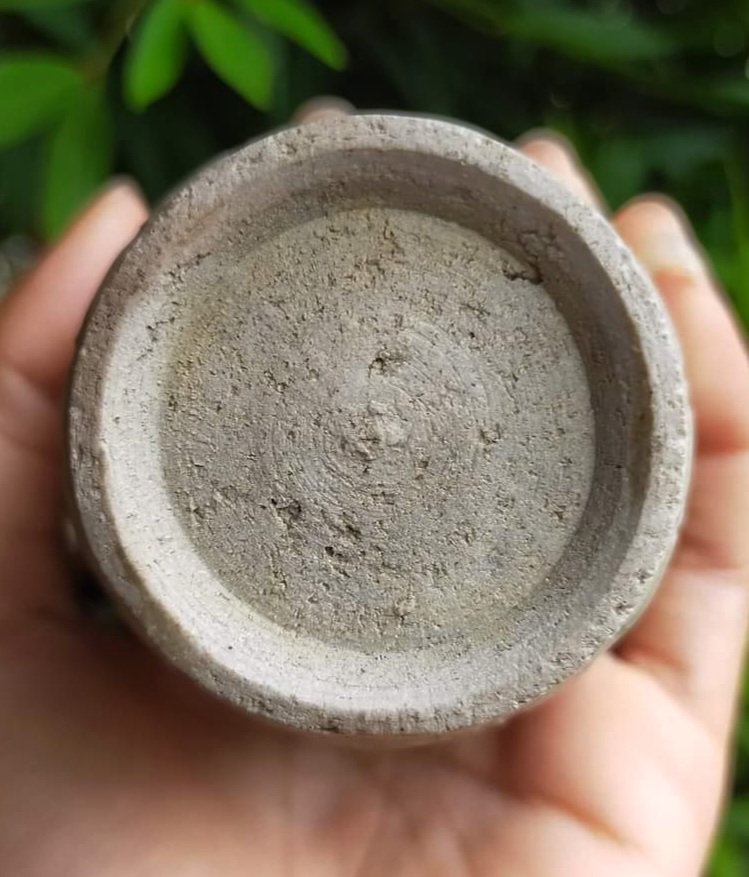 |
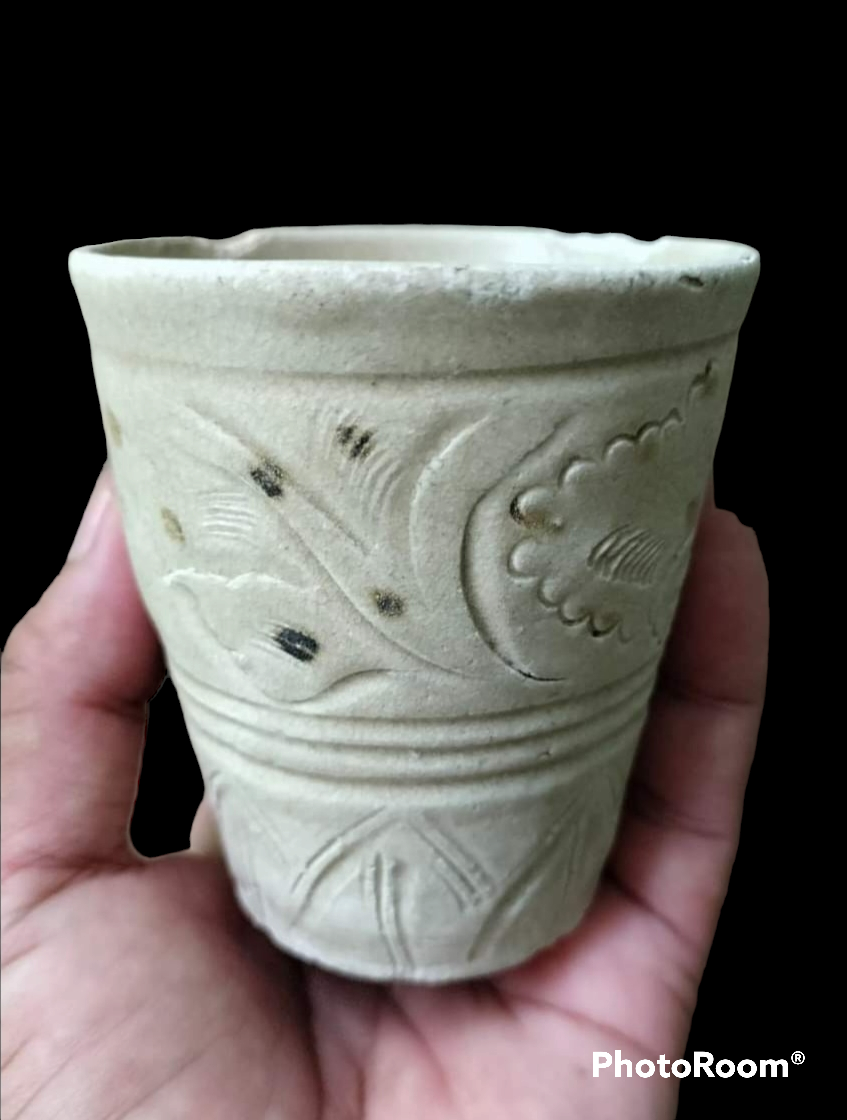 |
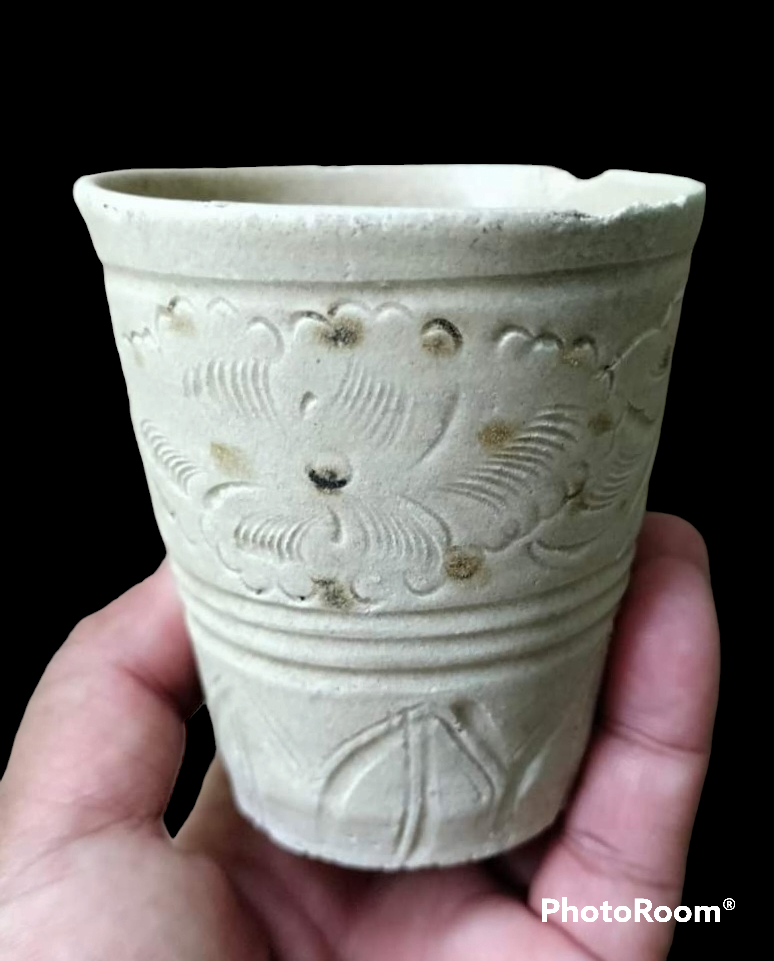 |
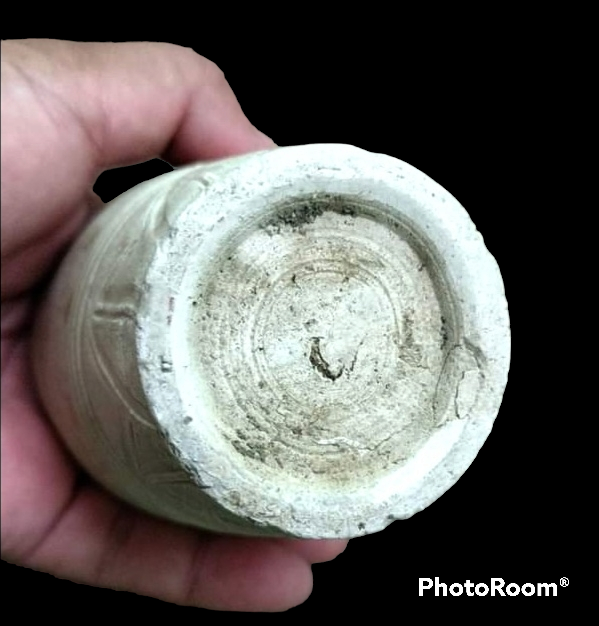 |
| Two Xicun kiln beaker shaped vessels with carved and iron brown spotted decoration found in Sumatra Jambi |
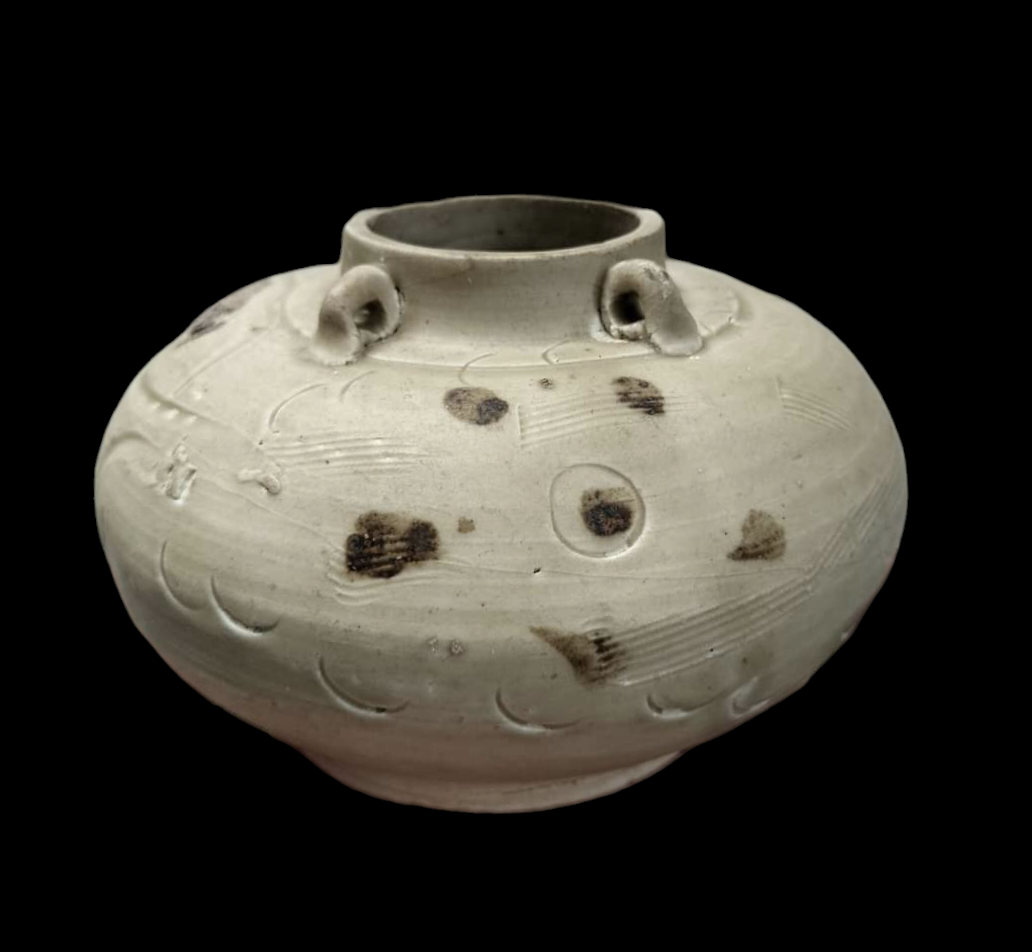 |
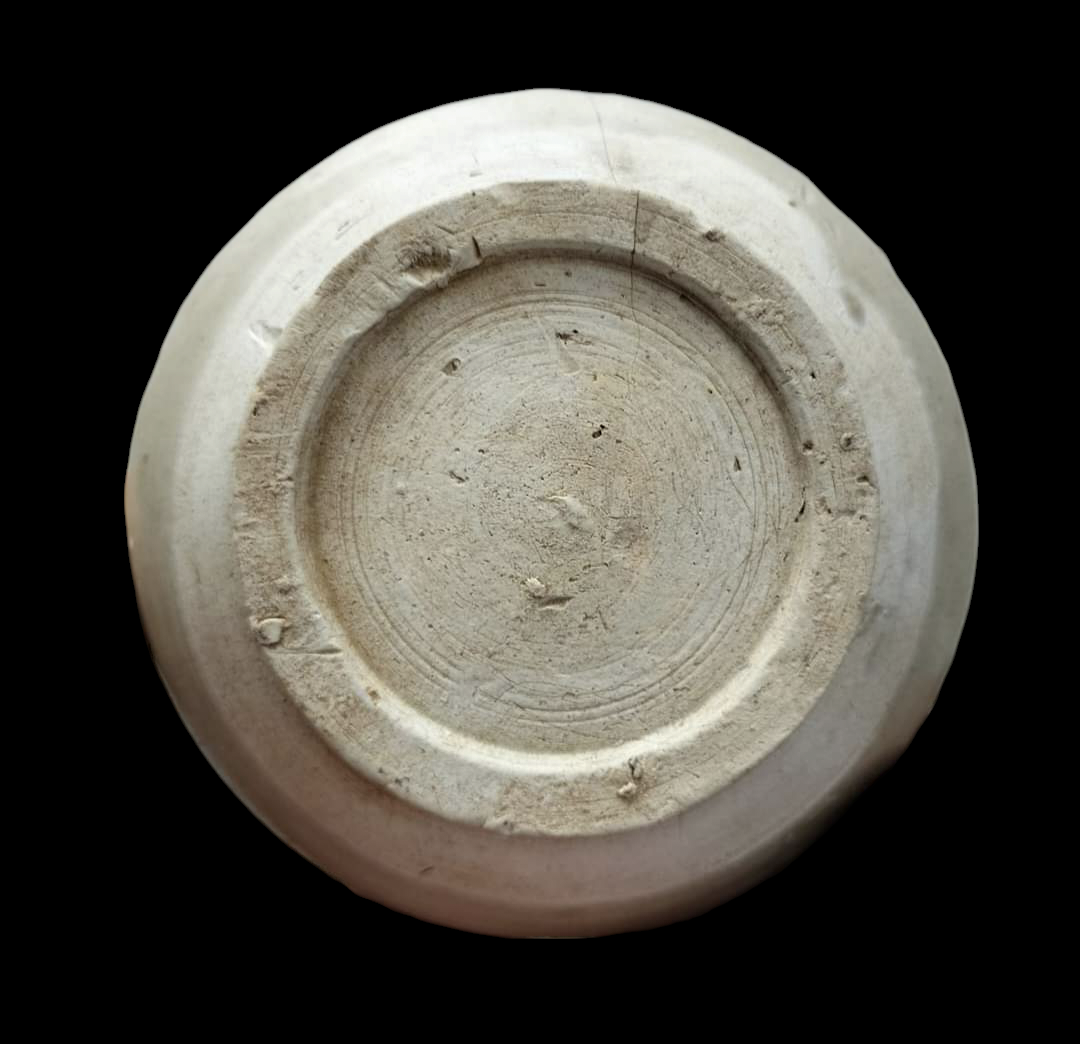 |
| Xicun Jarlet with carved abstract floral decoration. Found in Jambi in Sumatra. |
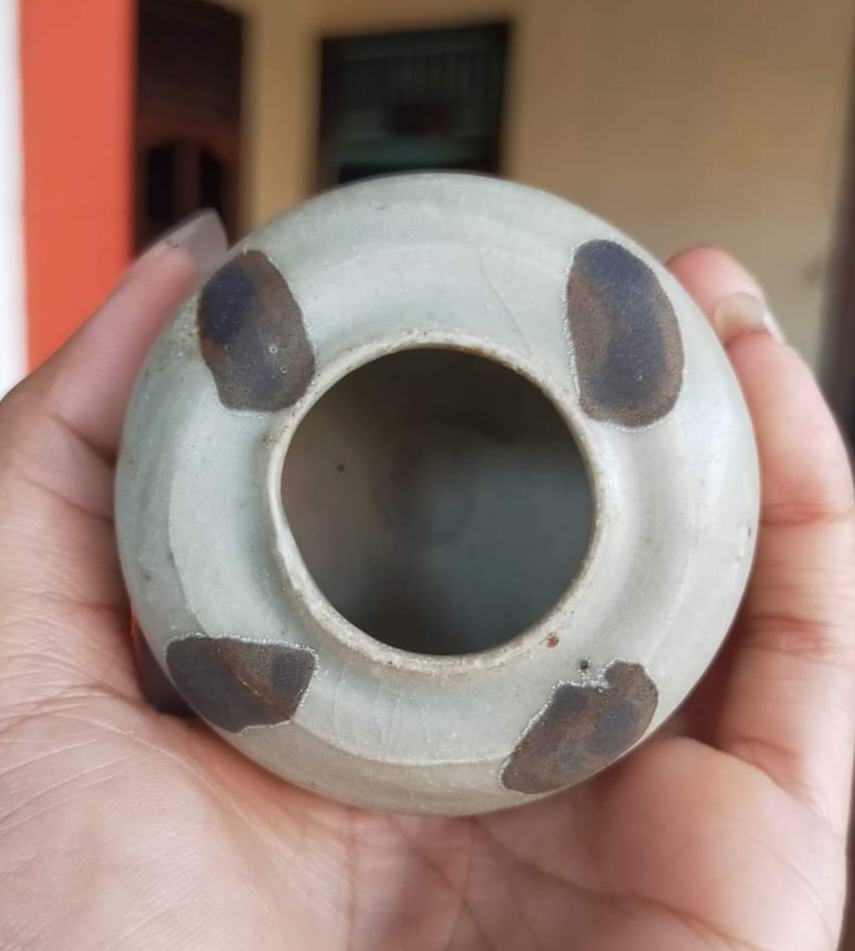 |
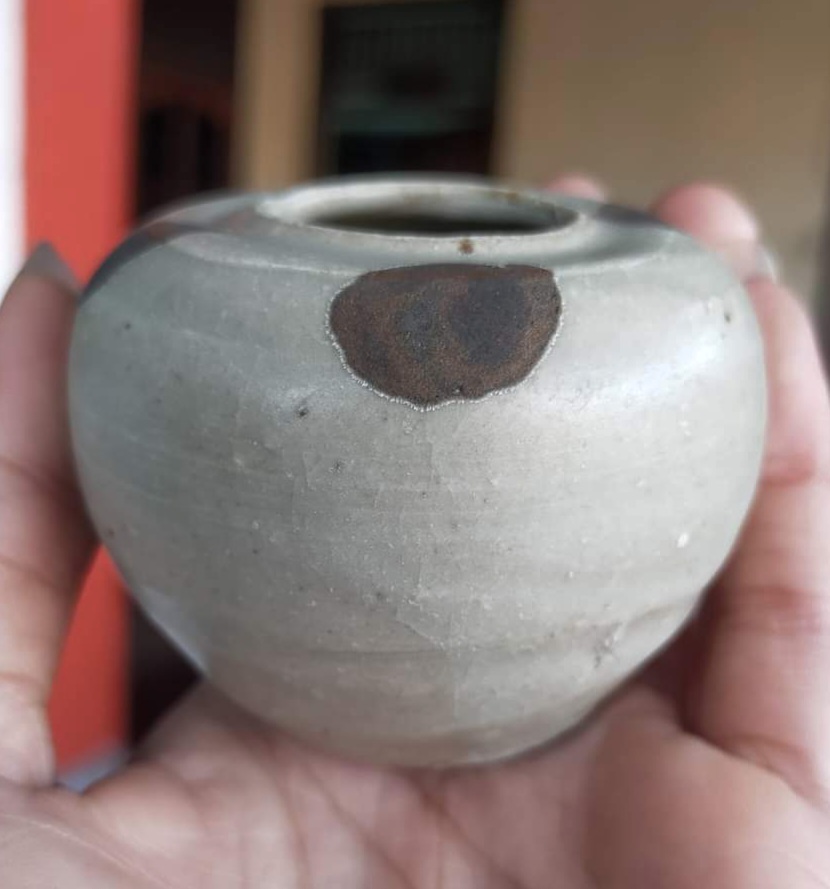 |
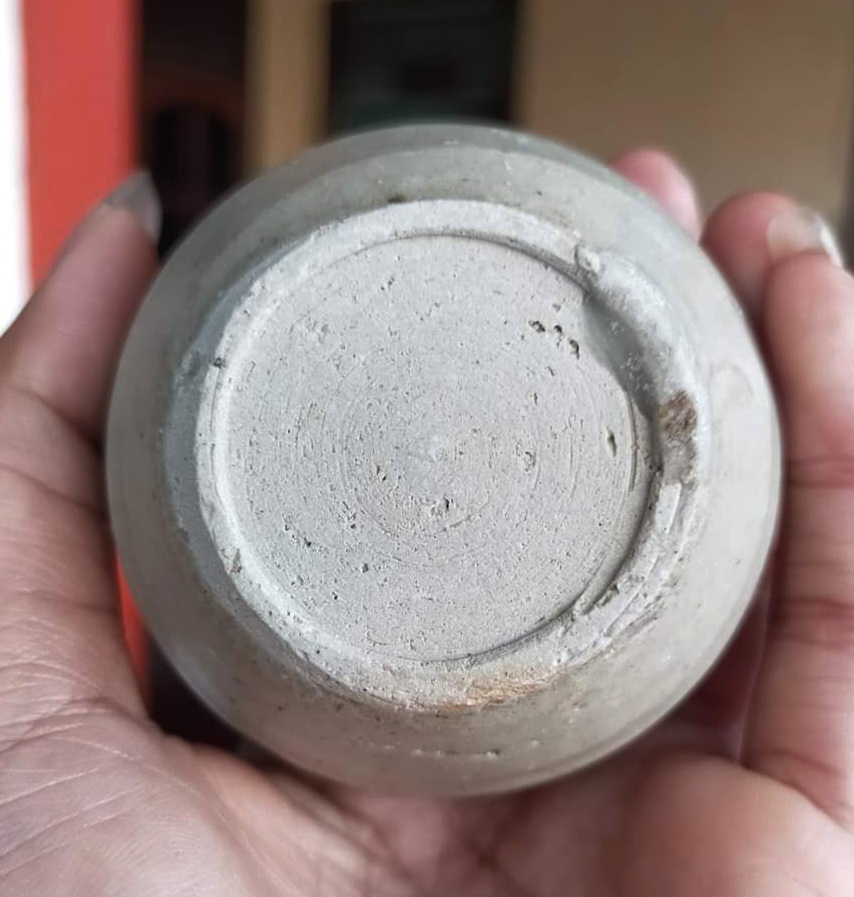 |
| A Xicun kiln jaret with iron brown spotted decoration found in Indonesia Sumatra |
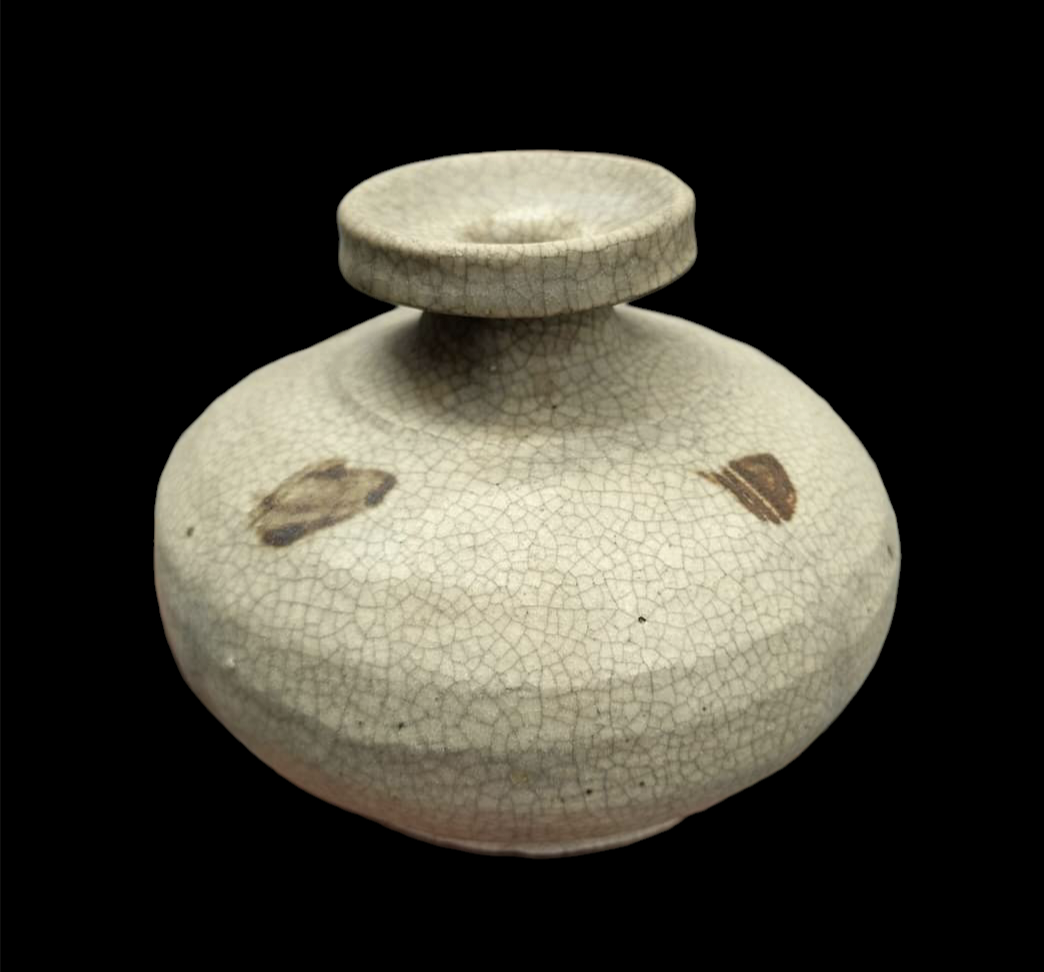 |
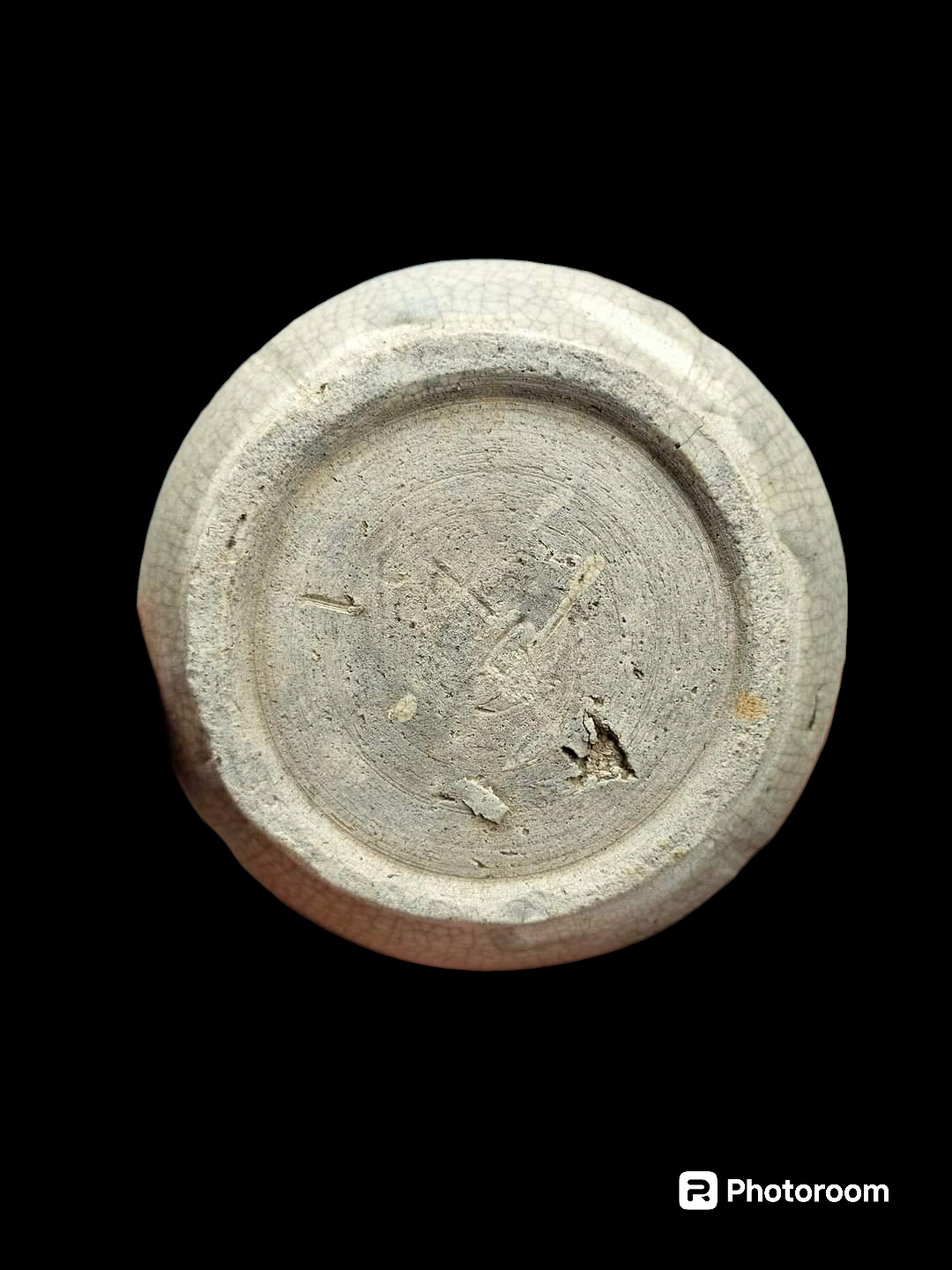 |
| Xicun jar with spotted decoration. Found in Jambi in Sumatra |
Bottle with ribbed neck features among one of the most recognizable forms of Xicun ceramics. Among them, there are also those with the globular body partitioned into lobed form. Majority of them have grayish green glaze which may be further embellished with iron brown painted spots. There is also Qingbai glaze version with Chaozhou Bi Jia Shan identified as a major production center. We also find small quantity with brownish glaze. Those with iron-brown painted spots were likely produced during the later period.
|
|
| Group of bottles with ribbed neck. Two behind on the right have a greenish blue colour tone qingbai glaze which is different from the the light bluish qingbai from Bi Jia Shan kiln . The other 3 are of grayish green glaze. Bottle in front on the right is decorated with iron-brown spots and that on the left has an interesting Jun like bluish caste. Chronologically, the 3 behind are likely dated earlier. They came from a separate wreck from the other two in front. |
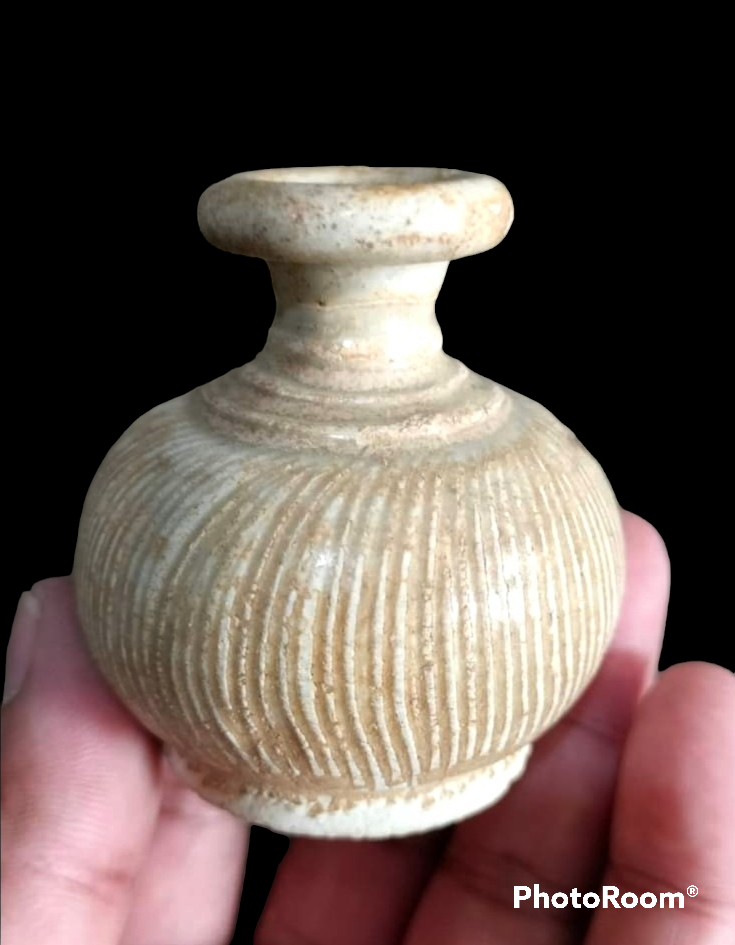 |
 |
| An interesting Xicun kiln qingbai glaze bottle form with ribbed body found in Sumatra Jambi |
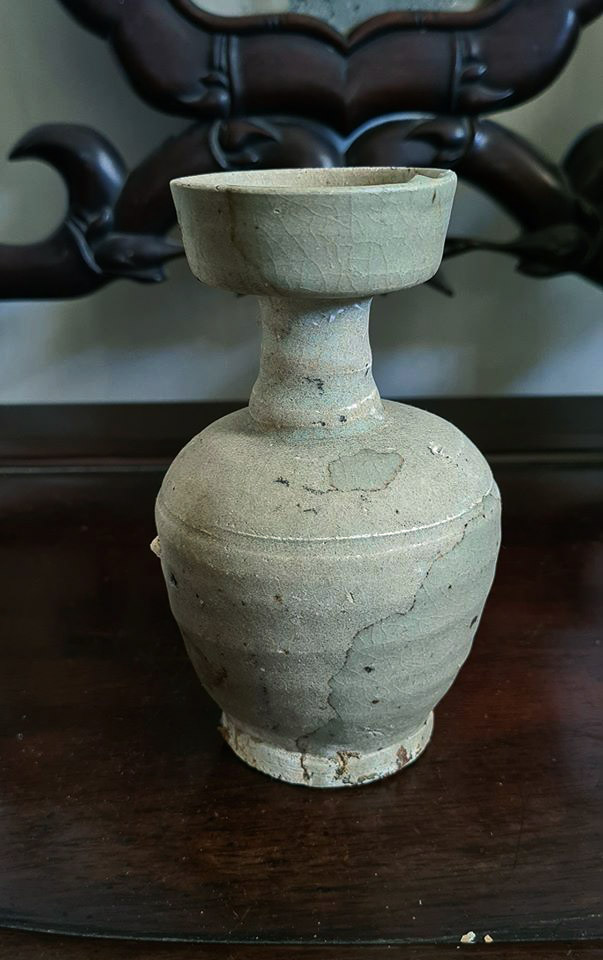 |
| Green glaze vase with dish shape mouth and concentric circles on the neck. Recovered from a wreck near Lingga Island. |
Another well-known and widely recognizable form is box with cover shaped in bird form. Most have grayish green glaze and a significant number with brown spots decoration.
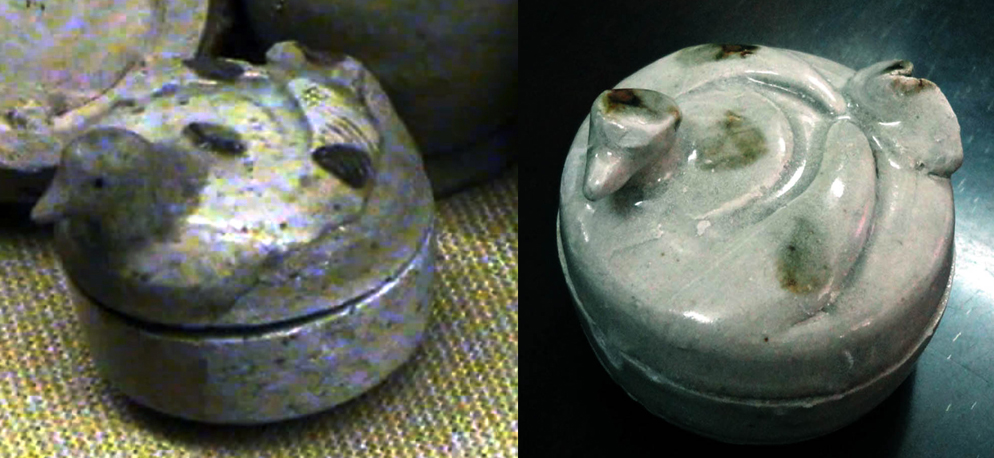 |
| Left Xicun cover box is on display in the Guangdong Shi Museum. The other is from an Indonesian collection |
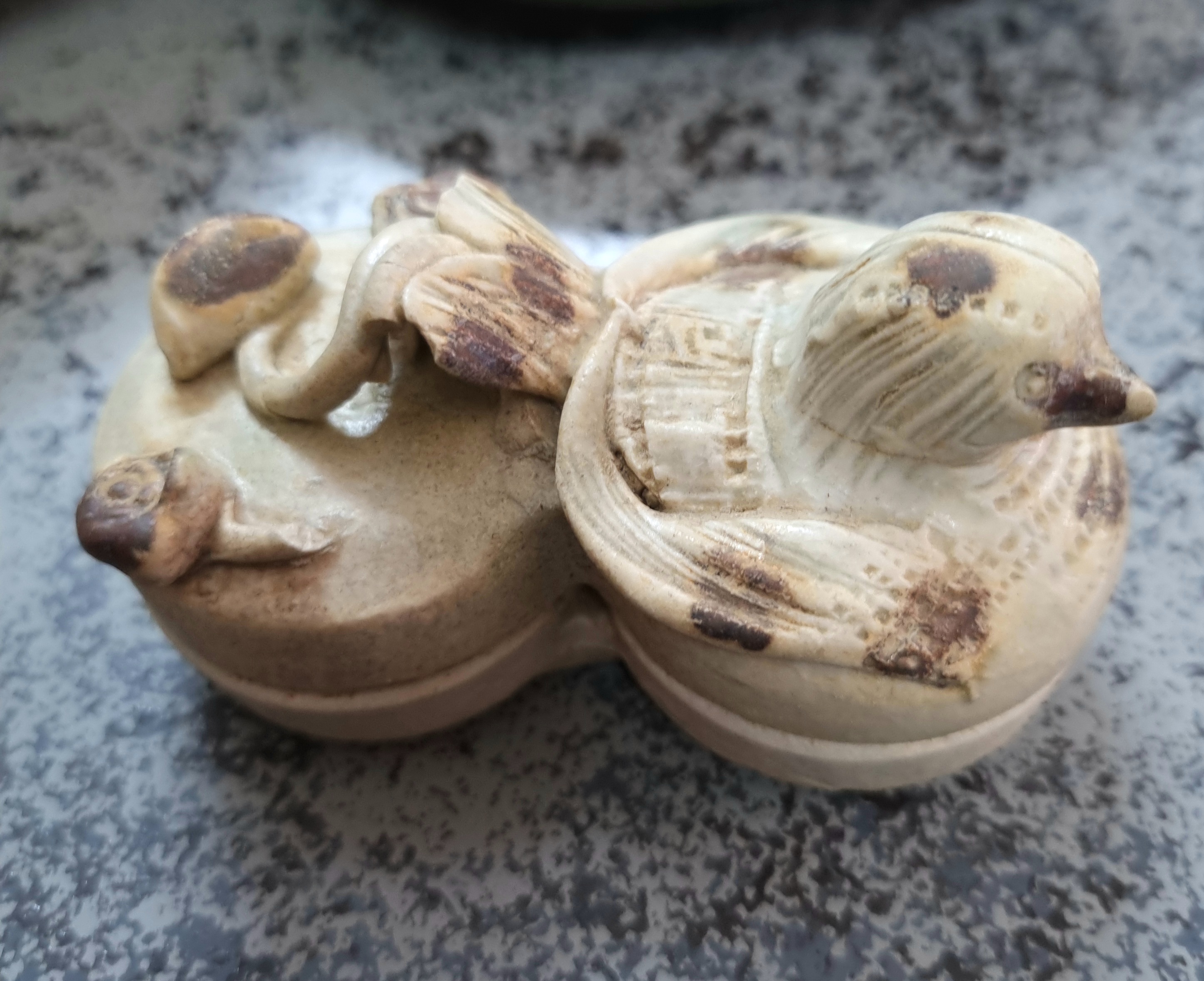 |
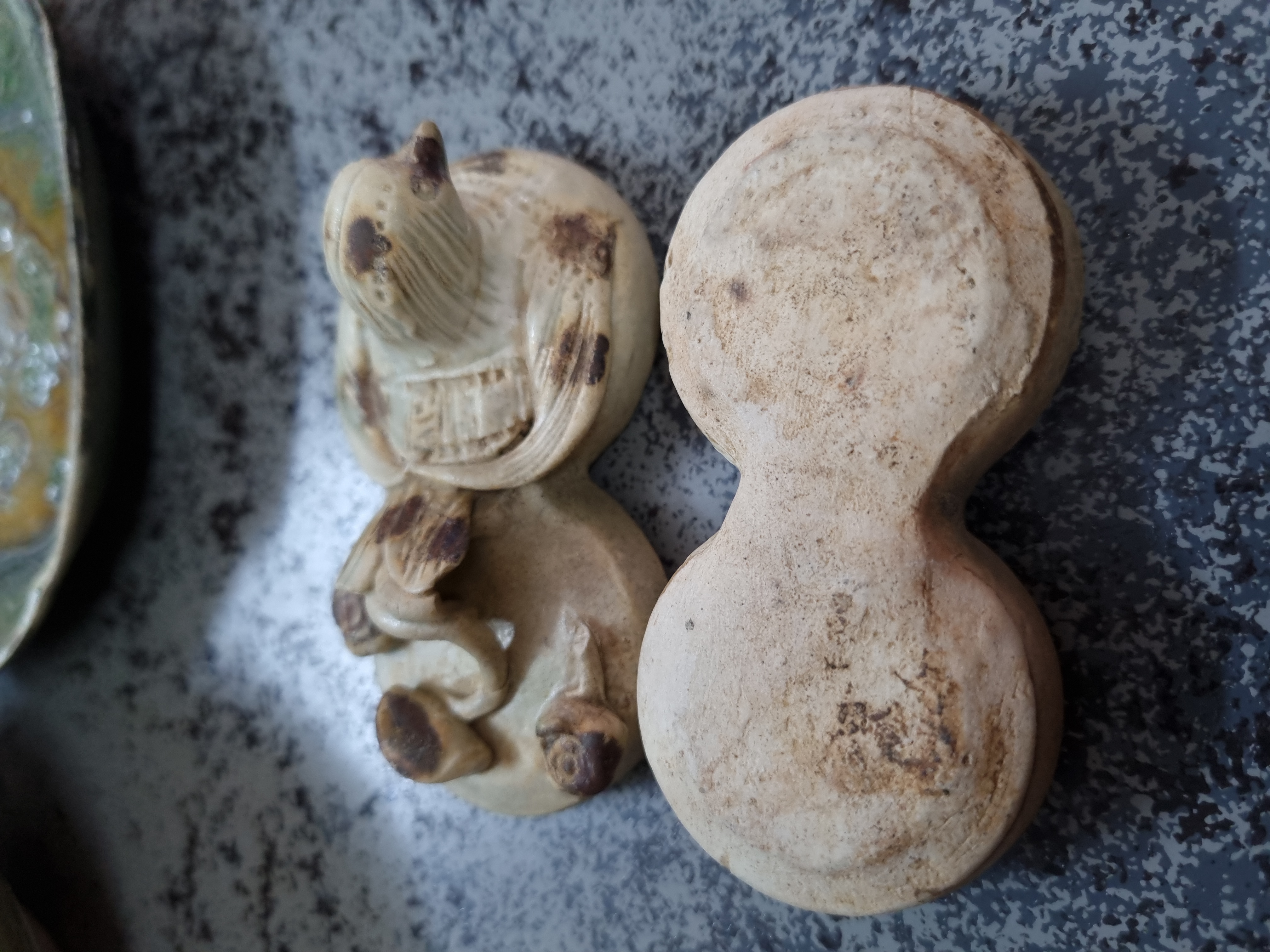 |
| Beautiful example of twin boxes with bird decoration on the cover |
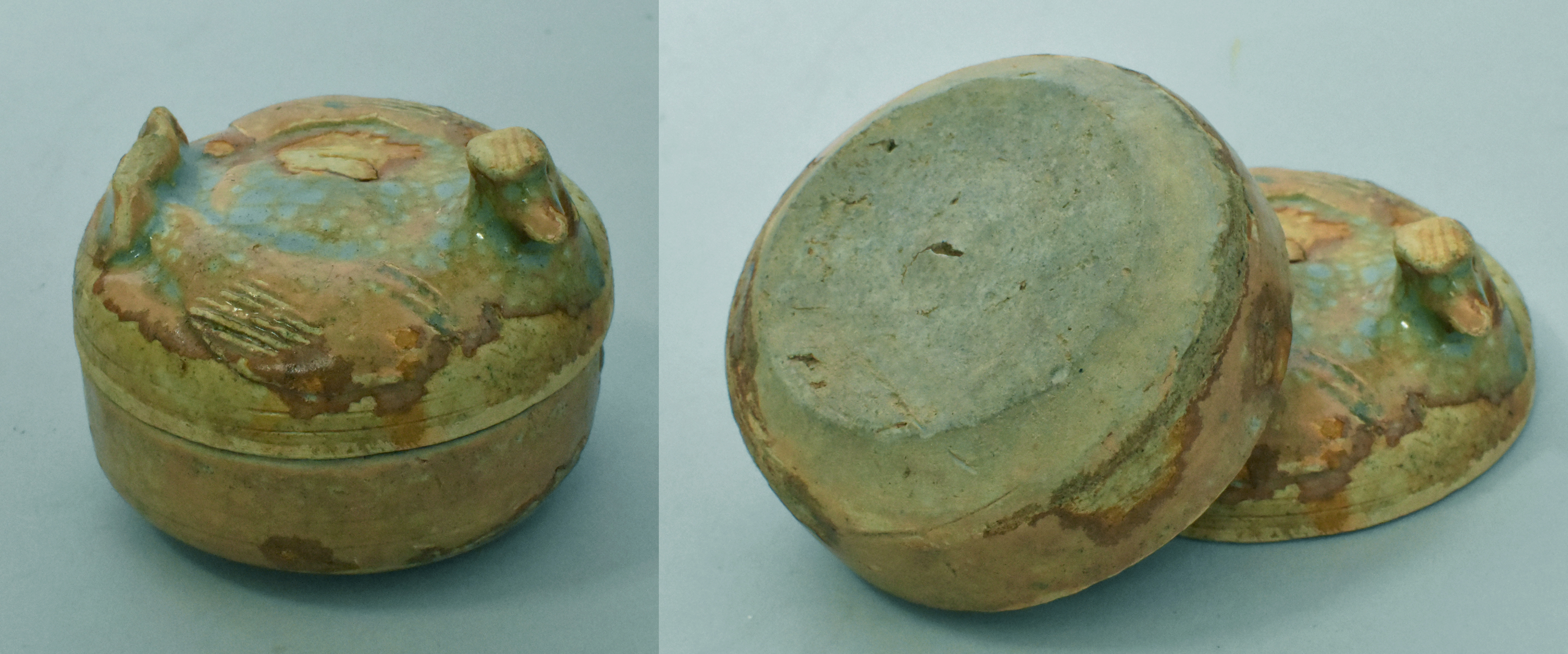 |
| Example with degraded glaze from a wreck near Singkep Island of the Linnga Archipelago. |
Besides iron-brown painted floral decoration on big bowls, Xicun ewer with phoenix head ewer is probably the other most iconic form. Many have the globular body decorated with floral and lotus petals decoration. Two were illustrated in the book on “Guangdong ceramics found in Butuan and other Philippines sites”. I have come across two examples in an antique shop in Vietnam Ho Chiminh city. They were reportedly found in Central Vietnam. Chaozhou Bi Jia Shan also produced quality phoenix head ewers but with light bluish Qingbai glaze.
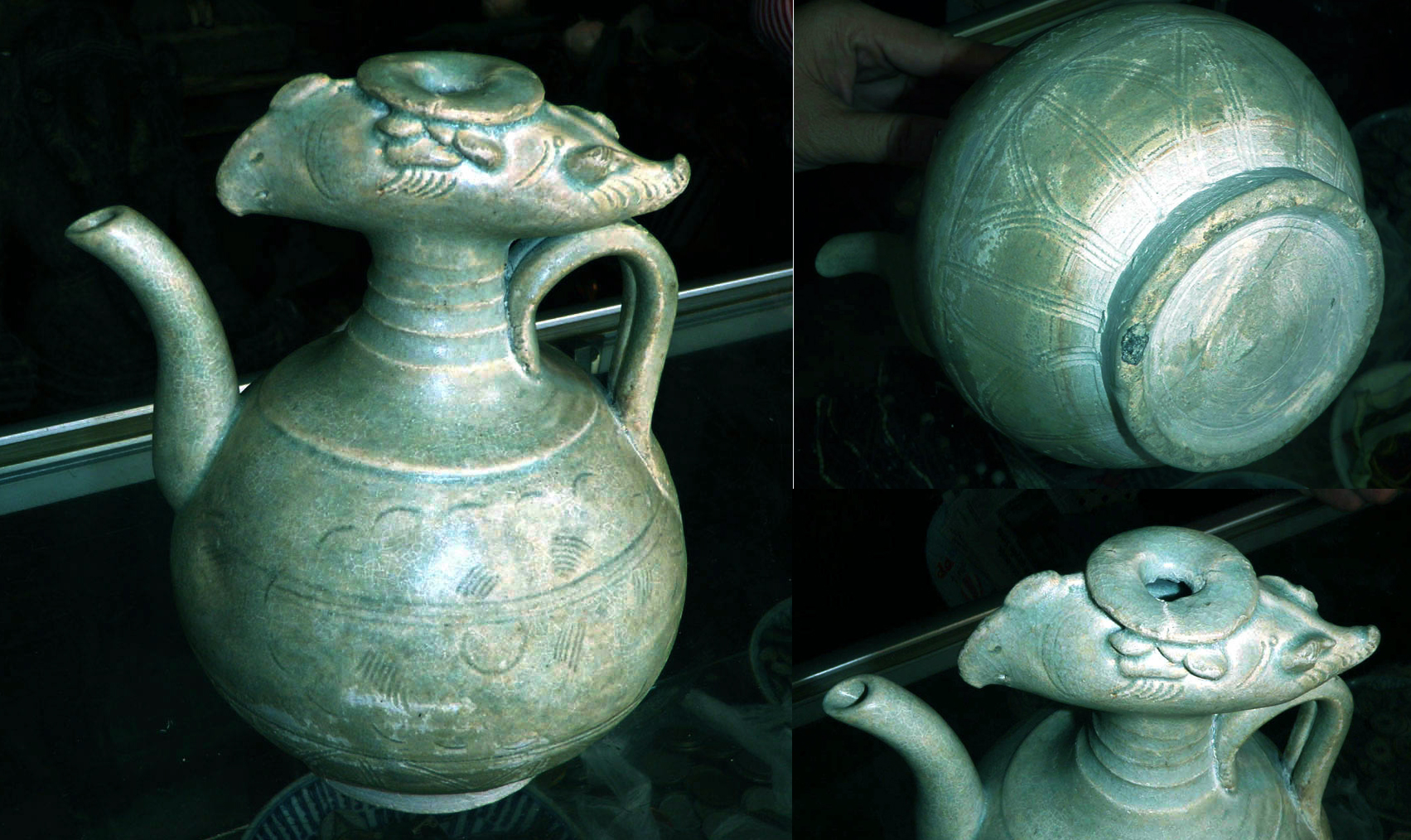 |
| Phoenix head with body decorated with carved floral on the belly and a band of lotus petals in outline form on the lower wall. The floral petals are outlined using stamped arcs. All the decorative elements indicate that this is a late Northern Song Xicun product. This ewer was found in Central Vietnam. |
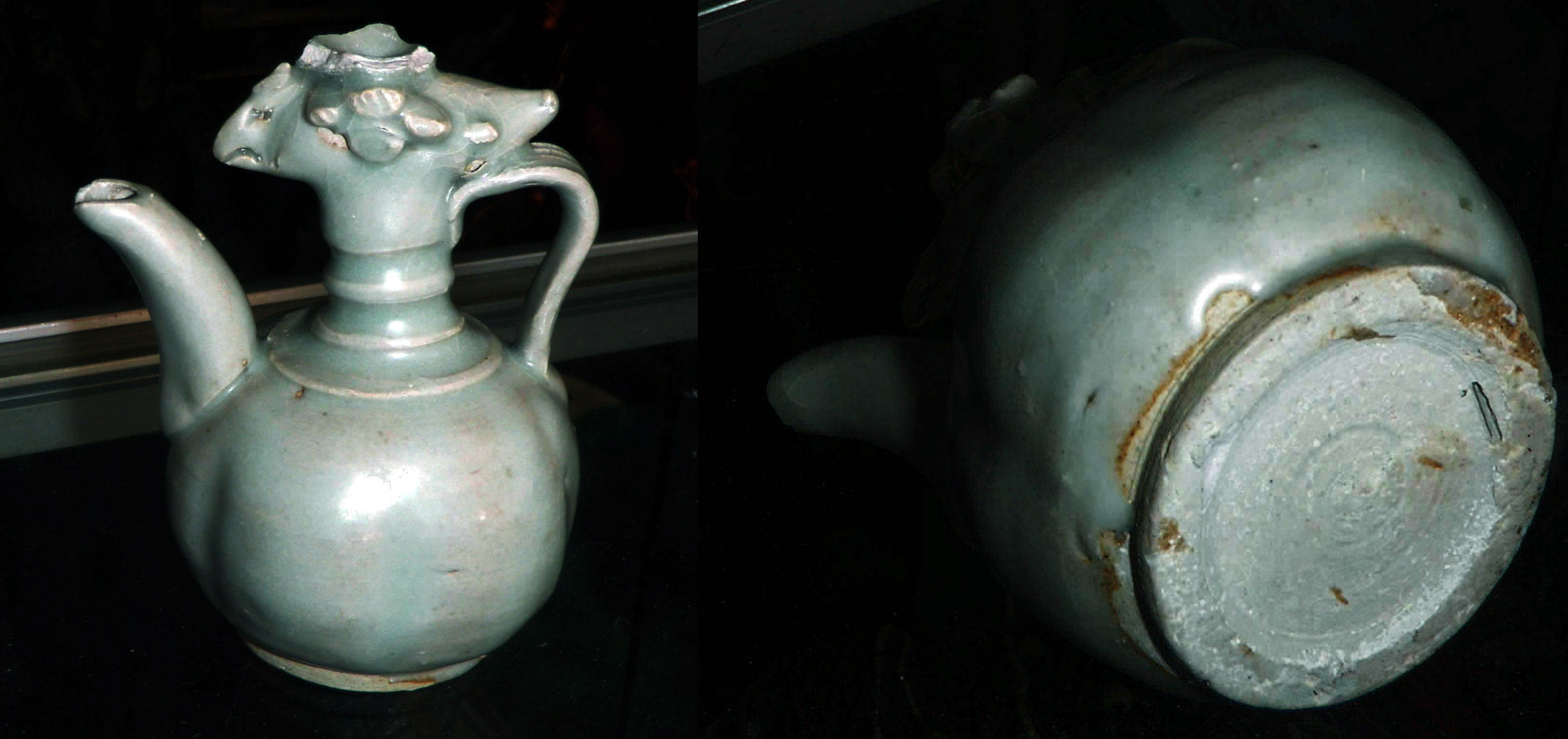 |
| Phoenix head ewer with lobed body. The glaze has a distinct bluish cast in area with thicker glaze. It was found together with |
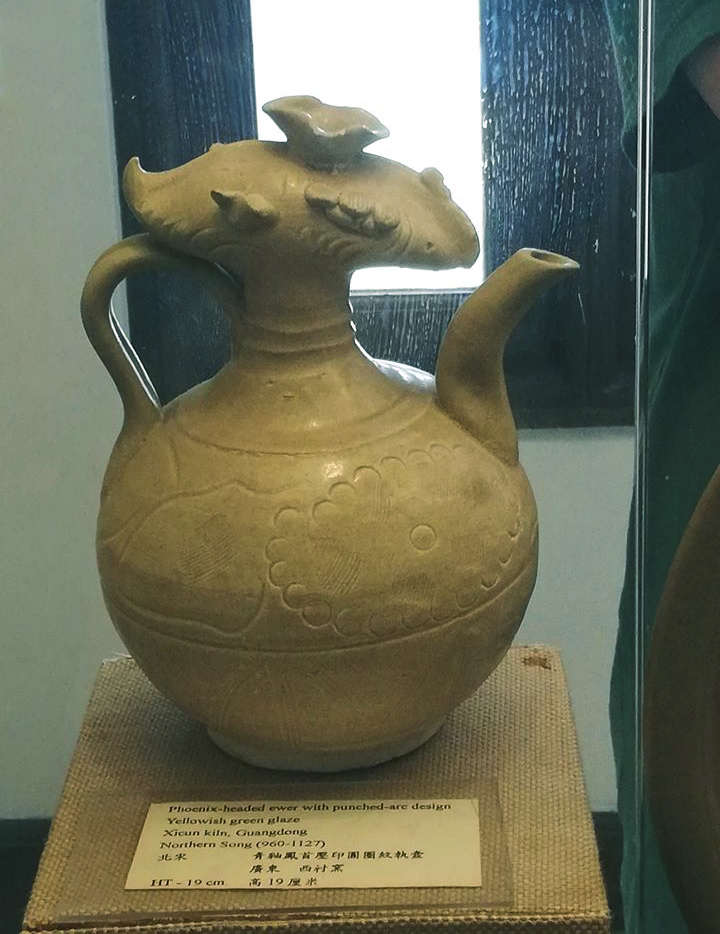 |
| Green glaze Phoenix head ewer in Ching Ban Lee gallery |
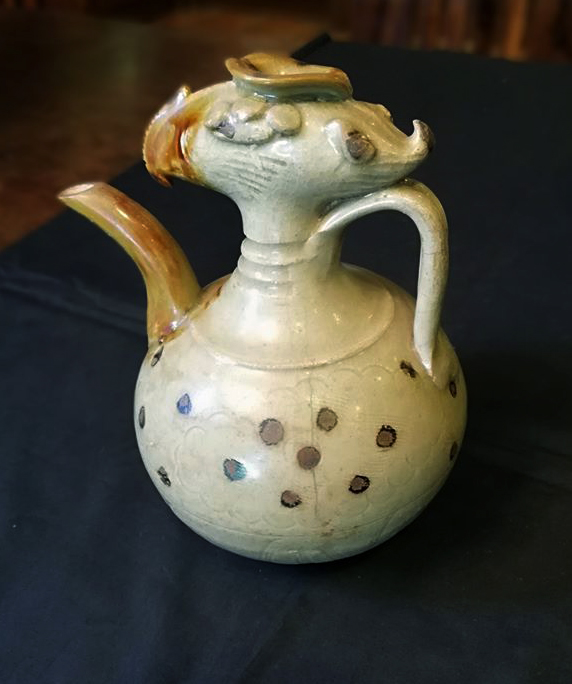 |
 |
| A great example of phoenix head ewer with iron spots from the Bautista Collection |
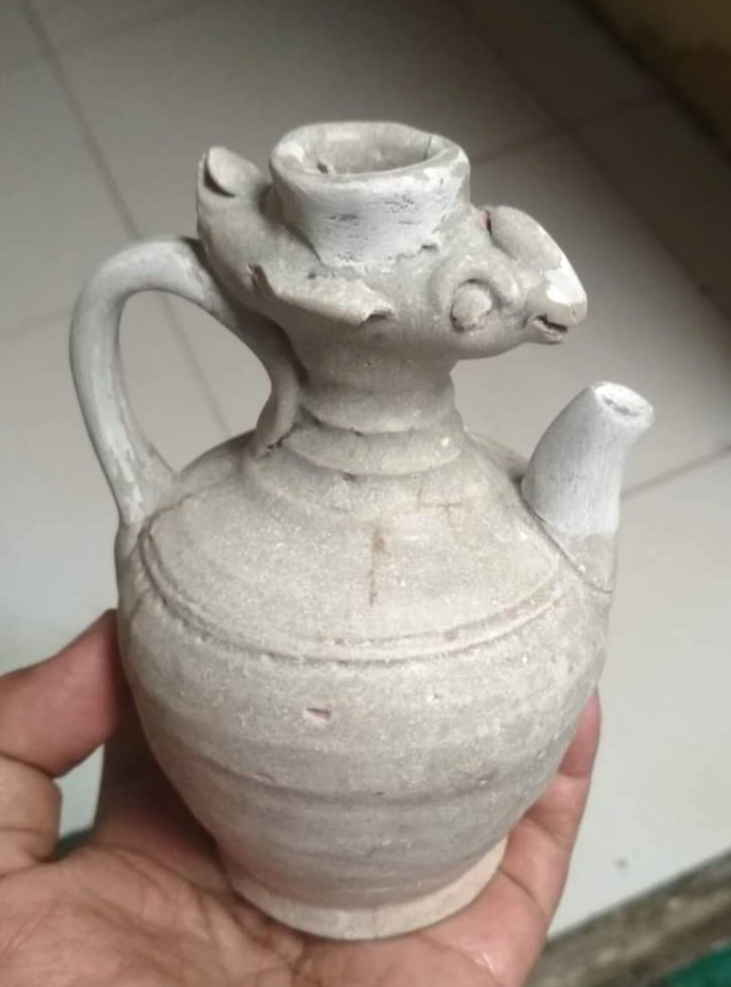 |
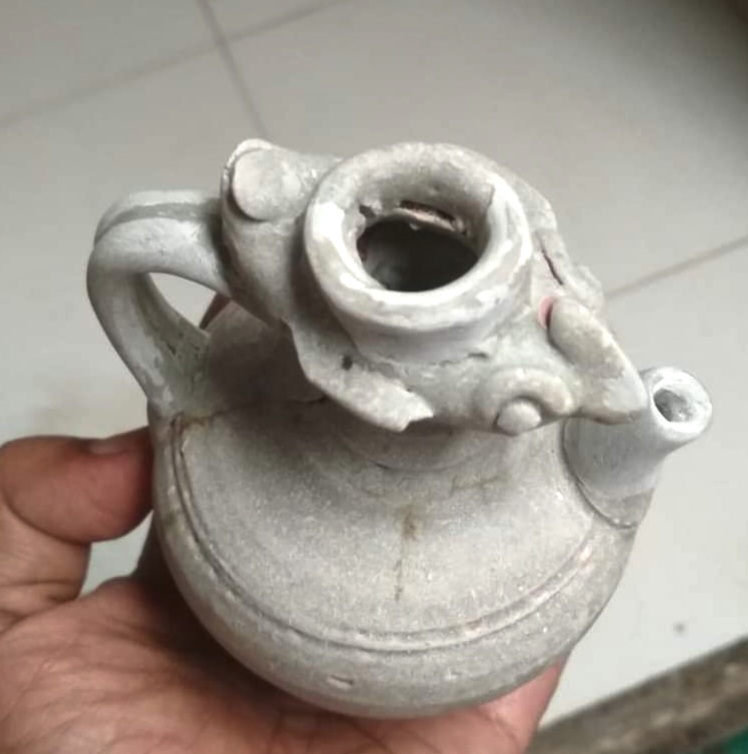 |
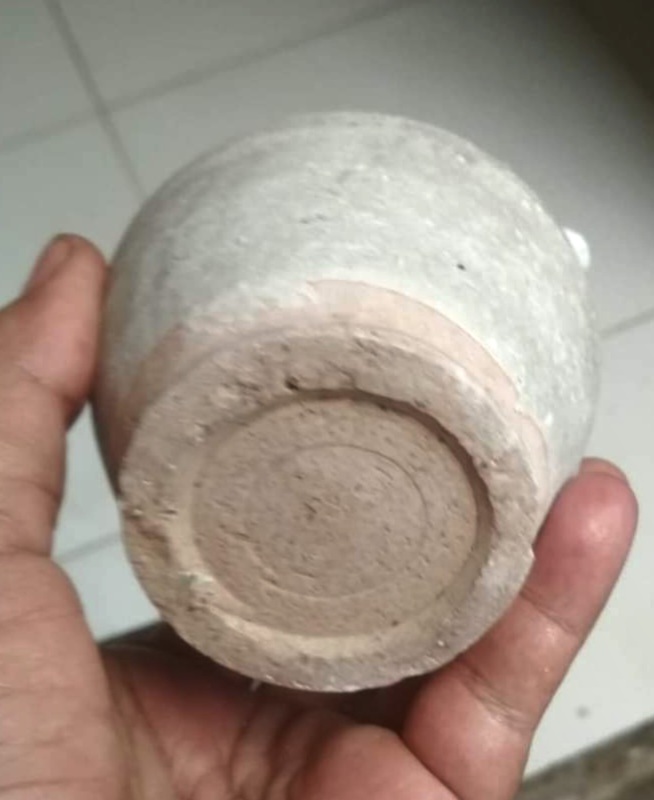 |
| An example found in Sumatra Jambi |
|
 |
| Northern Song Xicun Qingbai bowl with finely incised floral decoration on the interior. Artifact was salvaged from the wreck near Pulau Buaya in Lingga Archipelago in 2018. Similar type was recovered from the Xicun kiln. |
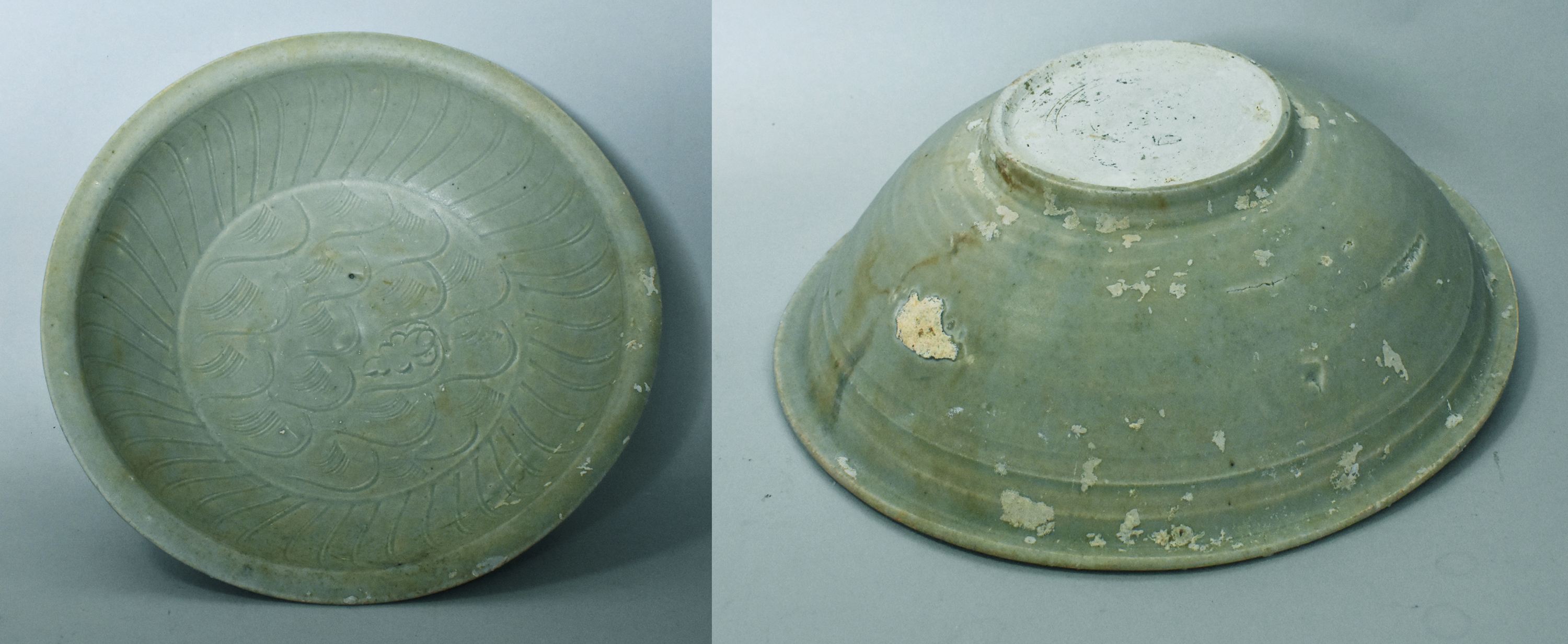 |
| Xicun Qingbai shallow bowl with carved waves motif. There are also some shallow bowls decorated with incised floral decoration similar to above bowl. All came from the same wreck. |
 |
| Qingbai dish with incised floral decoration from a wreck near Karang Cabang, Pulau Buku Limau, East of Belitung Island. Similar floral decoration is known in several Guangdong kilns including those from Xicun and Bi Jia Shan. They originated from the same source as some big grayish green glaze bowls with the stamped arcs floral decoration and hence likely dated to the late Northern Song phase. |
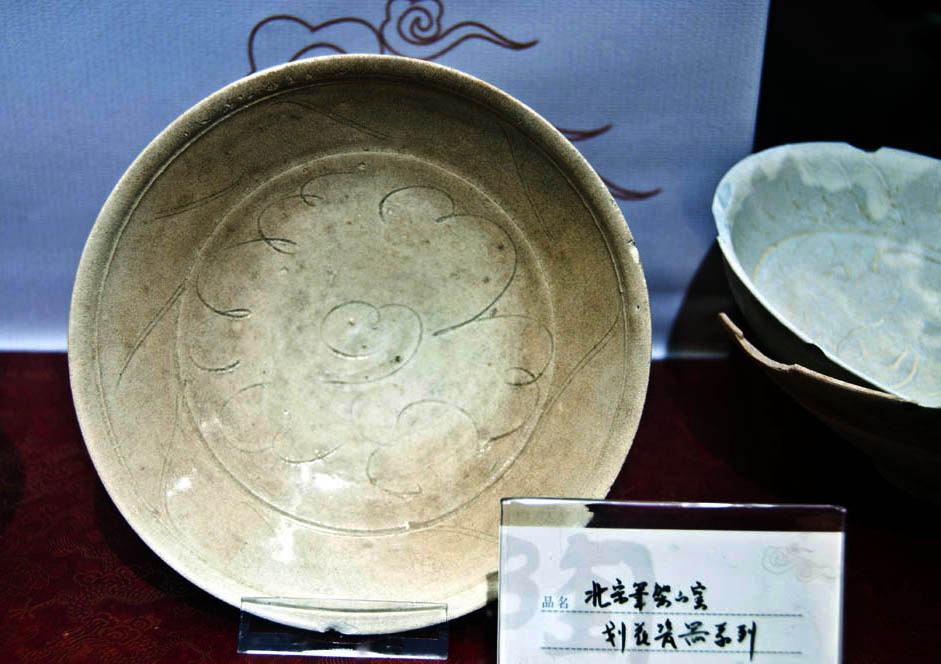 |
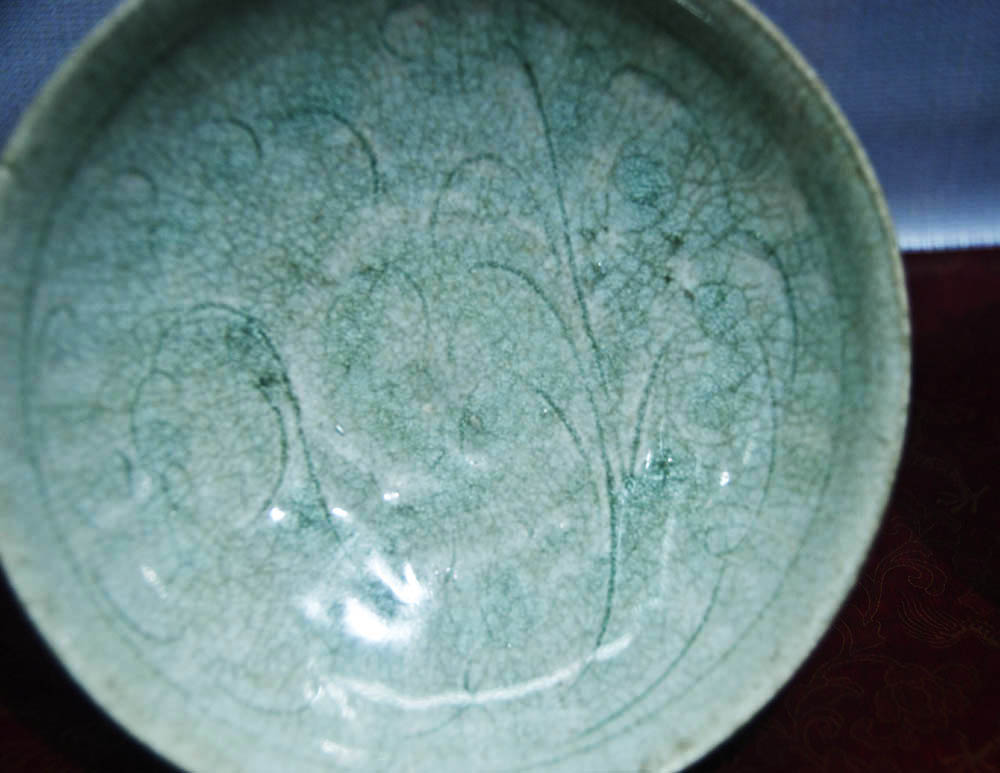 |
|
Two incised floral motif from the Chaozhou Bijiashan kiln exhibited in an exhibition on Chaozhou wares |
|
More examples of bowls with carved floral decoration from the Bijiashan and Huizhou Dongping kiln. They are not easy to tell apart without physical inspection.



Examples likely from Chaozhou Bijiashan kiln
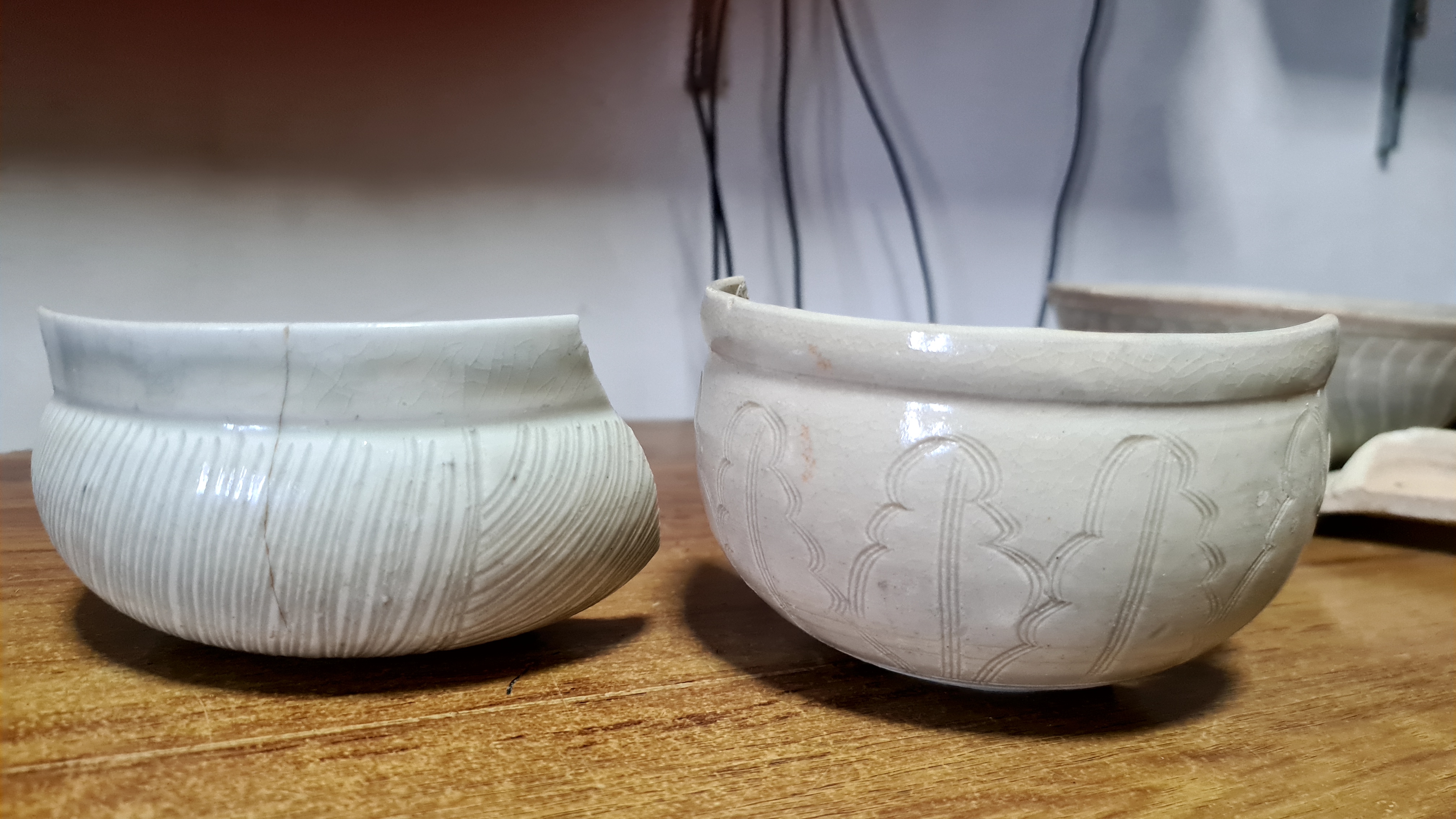
Shipwreck examples likely from Huizhou Dongping kiln
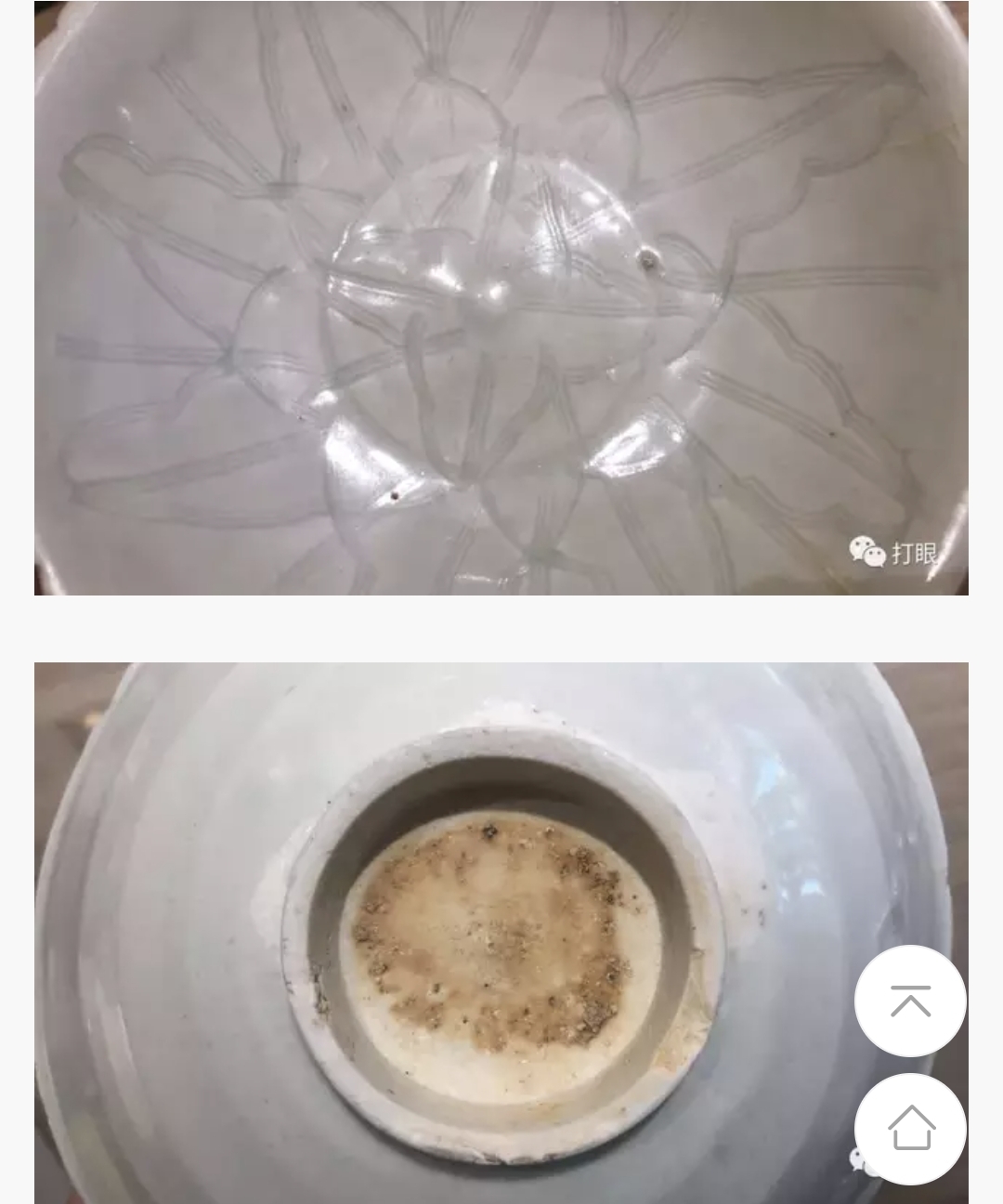
Qingbai example from Fujian Zhangpu kiln
 |
| Examples from the Riau wreck. The shards are from the Bijia Shan kiln which show the similarity in terms of glaze and paste. |
 |
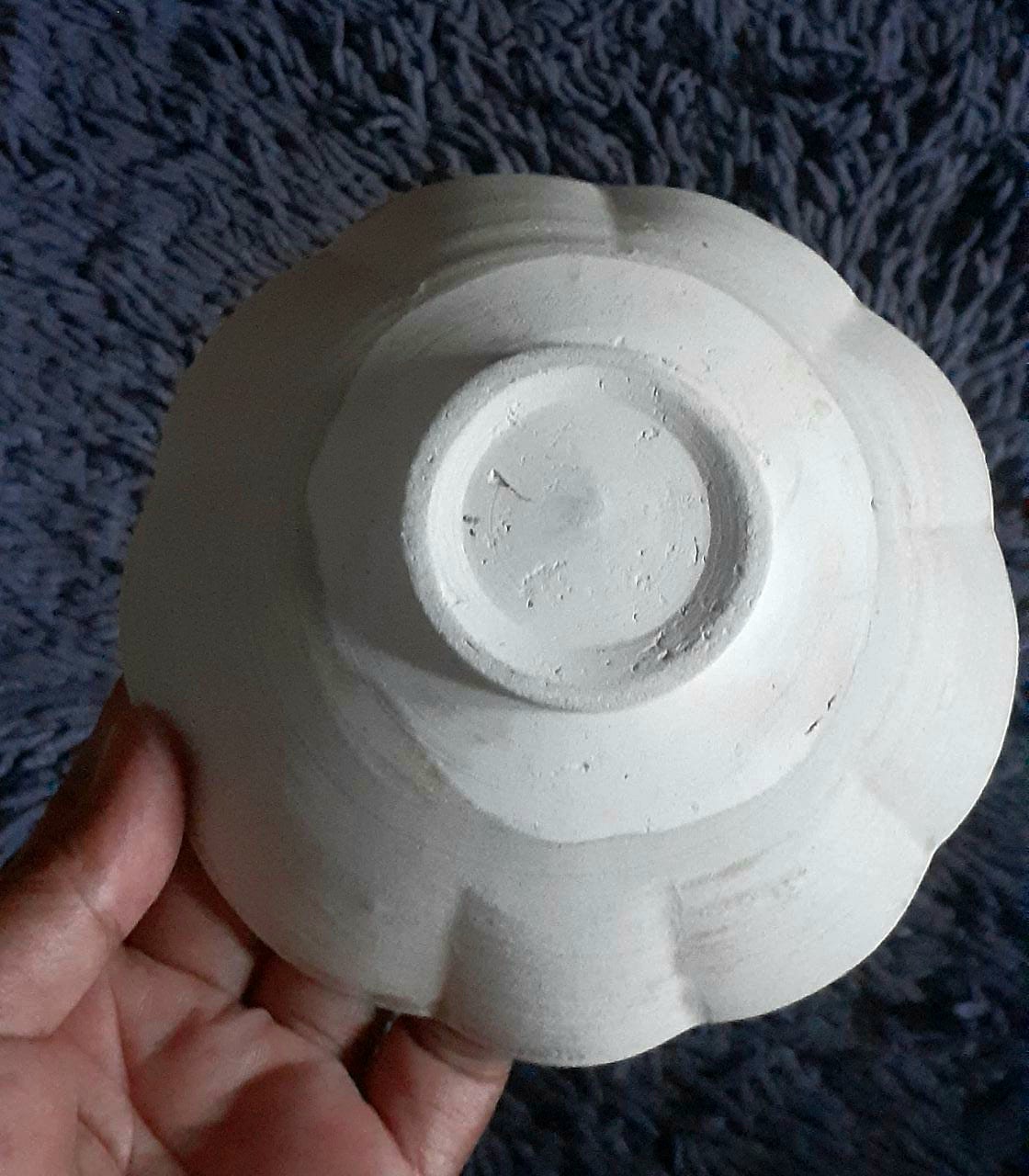 |
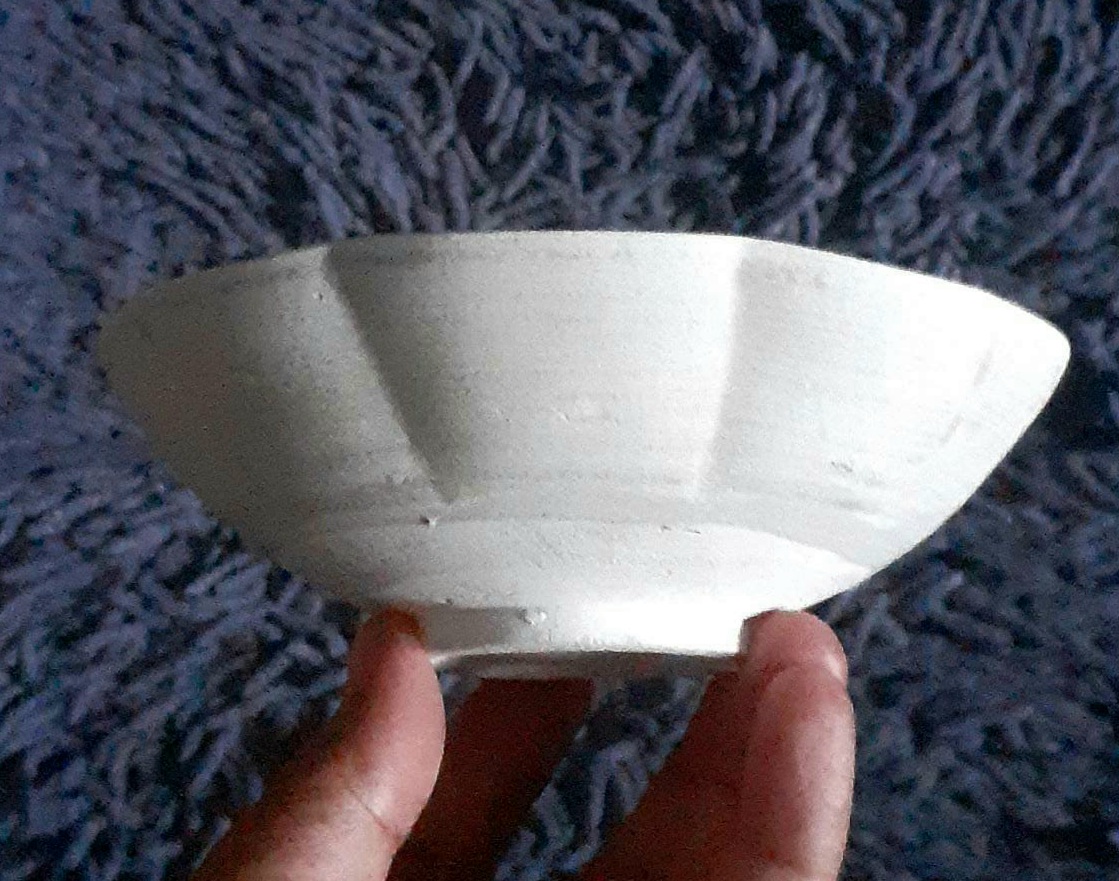 |
| Qingbai bowl with lobed body. Likely a product of Chaozhou kiln. From a wreck near Karang Cabang, Pulau Buku Limau, East of Belitung |
|
|
| Group of Qingbai cover boxes. The one on the right has carved floral decoration on the cover. This floral style is known on Xicun and Bi Jia Shan products. The one on the extreme right and small one on the left are from Fujian Nanan kiln. A key different is they have flat base while the Guangdong versions have recess foot. |
 Two more examples
of shipwrecked cover boxes. Two more examples
of shipwrecked cover boxes. |
| Various forms of Qingbai tall cover boxes from the Bijia Shan kiln |
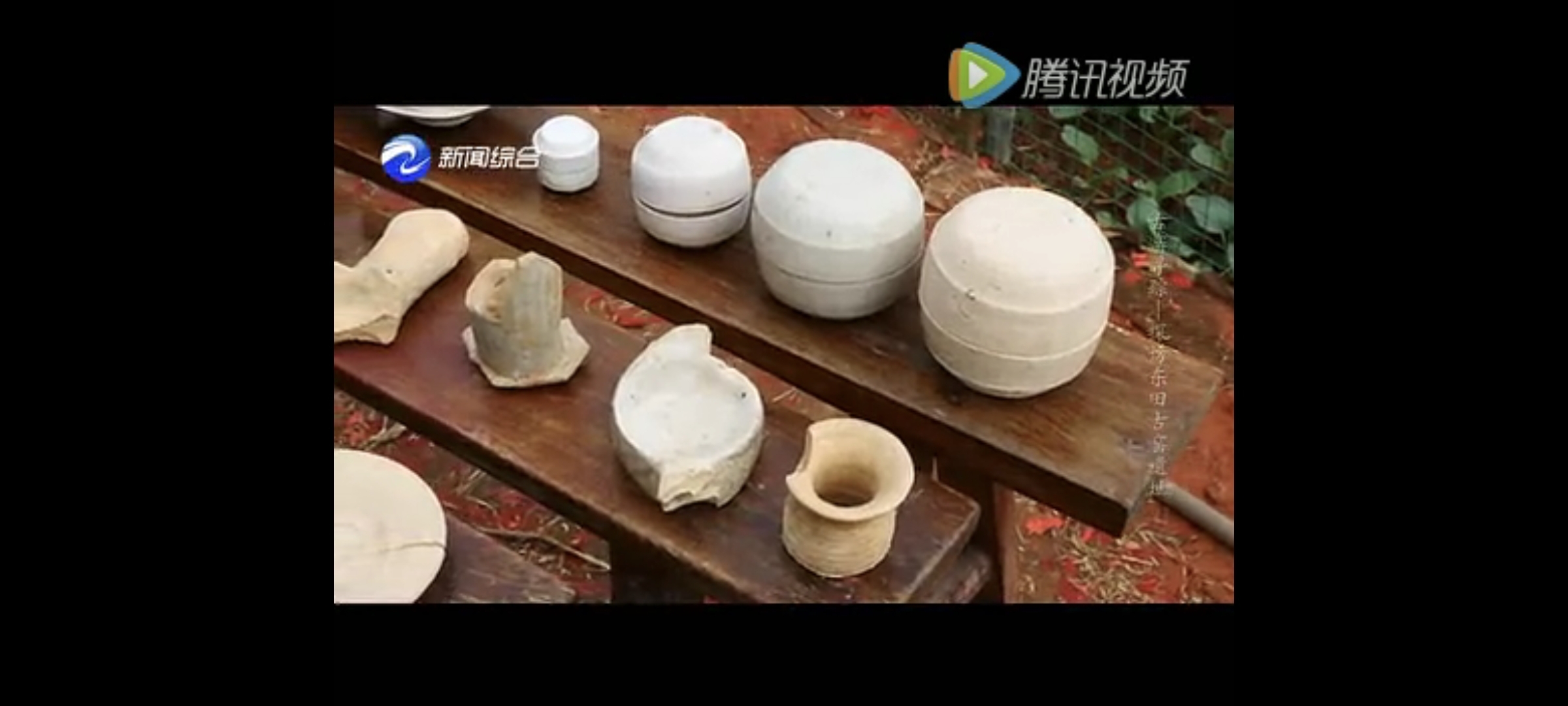 |
| Excavated examples from Nanan kiln |
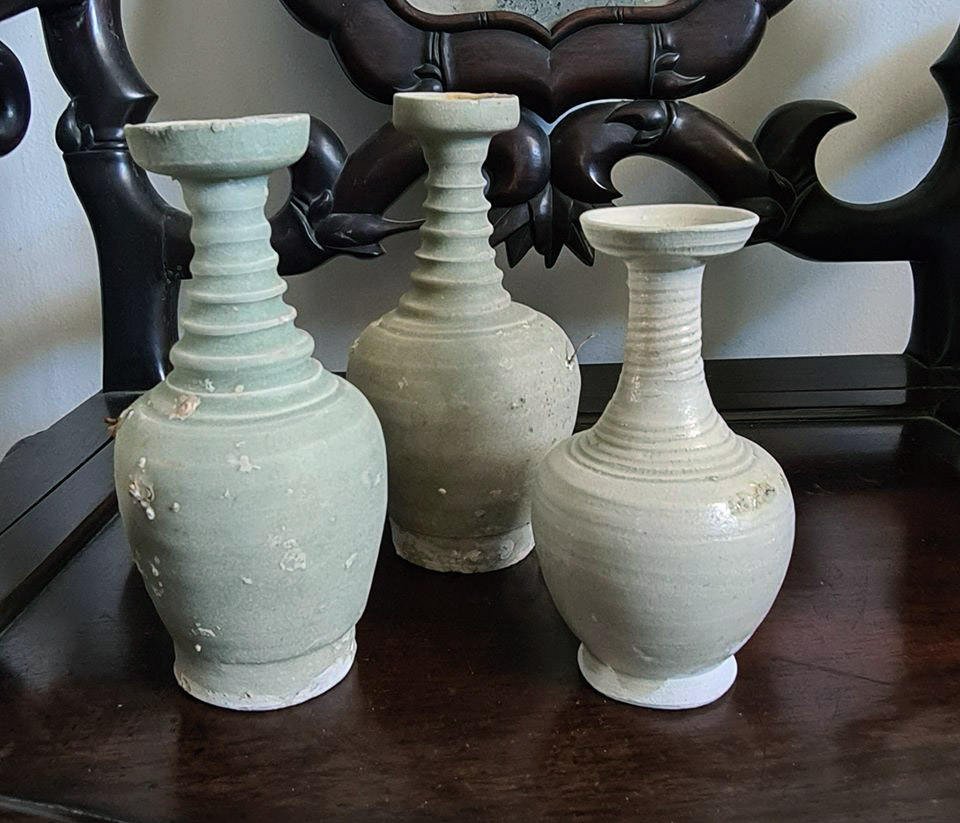 |
| 3 qingbai small vases with ribbed neck from the Lingga wreck. Two on the left from Xicun and that on left from Xicun kiln. |
|
|
|
Three Chaozhou kiln Qingbai examples which has whiter paste and clear Qingbai glaze. The potting and the foot is usually more refined. |
|
| This version with flat base could be from Fujian Nanan kiln | |
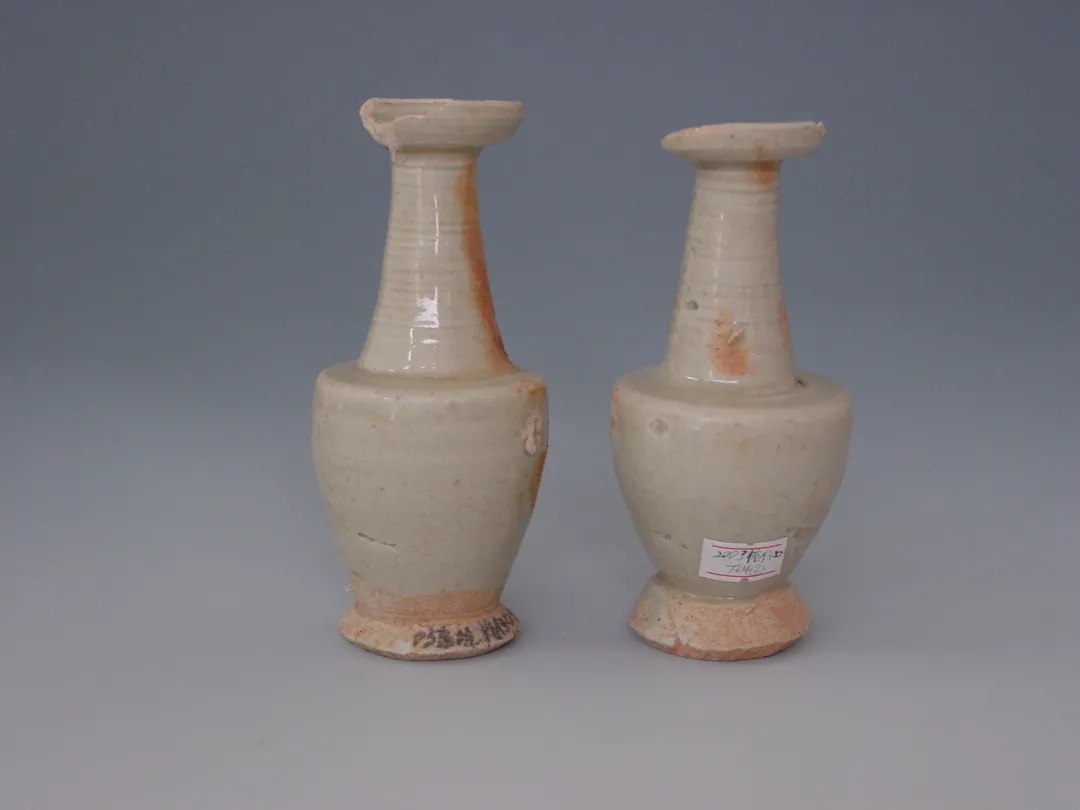 |
|
| Examples from Nanan Museum | |
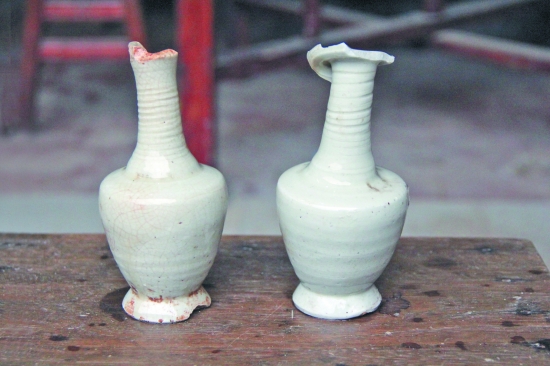 |
|
| Excavated examples from Nanan | |
.jpg) |
| Light grayish green jar (height around 30 cm)with 4 lugs and carved slashed lines on the shoulder from the Lingga. A jar with similar form and decorative features but more elongated and further decorated with iron-brown painted floral decoration was found in the Xicun kiln. Such jars without floral decoration and more elongated in form were also found in the 1989 Pulau Buaya wreck. |
The use of lotus petals in high relief form is popular both in green glaze and Qingbai form. They could be found in products from Xicun and Bijiashan.
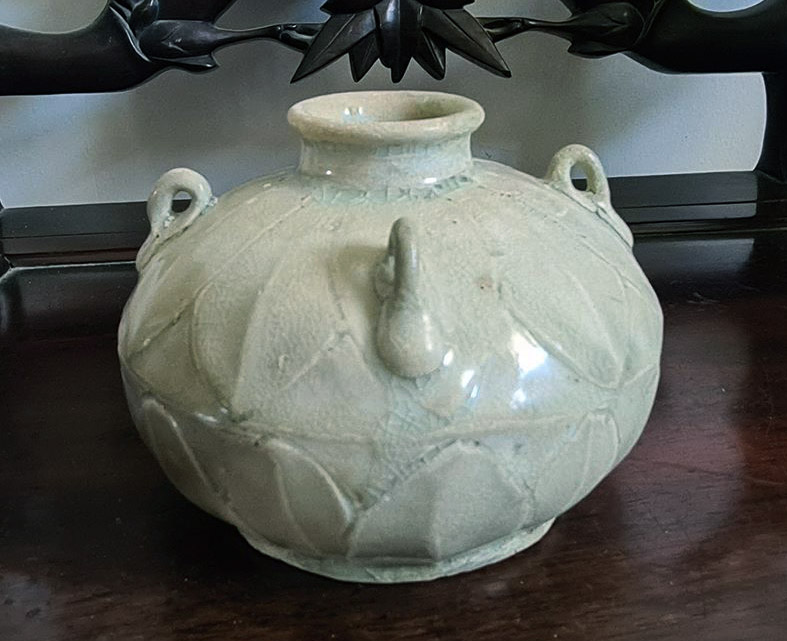 |
| Qingbai jar with high relief lotus petals decoration. Likely a product from the Bijiashan kiln. |

|
Two examples of carved lotus petals of incense burners from Bijiashan kiln |
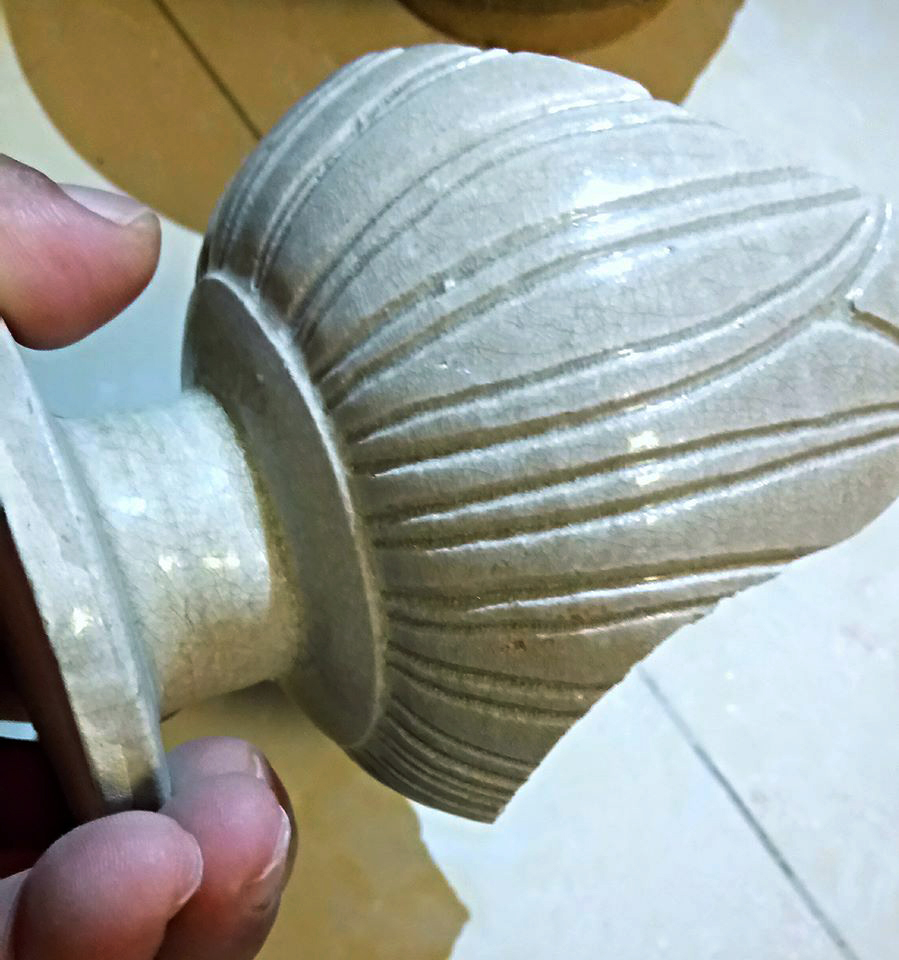 |
 |
| Qingbai censer likely from Chaozhou or Huizhou region |
Phoenix head ewers were also made in Chaozhou kilns. They have qingbai glaze which is light bluish in colour tone and has whitish paste. The features of the phoenix head are also different, typically more fine and intricate in details.
 |
|
|
A qingbai phoenix head from Chaozhou kiln |
A qingbai phoenix head vase in Hainan Museum |
Chaozhou Beijiashan also produced of distinctive white glaze fish-shaped ewer.

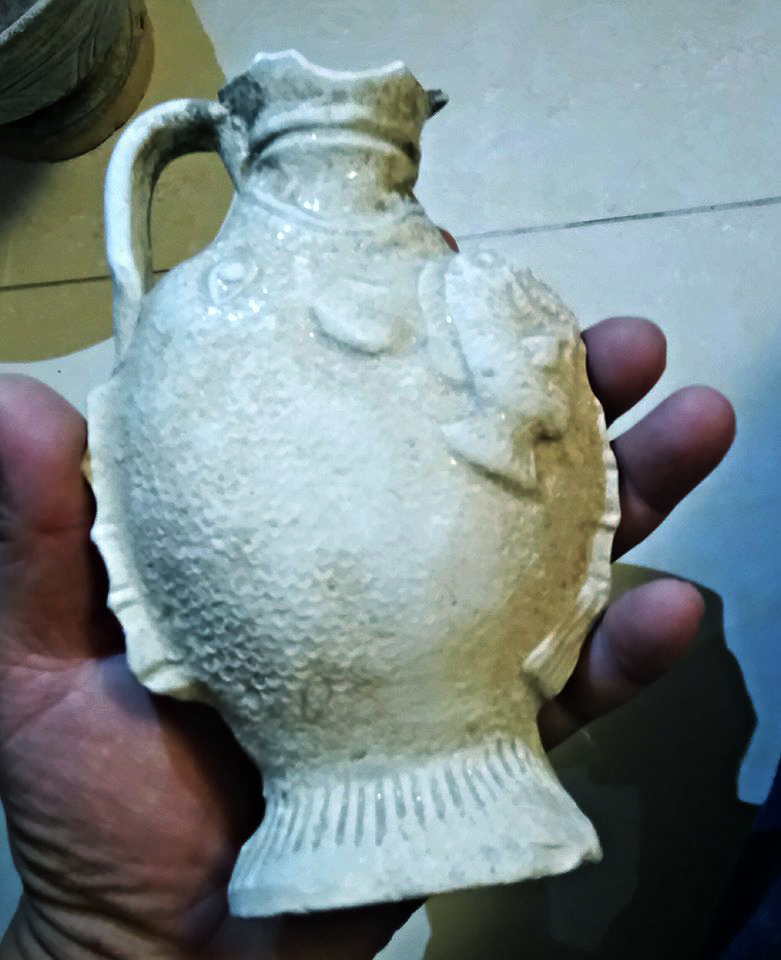 |
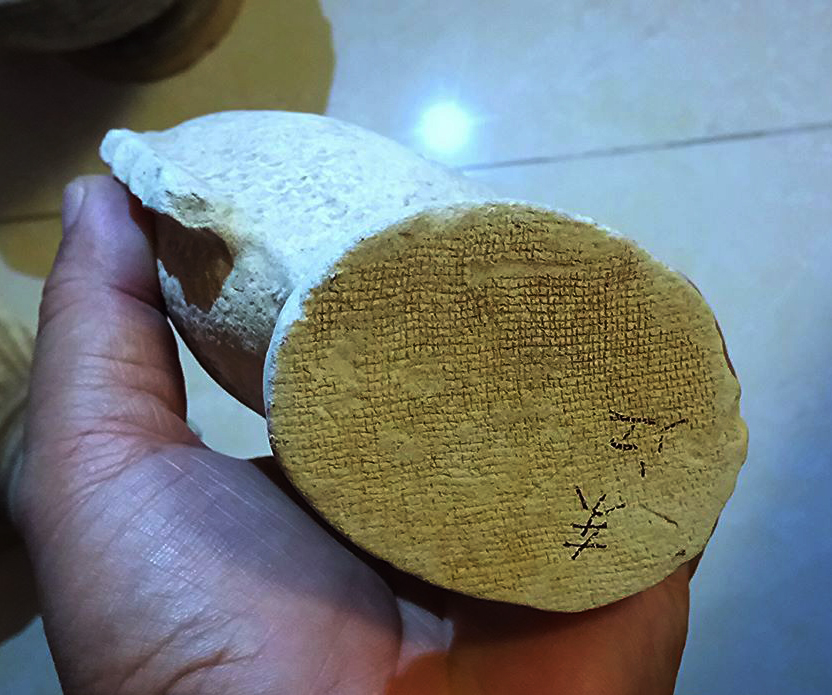 |
| Qingbai
fish-shaped ewer recovered from river Dong Jiang in Guangdong |
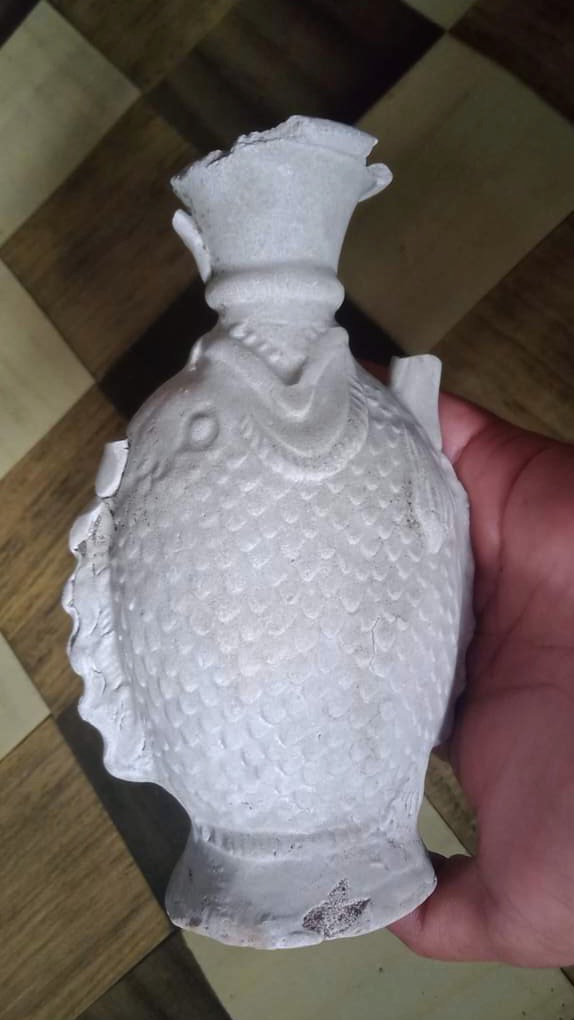 |
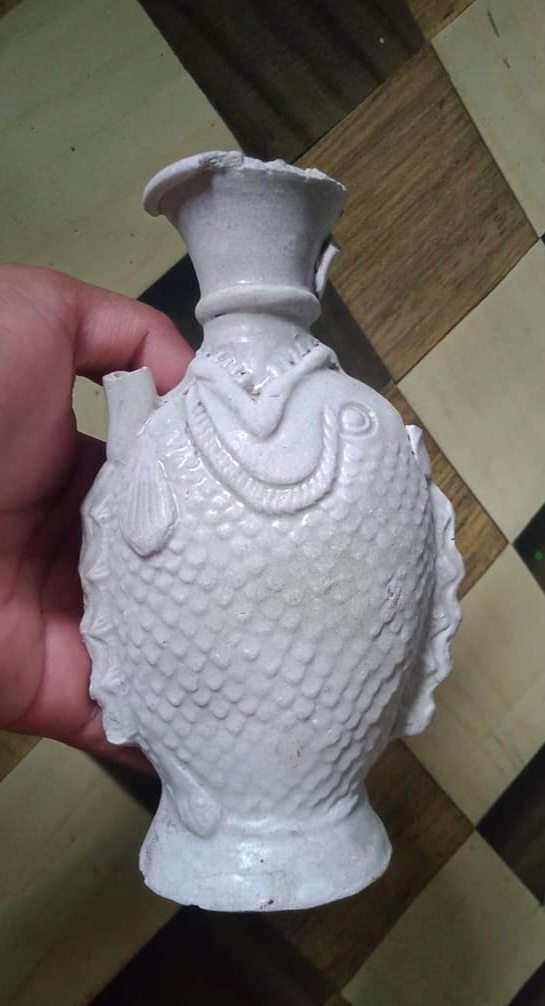 |
 |
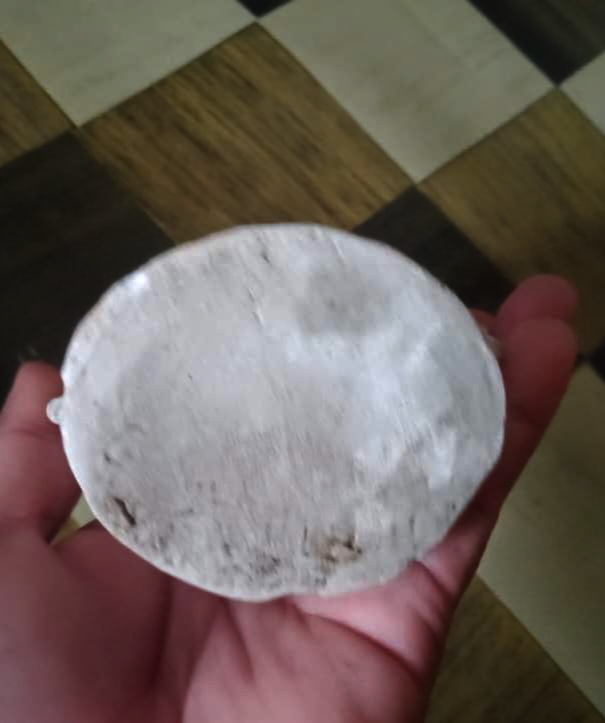 |
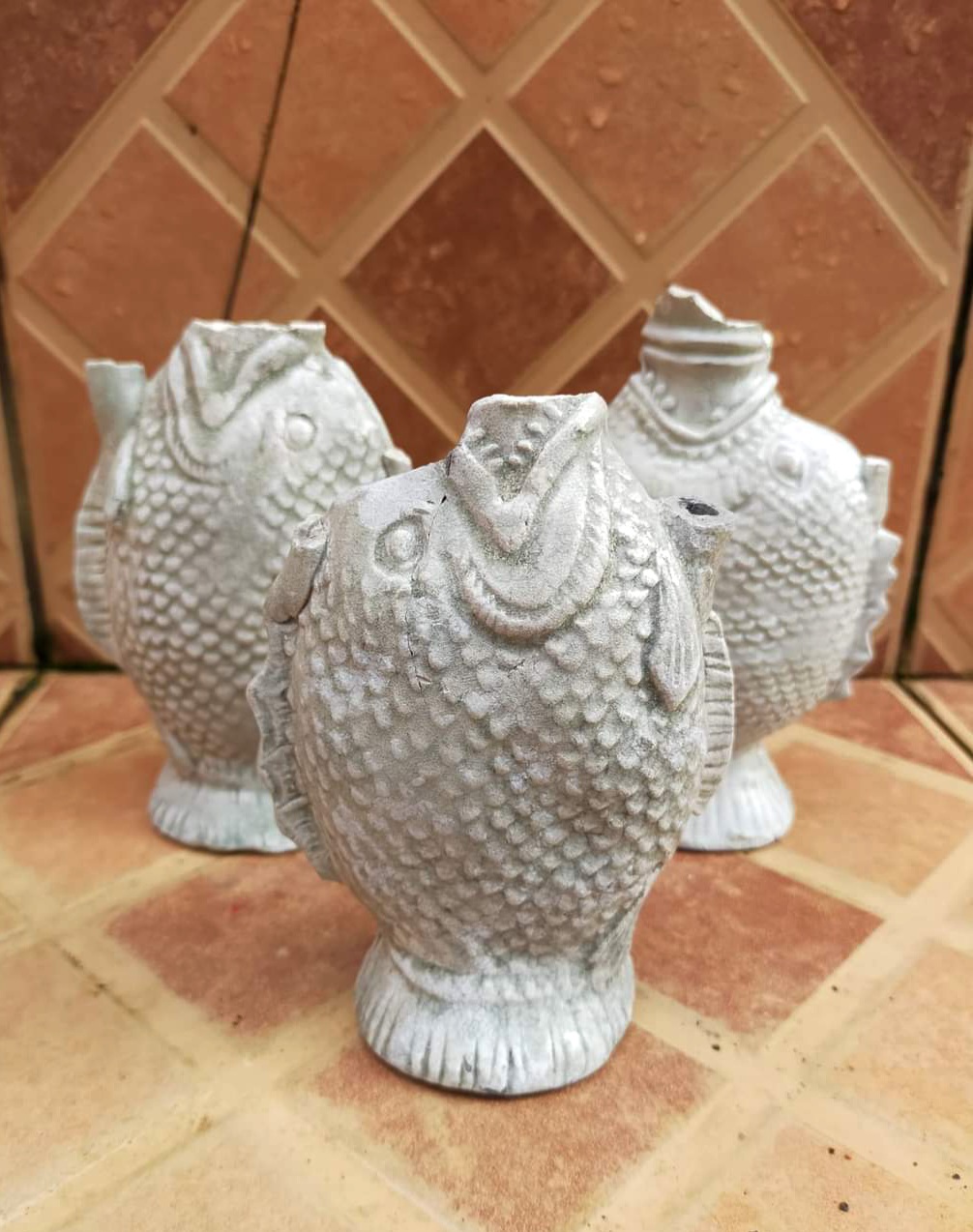 |
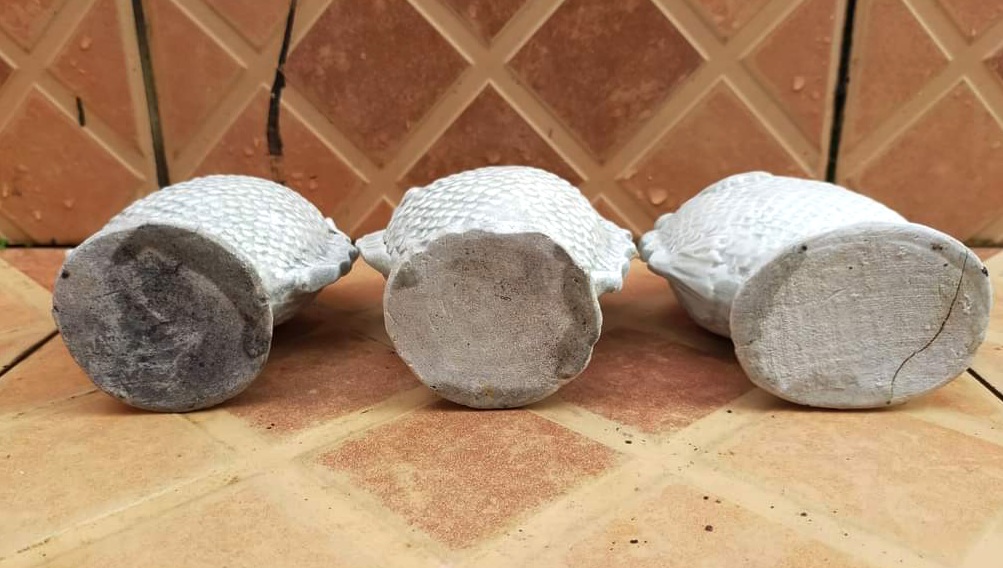 |
| Some examples found in Sumatra |
Another interesting category of products from the Bijiashan kilns are Qingbai/white human and animal figurines.
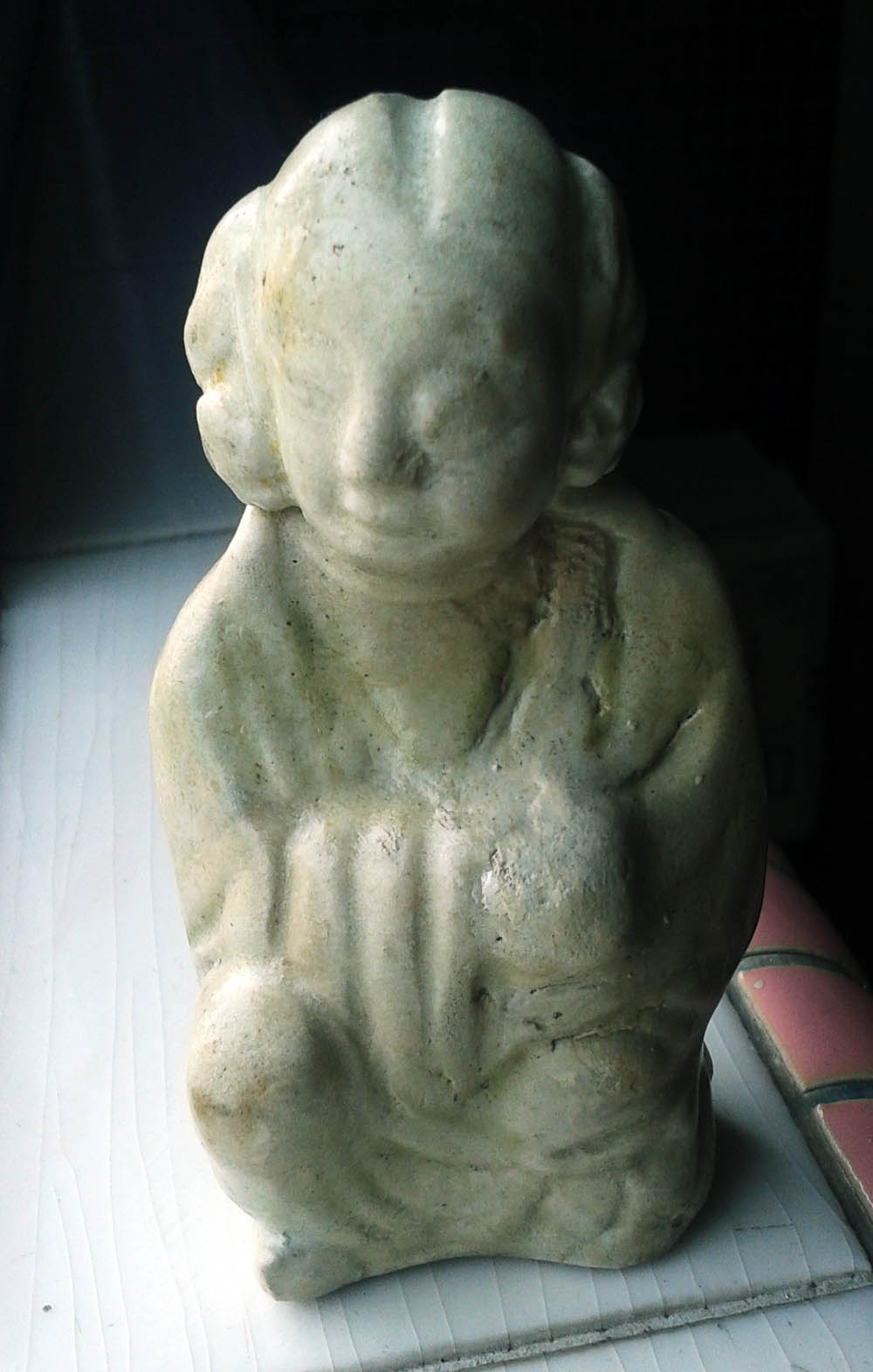 |
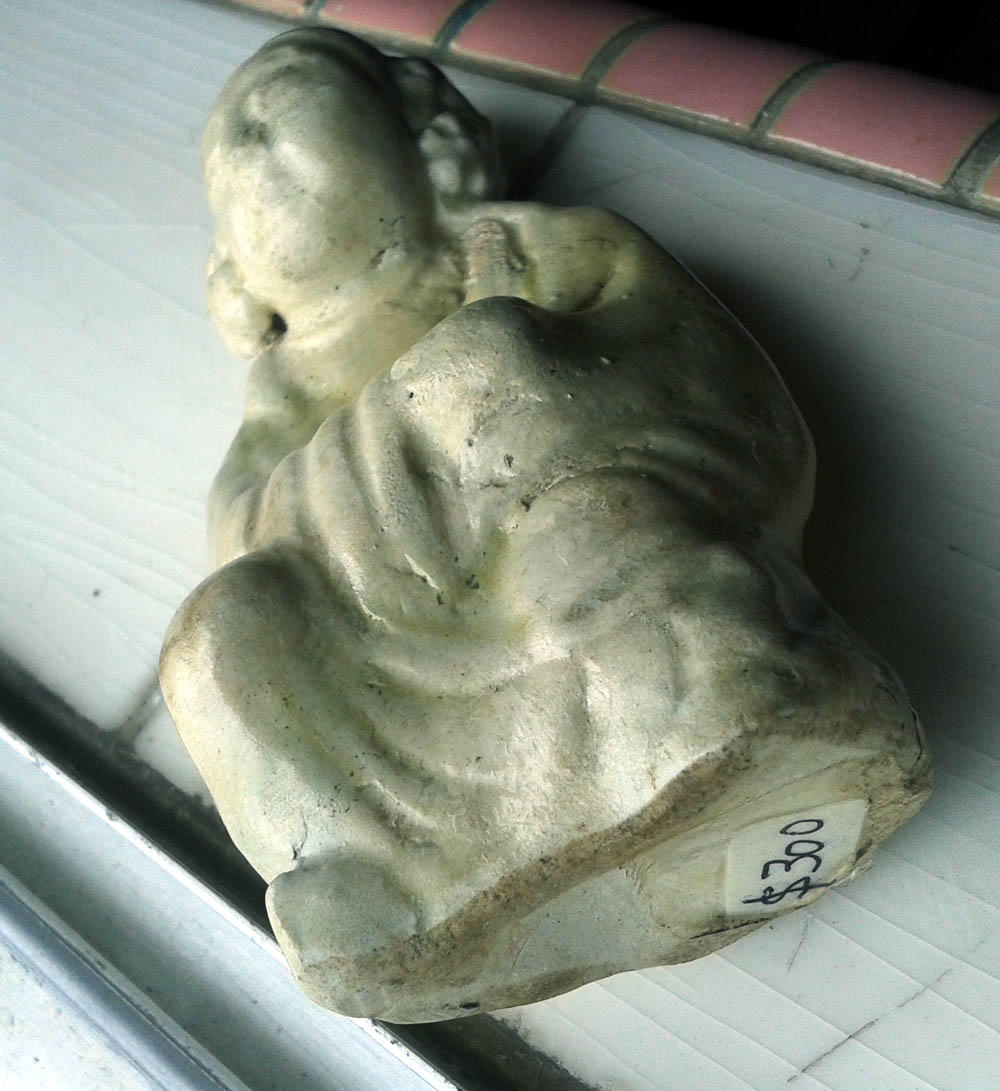 |

Examples from the Bijiashan kiln sites
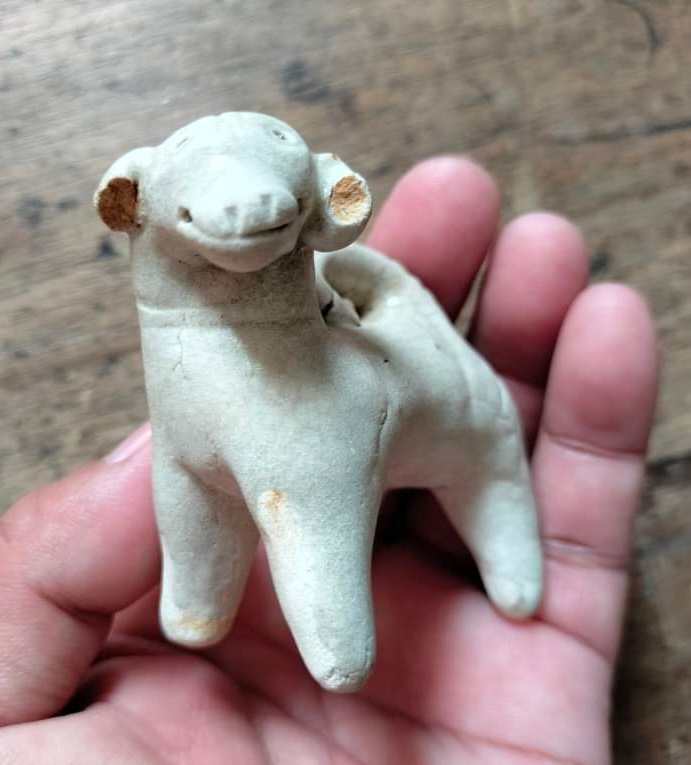 |
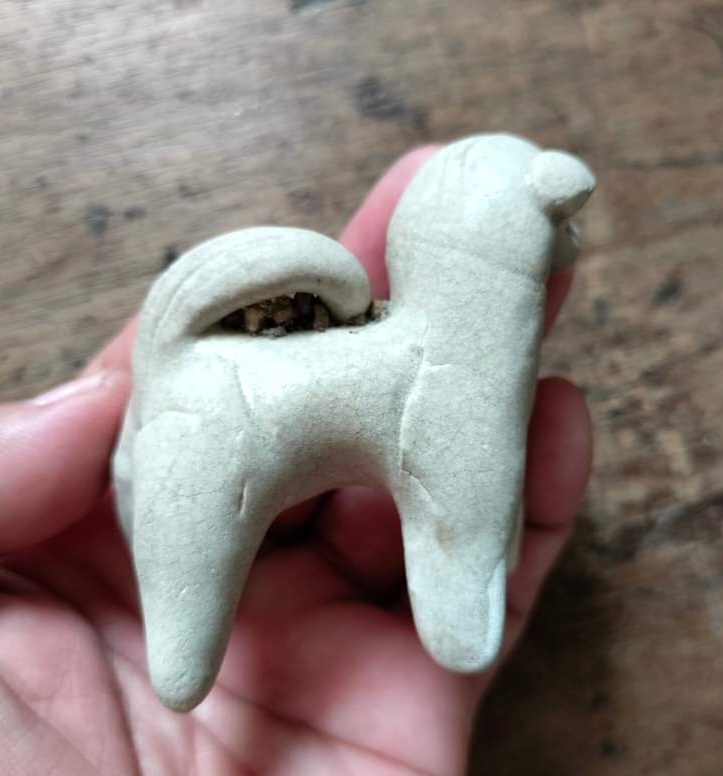 |
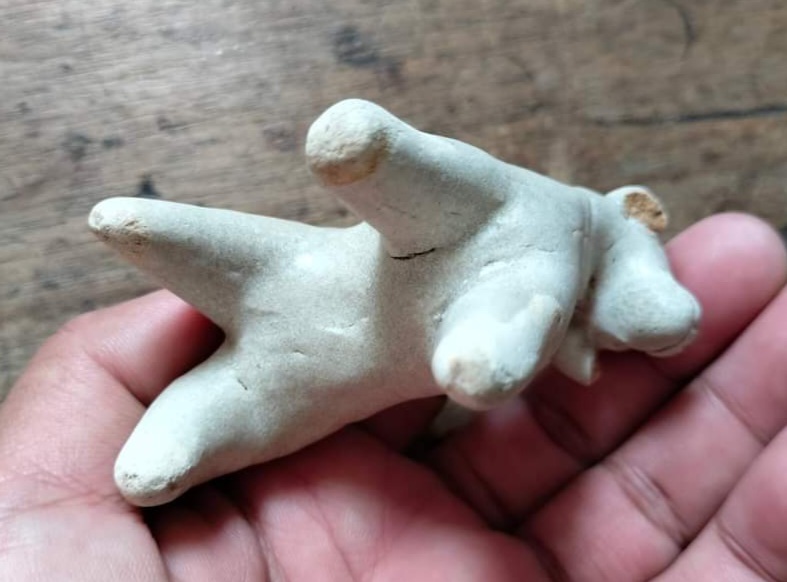 |
| Qingbai dog figurine found in Indonesia Sumatra Jambi |
Xing white glaze bowl with thickened lip was an iconic vessel form of the Tang period. From the abundant find in Southeast Asia, we note that this particular bowl form had an enduring special appeal and particularly long production cycle. However, during Northern Song the foot has evolved and no longer the disc like yu-bi form (玉璧底). Based on land excavations and shipwreck information in Southeast Asia, the bulk of those dating to the Northern Song period can be traced to Guangdong origin. As compared with the more whitish tone of Xing/Ding, the glaze of the Guangdong version is generally more grayish white in colour tone. Many other white glaze bowl forms were also introduced by the Xicun potters. In the book "Guangdong Xicun Yao" published by Hongkong Chinese University in 1987, 12 basic forms were identified. Grayish white remained the predominant colour tone but there are also those which appear more white or qingbai in hue. Illustrated below are some of the most common forms found in shipwrecks.
|
|
| A thickened lip grayish white glaze bowl from Xicun Huangdi Gang |
In some of the wrecks near the Lingga and Singkep Island, there are bowls with a thickened lip. Majority of the bowls are of grayish white colour tone. They are generic product and not easy to attribute such bowls to a particular kiln as they were produced in many kilns in China. Many examples could also be found in Chaozhou kilns. The Pulau Buaya wreck also carried large quantity of such bowls. The coarse foot is different from those from Guangdong and one likely kiln which produced them was Southern Fujian Zhangpu Zhu Shushan kiln. For more information, please read this article.
|
|
|
 |
|
|
Two examples of thickened lip bowl from the Linga wreck. The bottom bowl with traces of spiral marks on the outer wall could be from the Xicun kiln. In comparison to the top example, it also have a more coarse paste and roughly formed foot. There are some kiln rejects from the Xicun kiln with similar physical characteristics. |
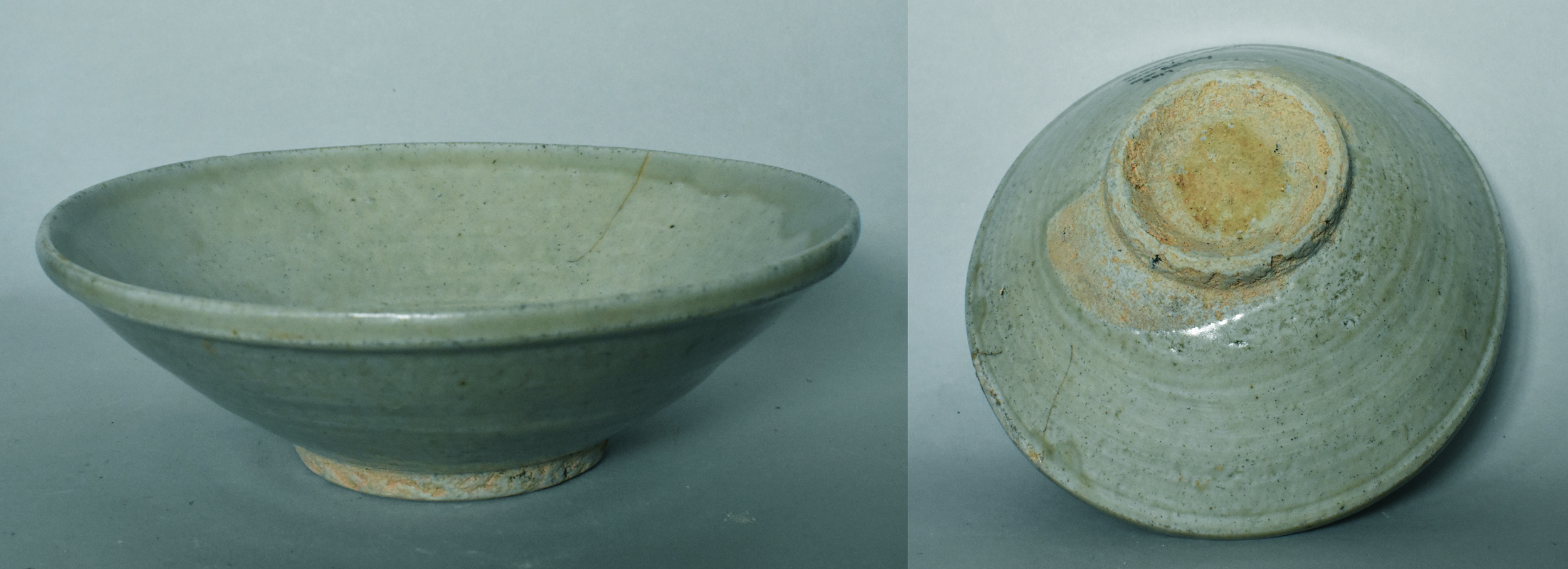 |
| This bowl came from a wreck near Indonesia Singkep Island. It has a more shallow foot. Similar bowls were found in large quantity in the Pulau Buaya wreck. Likely product of Southern Fujian Zhangpu kiln. |
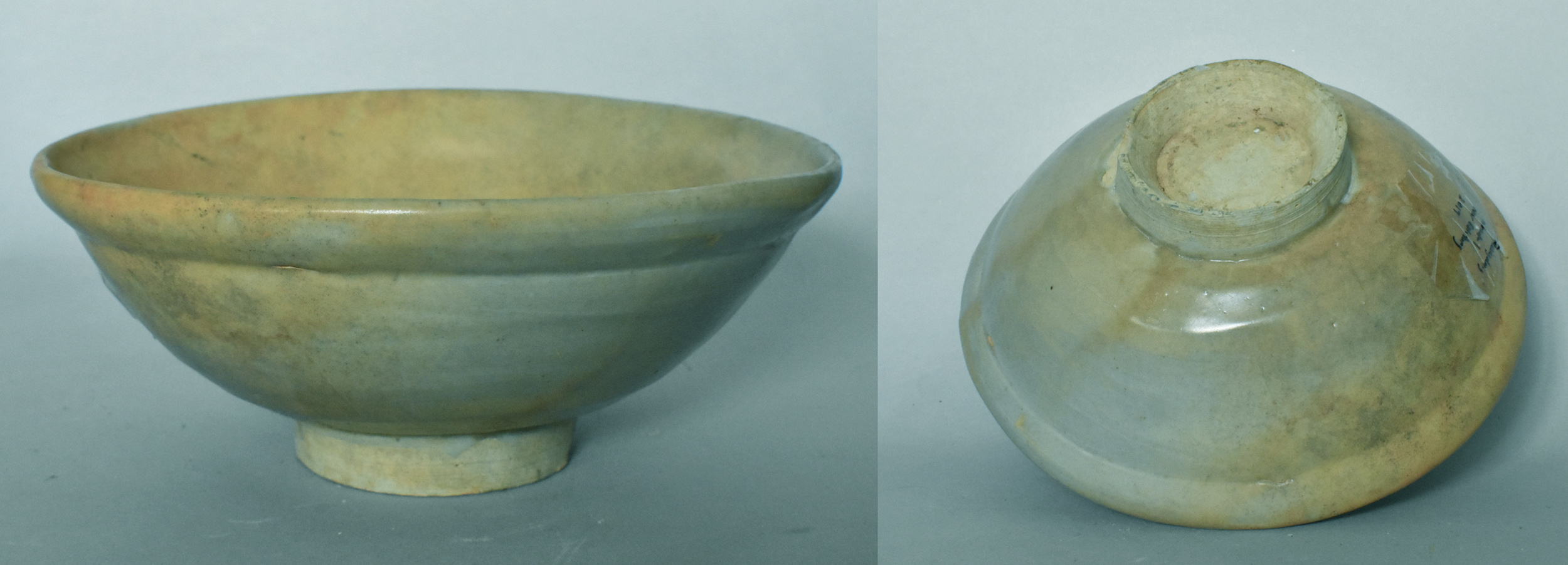 |
| Example from a wreck near Indonesia Singkep Island |
Among the Guangdong kilns, those in Xicun, Yangjiang (阳江 ) and Huizhou ( 惠州) were known to produce a form of Yaozhou style floral motif bowls. Yaozhou molded floral decoration was first introduced during the Mid Northern Song period. It gained popularity and was widely produced during late Northern Song. It is likely that Guangdong potters started copying such decoration after it became an established and successful product during the late Northern Song period. As compared to the Yaozhou counterpart, the molded motif is generally not as sharp and pale in quality. But there are exceptions to this general perception. I came across one broken fragment with superb quality molded decoration. It was reportedly found in a well in Guangdong and is illustrated below. Comparatively, the number found in Southeast Asia is relatively small in number. There were two pieces illustrated in the book "Guangdong Ceramics from Butuan and other Philippine sites". An example is also illustrated in the book on Pulau Buaya wreck.
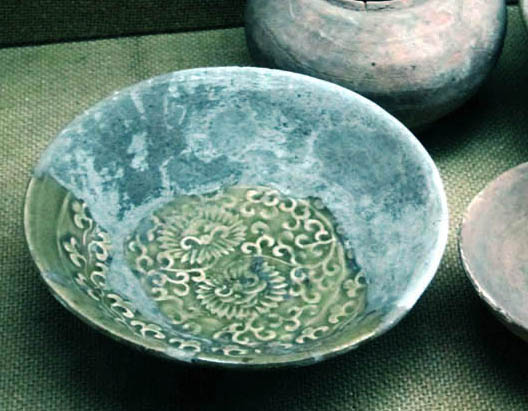 |
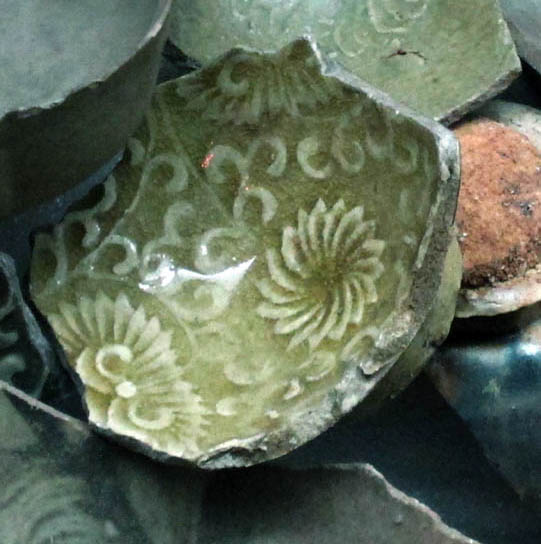 |
|
Examples of Yaozhou style impressed floral bowls from the Xicun kiln exhibited in Guangdong shi museum
|
|
|
|
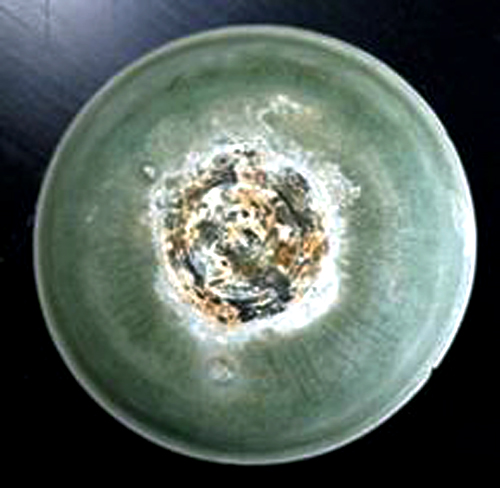 |
|
A Xicun/Huizhou celadon dish from a wreck from Indonesia
|
|
|
|
|
|
Example of Xicun kiln Yaozhou style shallow bowl |
|
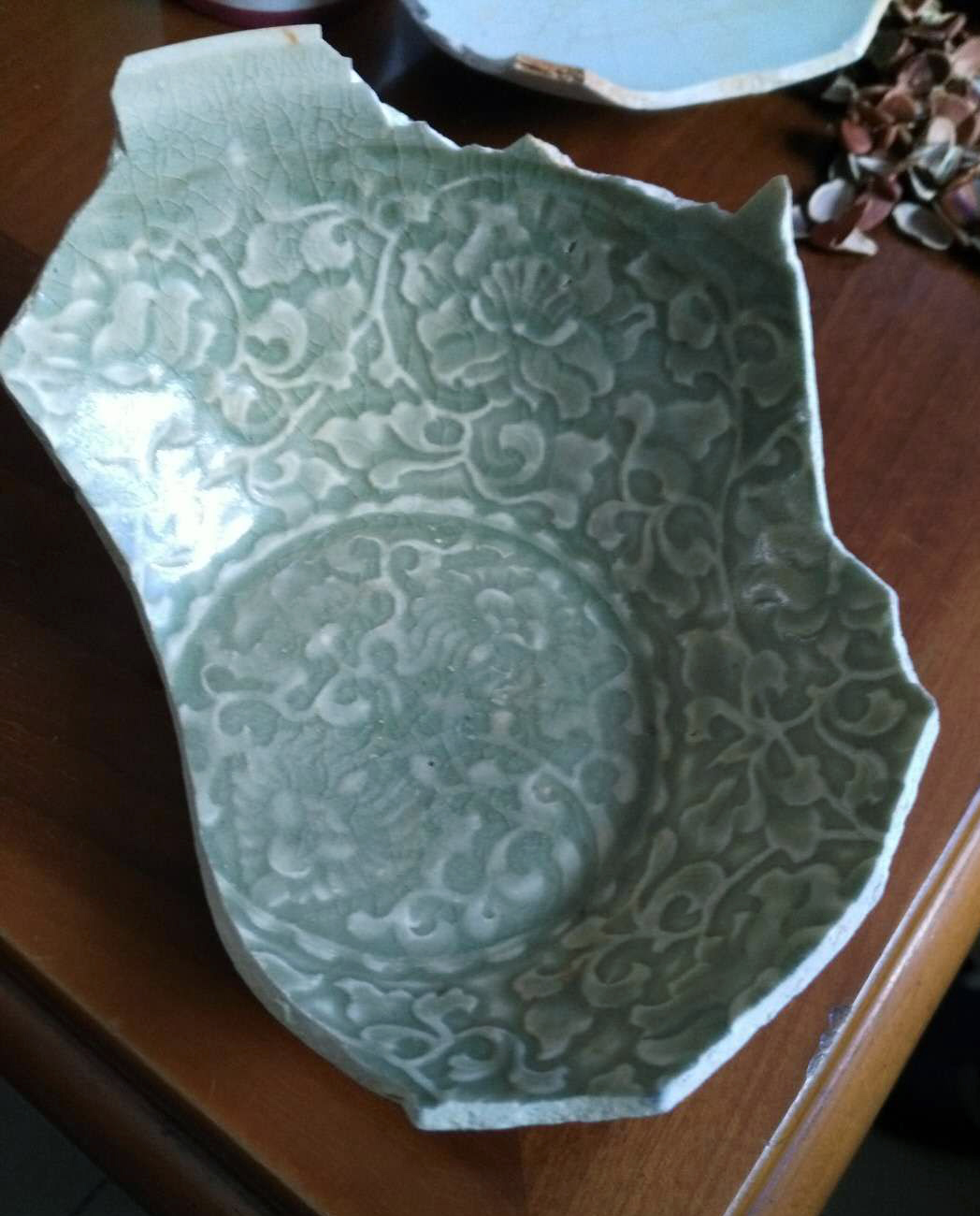 |
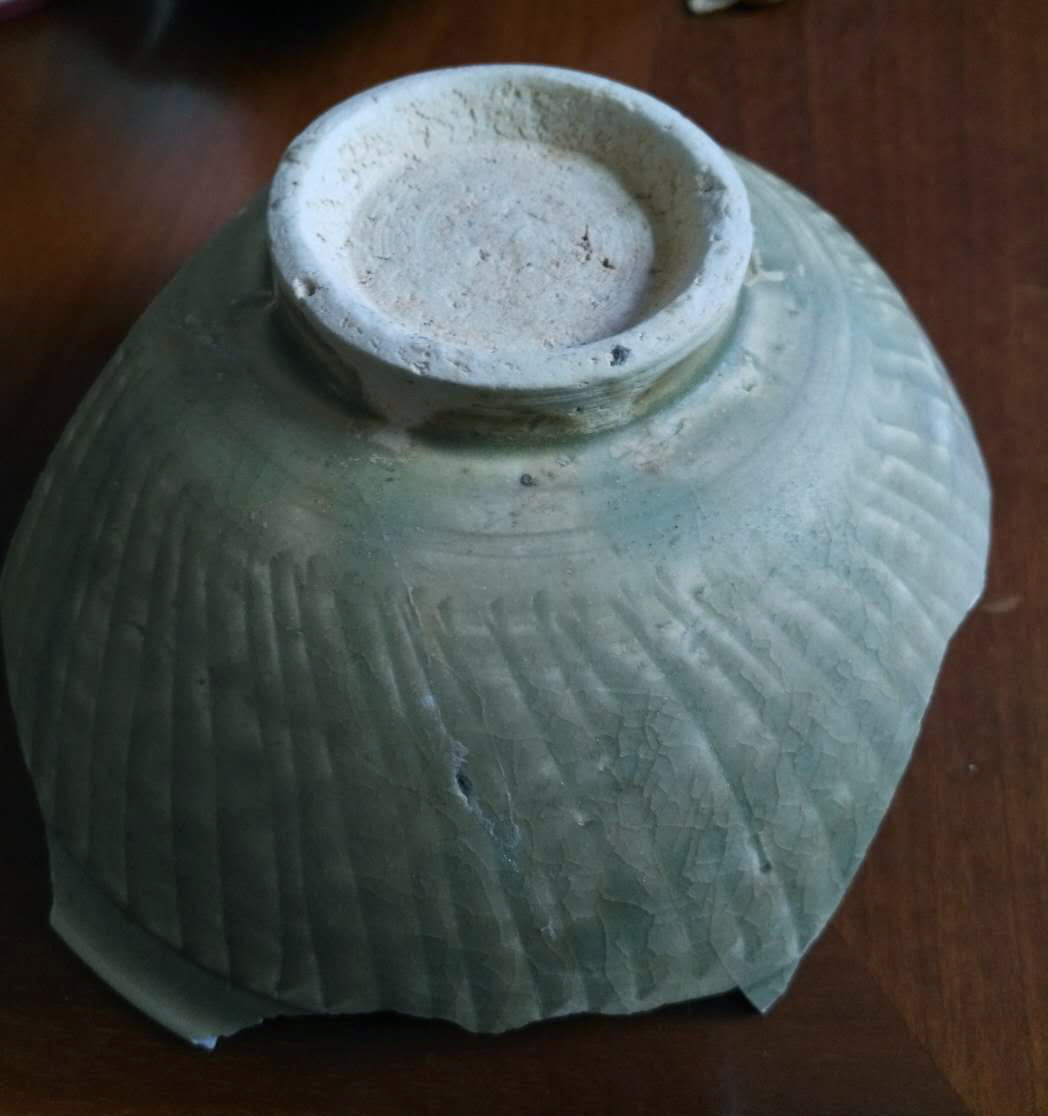 |
Fragment said to be found in a well in Guangdong
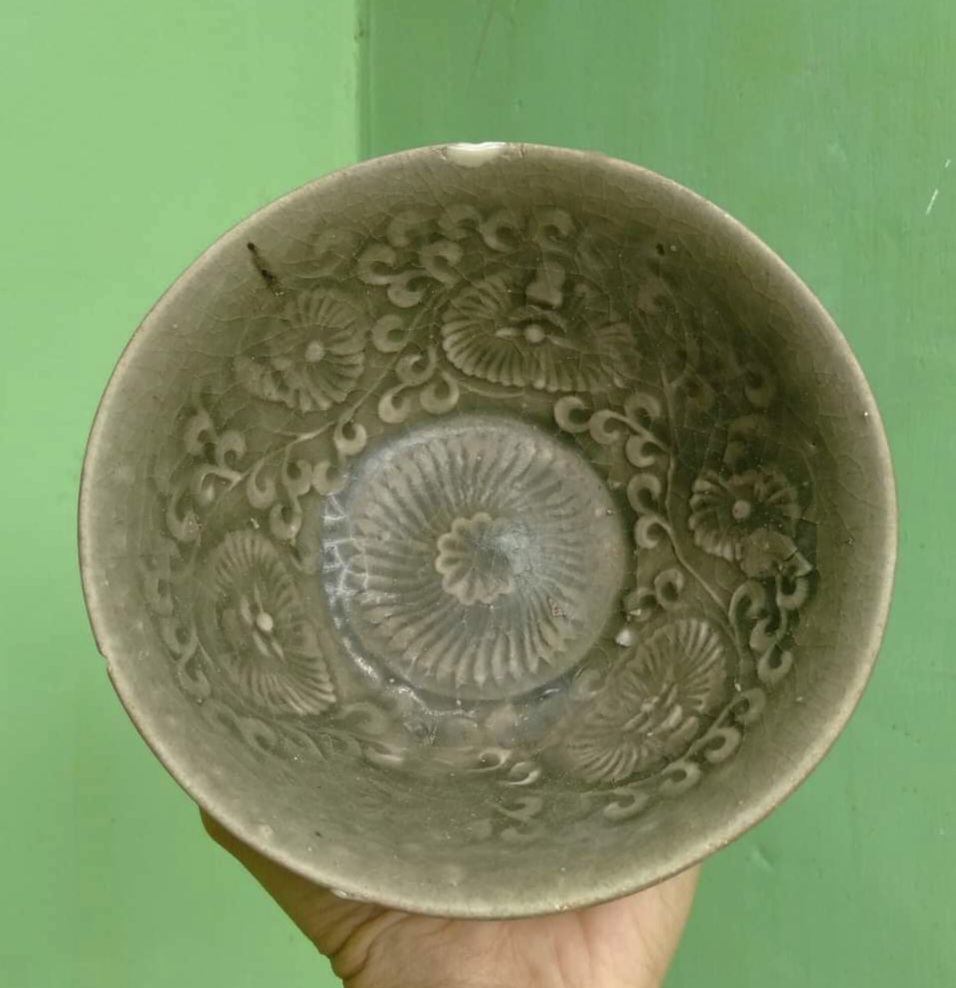 |
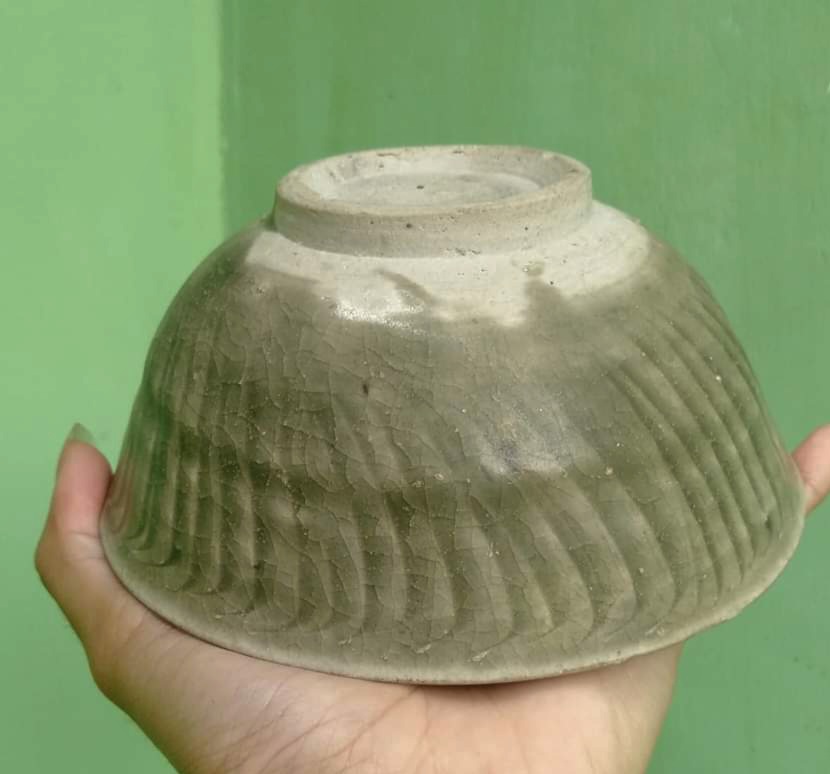 |
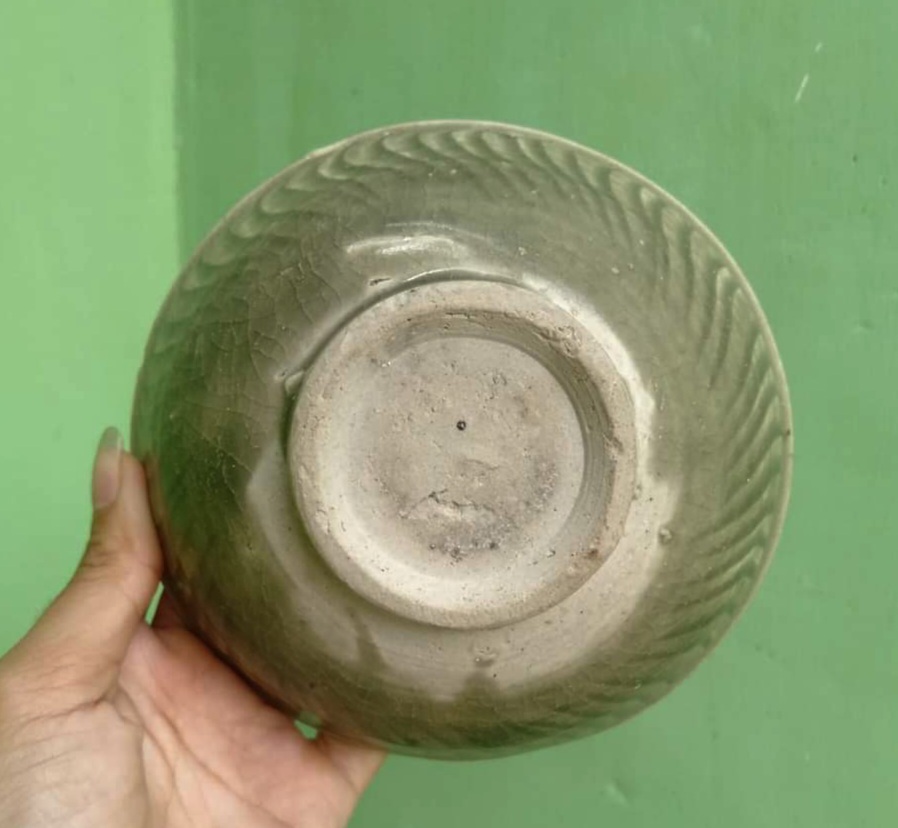 |
 |
 |
 |
| Northern Song Xicun kiln Yaozhou type found in Indonesia |
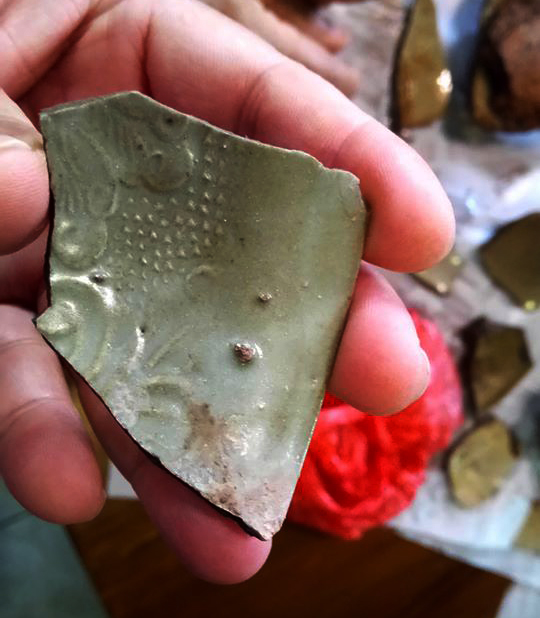 |
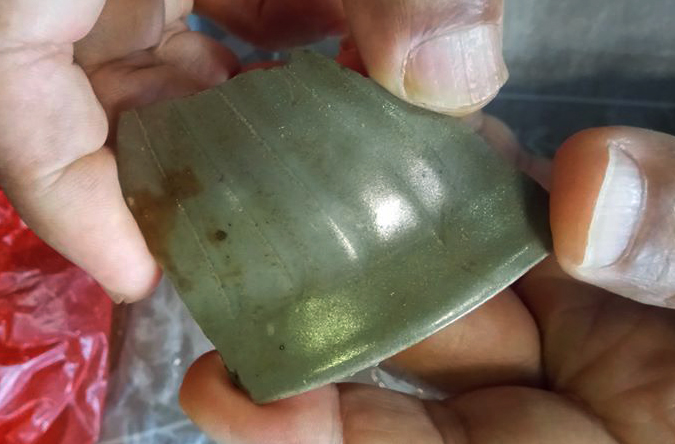 |
| Yaozhou type green glaze fragment with molded decoration |
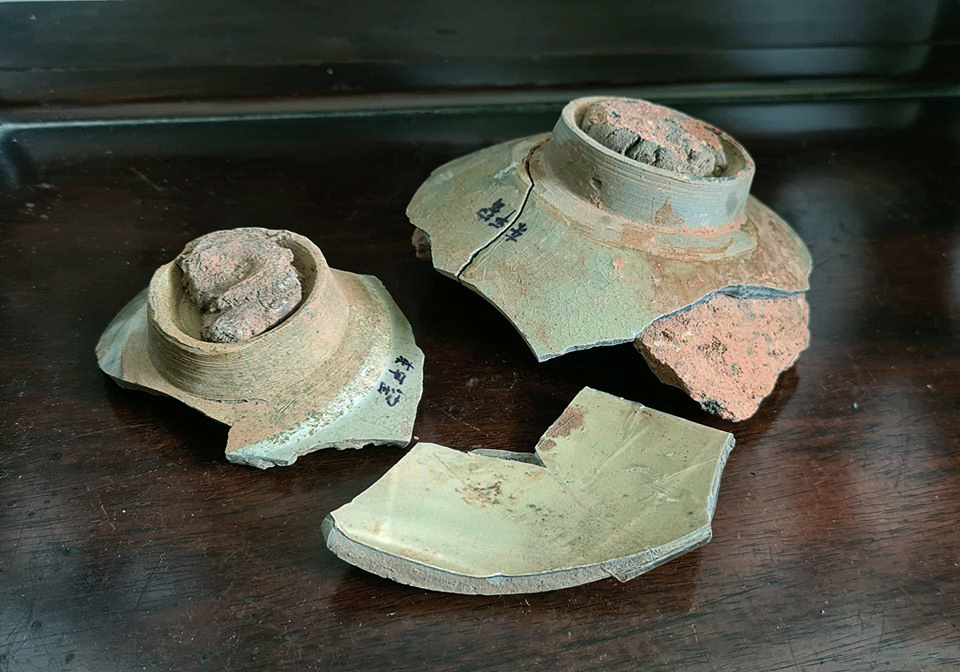 Green
glaze bowl samples from Huizhou Dongping kiln Green
glaze bowl samples from Huizhou Dongping kiln |
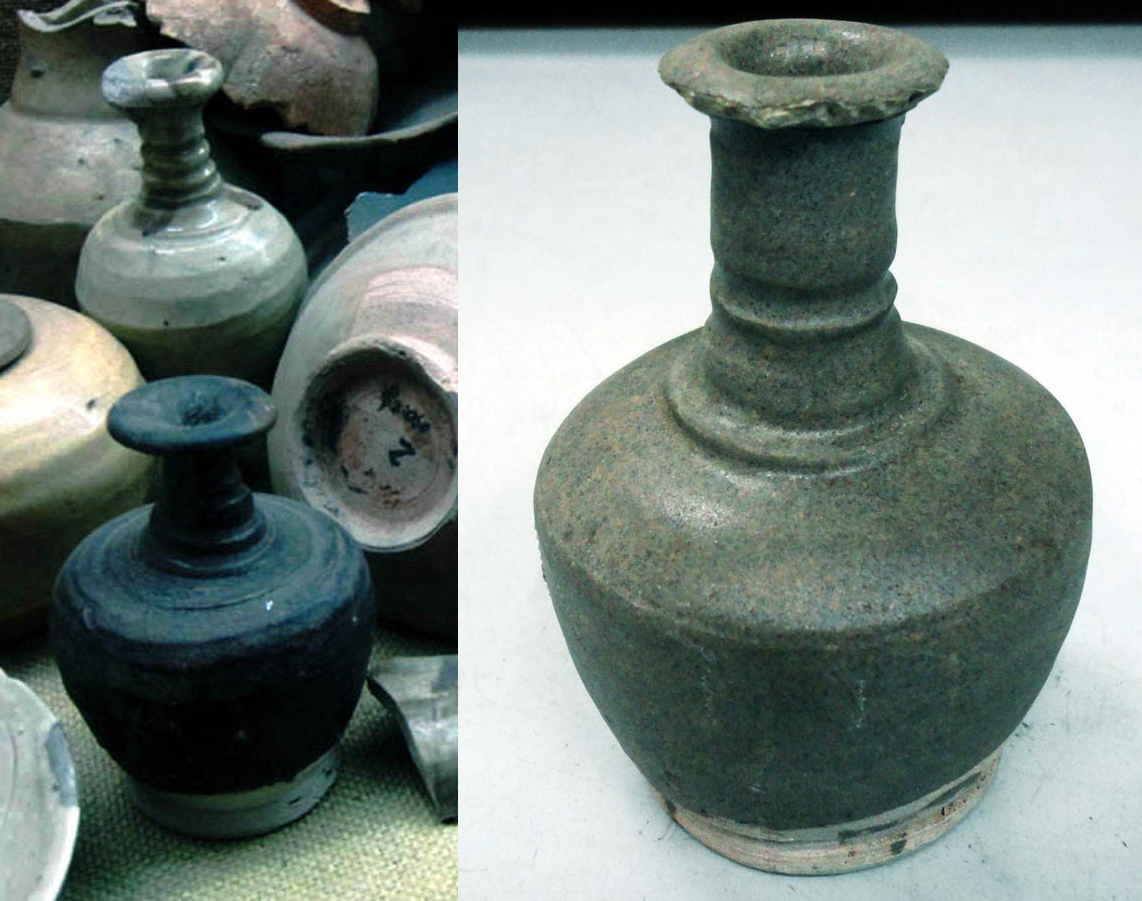 |
| Brown glaze ribbed neck bottle. Left excavated from Xicun kiln and exhibited in the Guangdong Shi Museum. The other is similar in form and likely from Xicun too. It was exported to Indonesia. |
|
|
| Two brown glaze bowls with a band of white glaze rim from the Lingga wreck. A similar one found in Xicun kiln is shown on bottom right. |
|
|
| Northern Song Xicun Brown glaze cover box and bottle from a wreck near Singkep Island |
Chaozhou Bijiashan also produced several other forms of Qingbai and brown glaze ewers. Some are illustrated below:
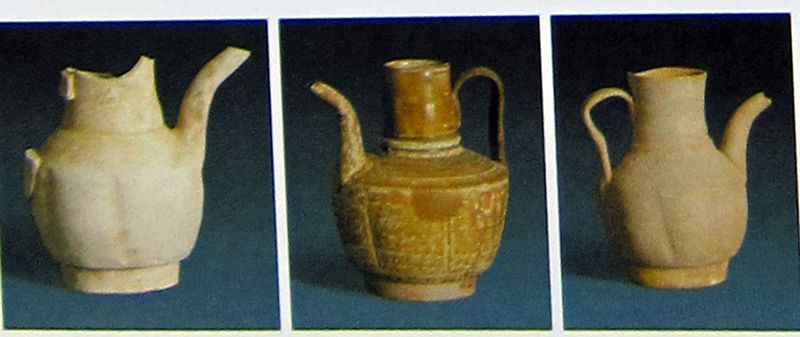 |
|
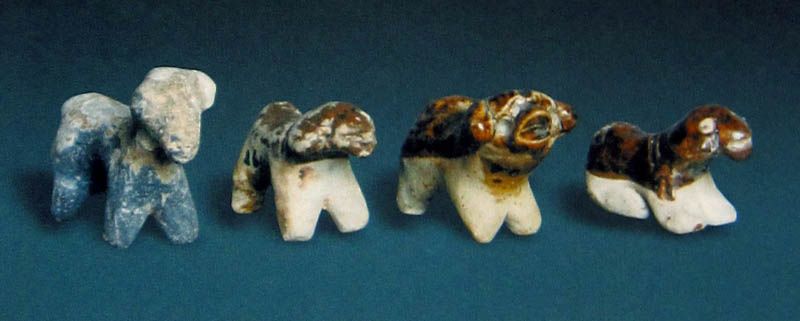 |
| Brown glaze miniature dogs figurine from Bijia Shan kiln |
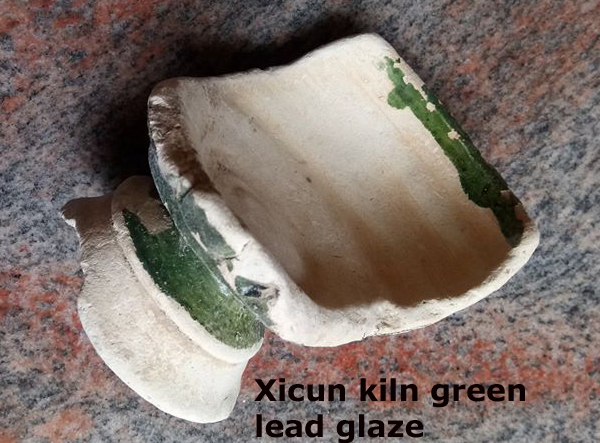
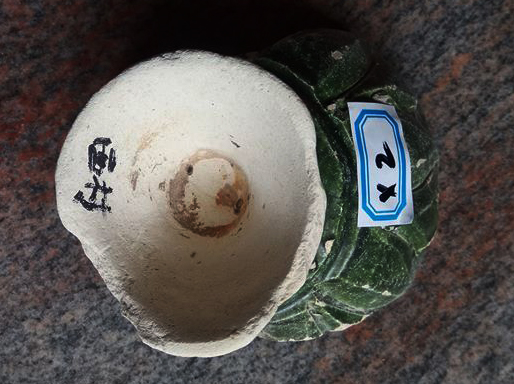
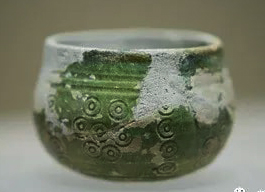 |
| Green glaze pot recovered from Xicun Kiln site |
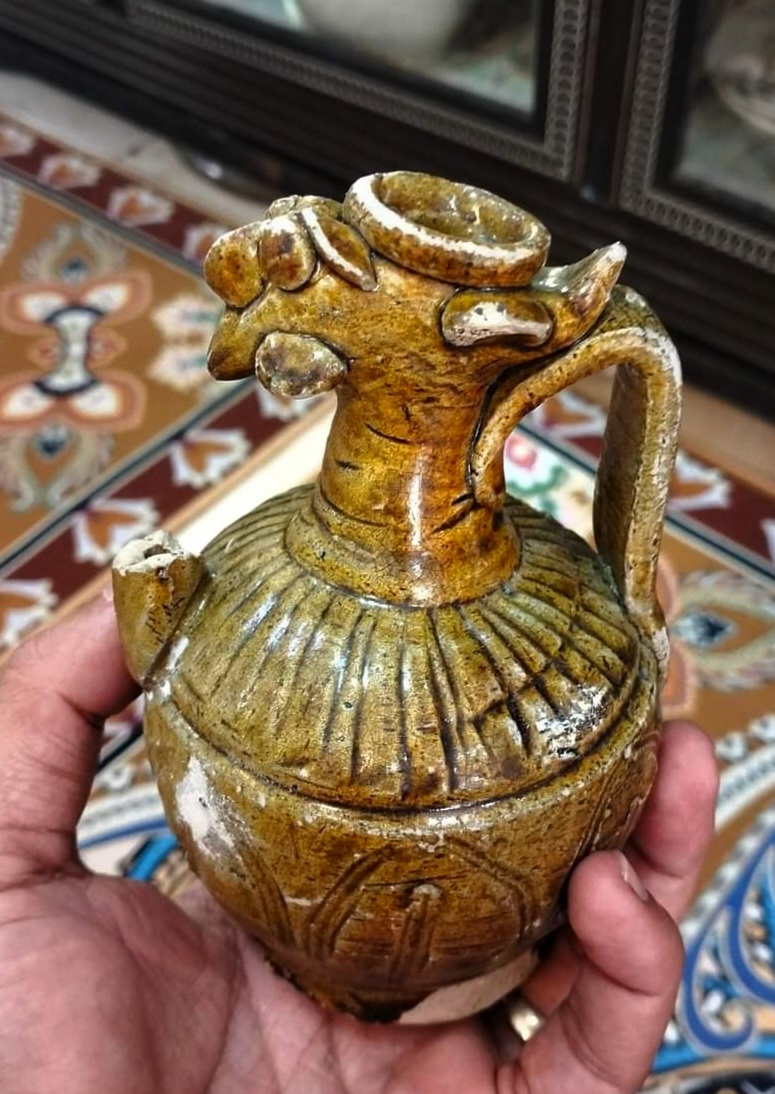 |
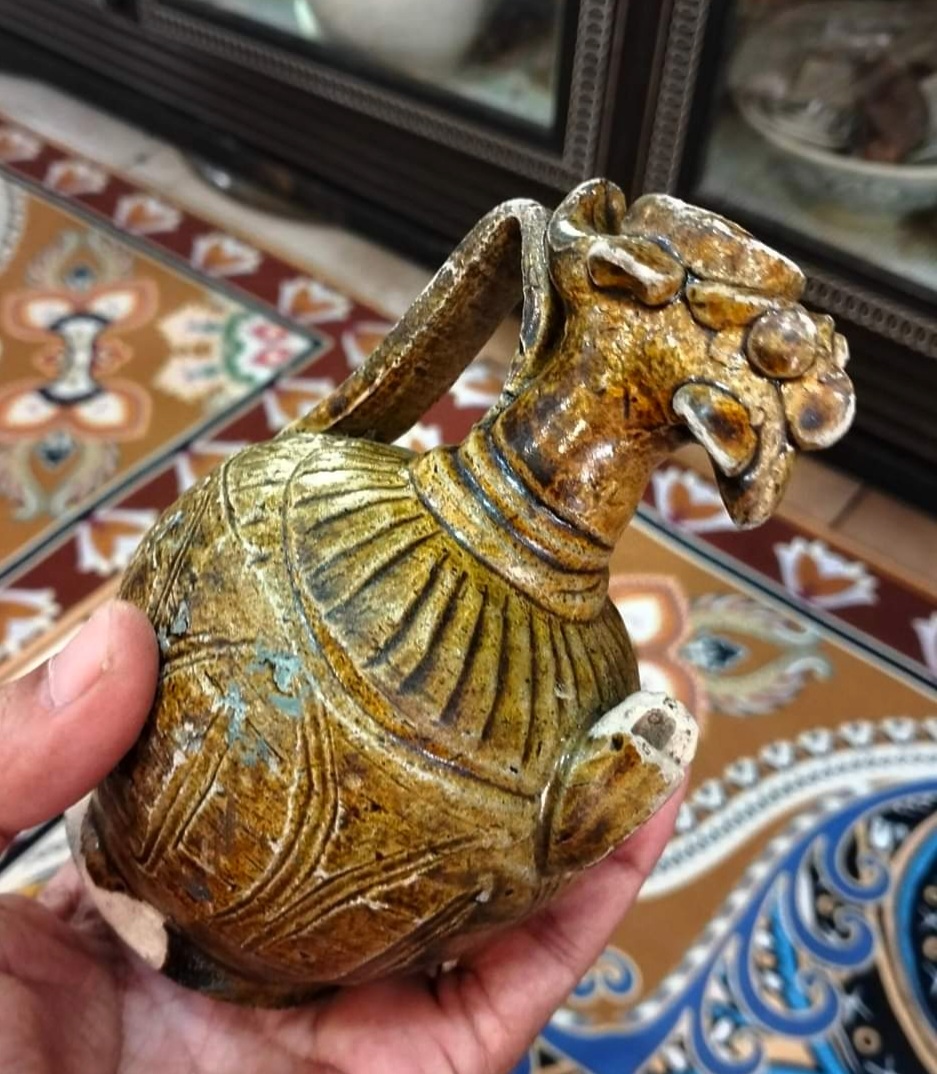 |
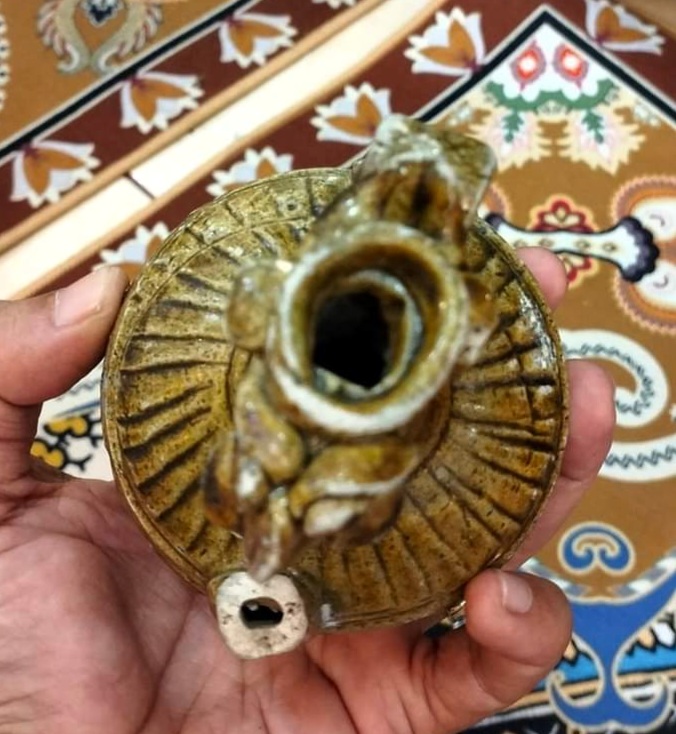 |
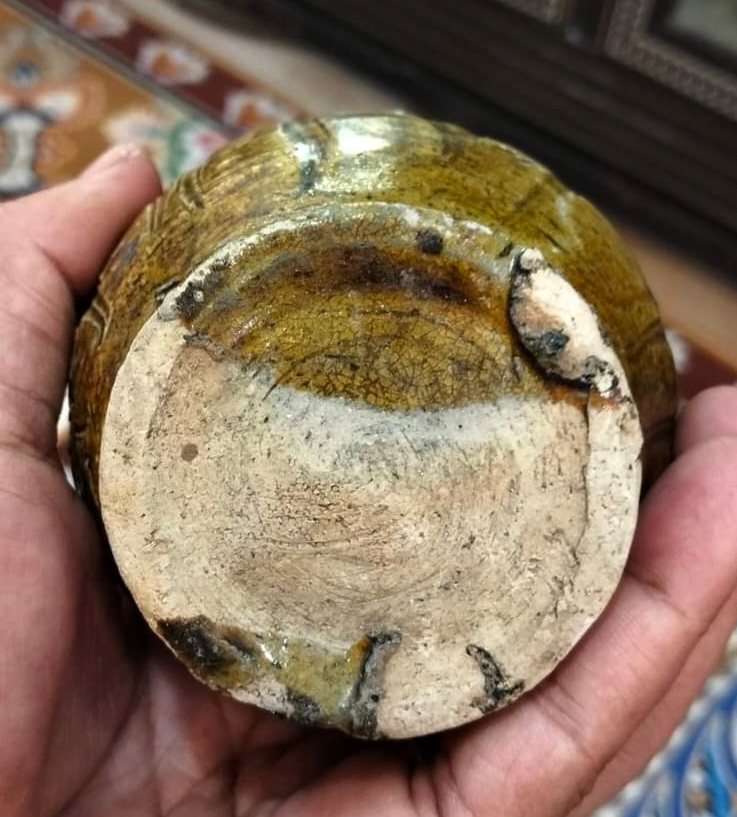 |
| Small lead yellow glaze phoenix head ewer found in Sumatra. The form matches the green glaze ewers from Xicun kiln |
Northern Song Fujian ceramics from the Lingga, Pulau Buaya wreck and Flying Fish wreck
The post of Shi Bosi (市舶使), ie the Superintendent of Maritime Trade was established in Quanzhou in 1087 A.D. It was a significant event which engendered favourable condition for Fujian coastal kilns to participate in the maritime ceramics trade. Recent Xisha Island Chinese marine archaeological surveys have uncovered some green glaze Tongan type bowls produced in Fuian Songxi kiln.
Several late Northern Song wrecks salvaged also revealed some quantity of Fujian ceramics. The ceramic cargo mix showed that in term of quantity and variety, those from Guangdong still predominated. They were produced in Minnan Southern Fujian region. In fact, geographically this region is near the quanzhou port and not far from Chaozhou. The white/qingbai wares of Chaozhou and kilns in Minan share similar charcteristics and pose identification issues. This difficulty is complicated by the relative lack of published archaeological information.
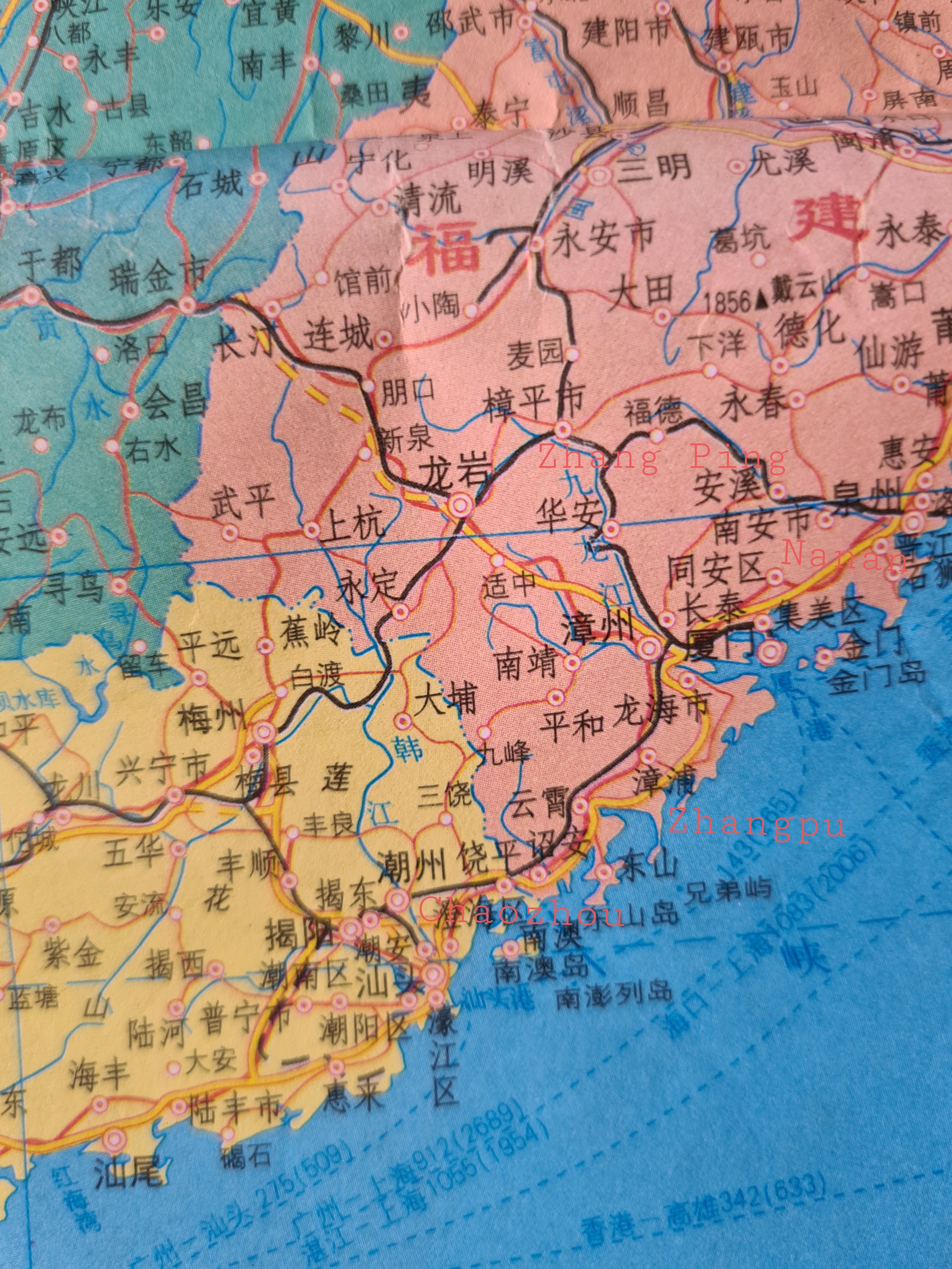 |
| Map showing Northern Guangdong and Southern Fujian |
From the Lingga wreck, I have highlighted the similarity of Qingbai cover boxes and ribbed neck vases from Chaozhou Bi Jia shan and Fujian Nanan kiln. In the wreck, there is also a form of bowl with everted rim and relatively tall foot. They are known to be produced in Xicun kiln but has grayish green glaze. They should be differentiated from those produced in Nanan kiln which has white, grayish white or qingbai glaze. Significant quantity was salvage from the Lingga wreck. There are also some large shallow bowl with relatively fine more whitish glaze.
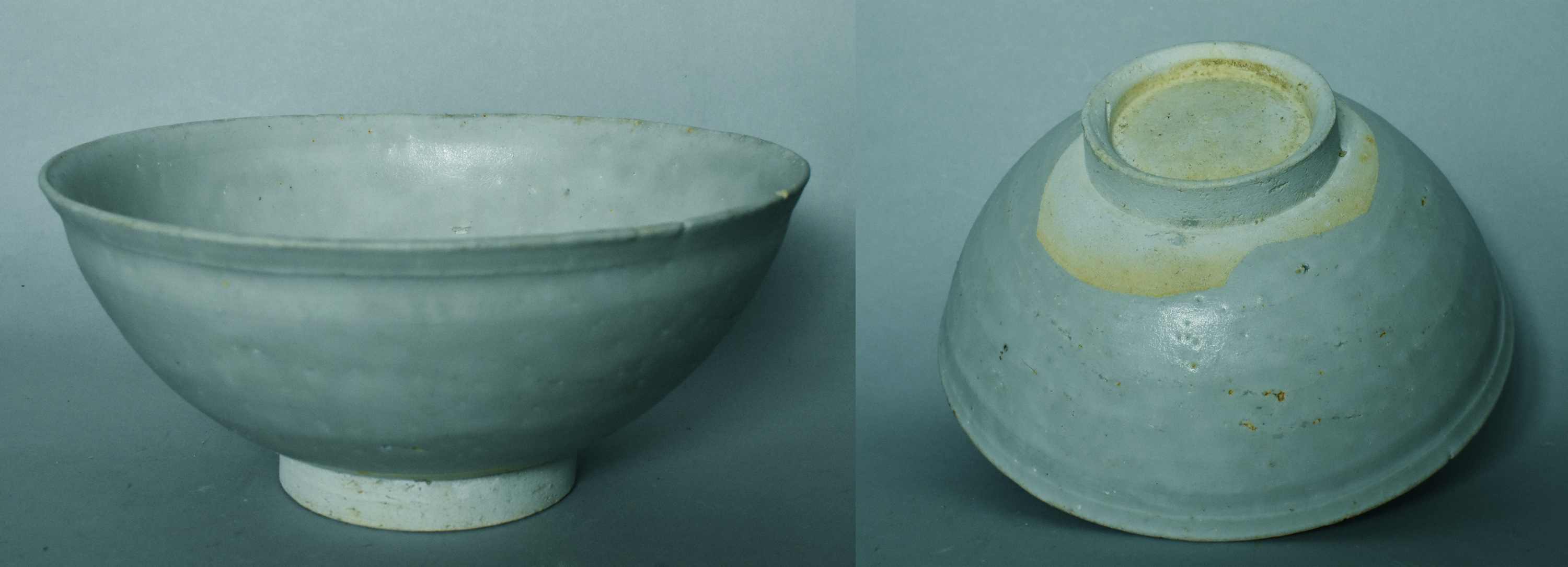 |
|
| Grayish white glaze bowl from the Lingga. Similar form known to be produced in Xicun kiln but has grayish green glaze. This example is likely from Nanan kiln. | |
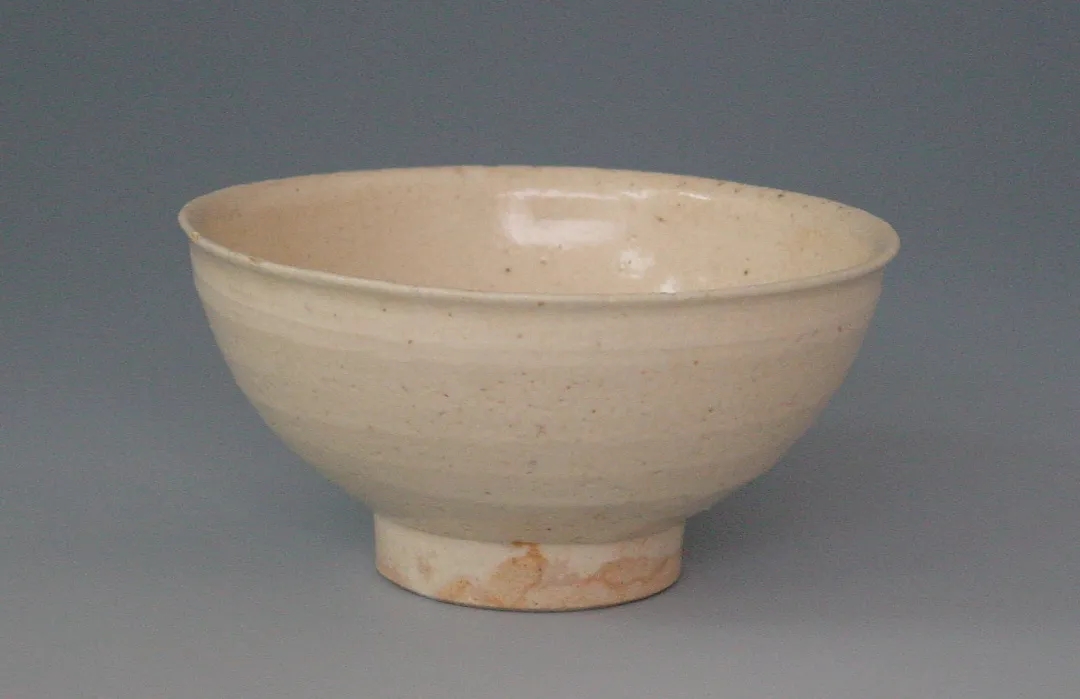 |
|
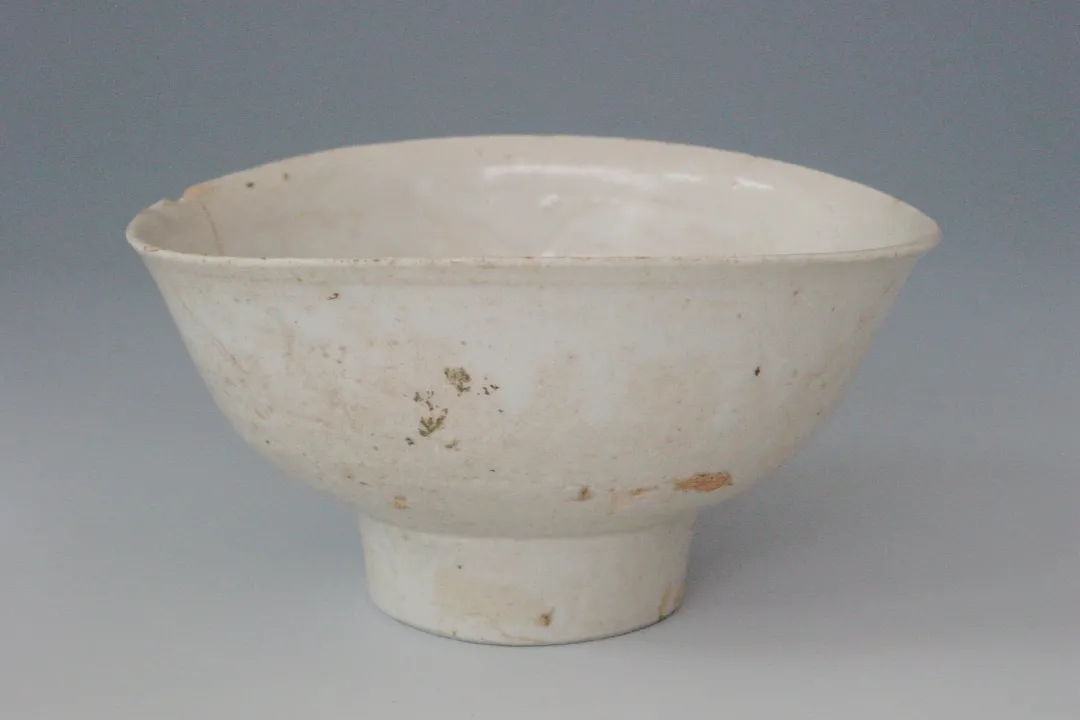 |
|
| Excavated from Nanan museum | |
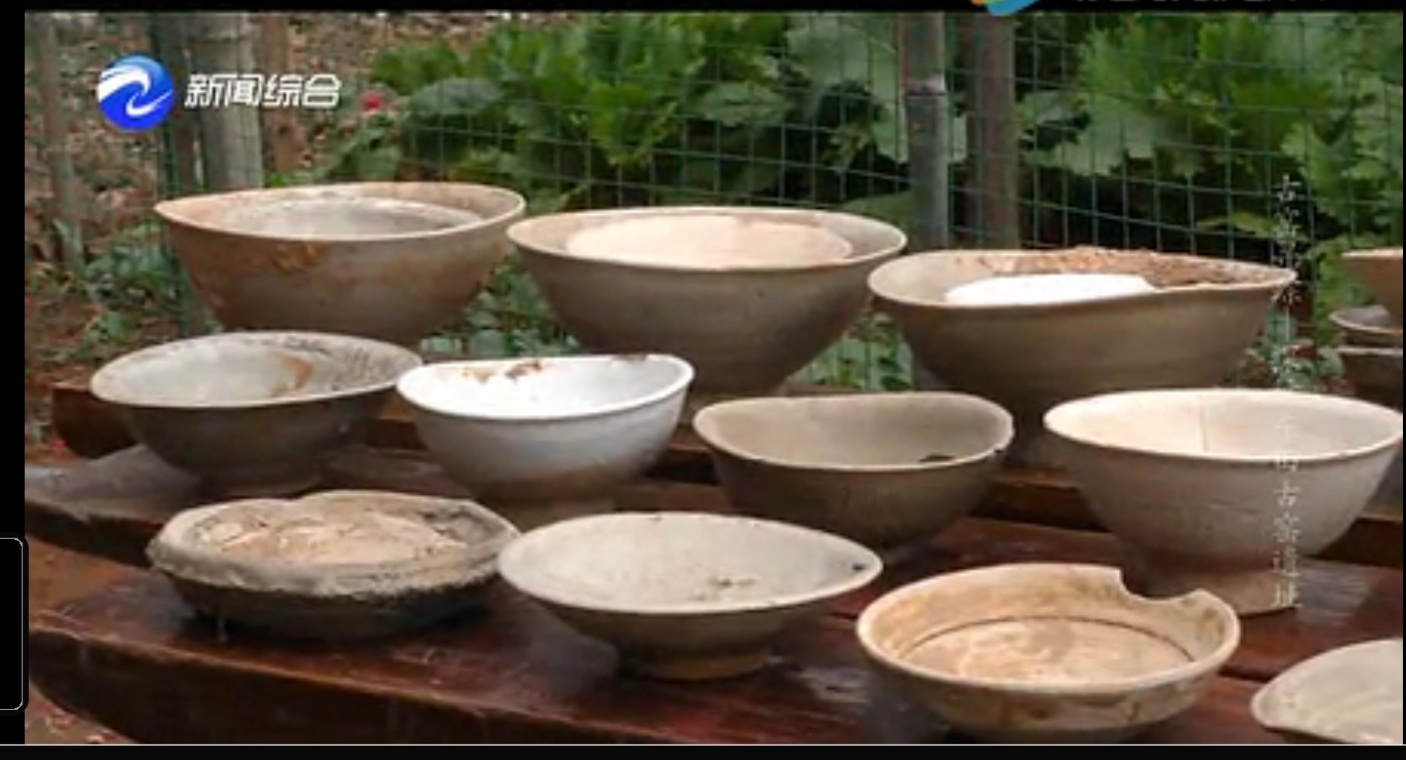 Excavated
examples from Nanan kiln Excavated
examples from Nanan kiln |
|
 Two
white glaze shallow bowls from Lingga wreck. They could be products
of Nanan kiln Two
white glaze shallow bowls from Lingga wreck. They could be products
of Nanan kiln |
|
In the Pulau Buaya wreck, there were some celadon bowls with carved and combed swirling abstract motif with slashed lines on the outer wall. The author of the book on the Pulau Buaya wreck has attributed them to Fujian Tongan or Nanan kilns. Such celadon bowls were inspired by the Longquan celadon of the late Northern Song period and much copied by the Fujian kilns. The colour tone ranges from olive green, grayish green to different degree of yellow. It is commonly termed Tongan type or Juko (shuko seiji) greenware, name after a Japanese monk tea ceremony master Juko [shuko].
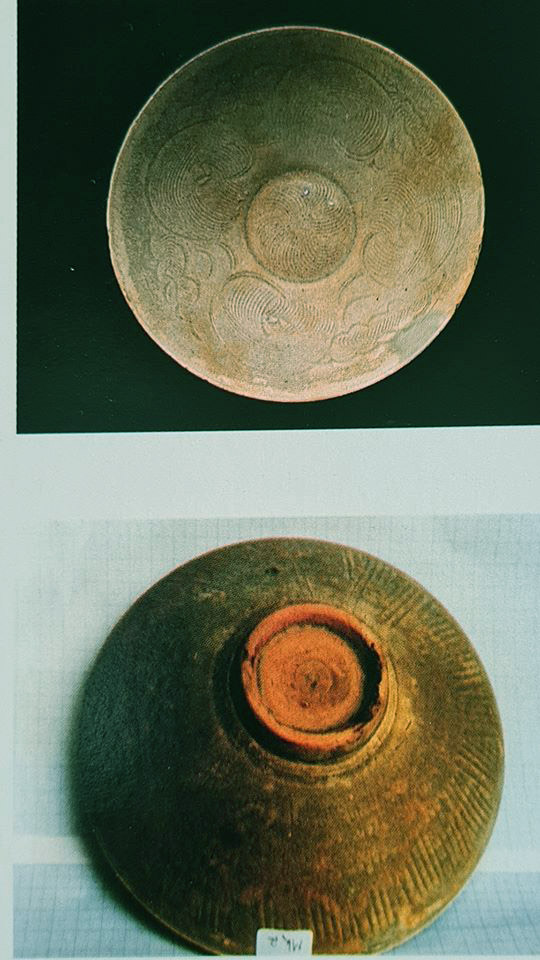 |
| Green glazeTongan type bowl from Pulau Buaya wreck |
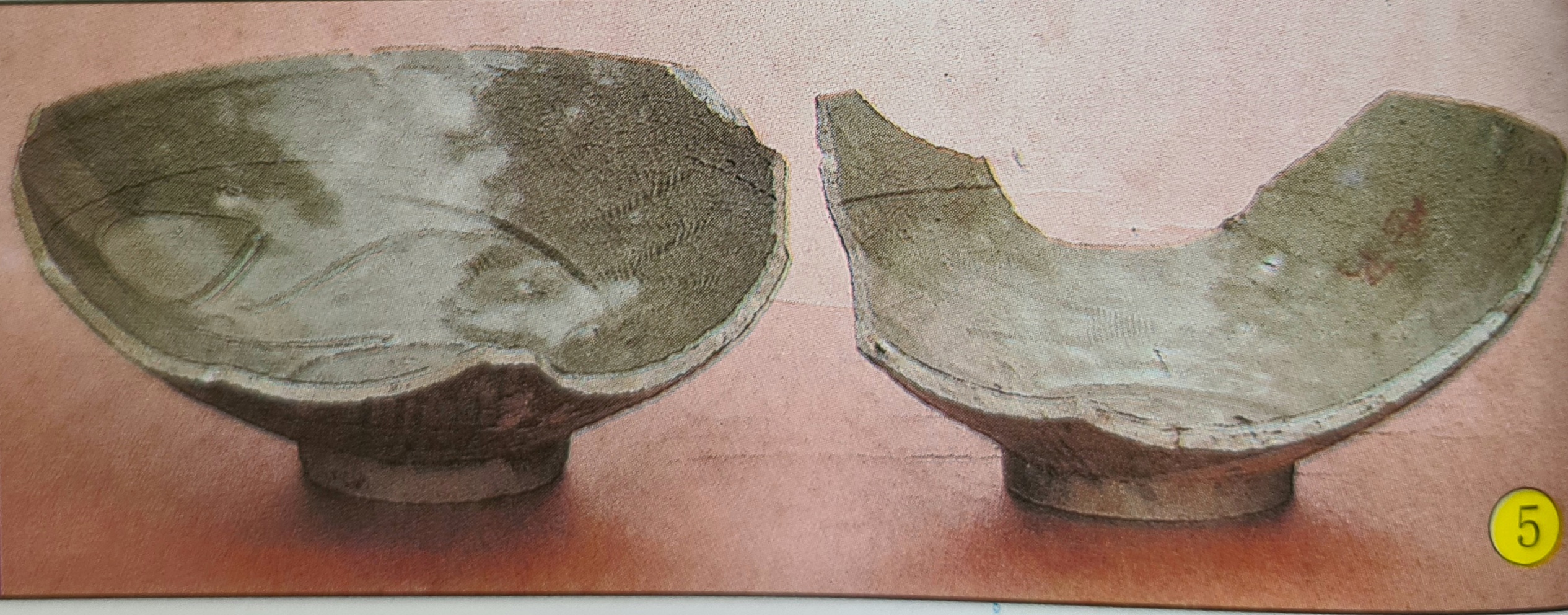 |
| Bowl fragments with carved/combed decoration from Nanan Kiln |
Besides the typical late Northern Song Jingdezhen Qingbai wares, there were a number of Qingbai wares from some provincial kilns. There are some Qingbai bowls with carved deer motif enclosed with a lozenge on the inner base and floral like carved/combed motif on the inner wall. Such bowls were produced in Southern Fujian Zhangping (漳平) and quite a few examples from the kilns have been published in a book on Zhangping kiln and also similar examples were found in Zhangpu kiln. For
|
|
|
|
Pulau Buaya wreck Qingbai bowl with deer motif |
|
|
|
|
|
Qingbai bowl with deer motif from the Zhang Ping kiln |
In the wreck there is also another form of high footed qingbai bowl. Similar type has also been found in the Zhangpu kiln.
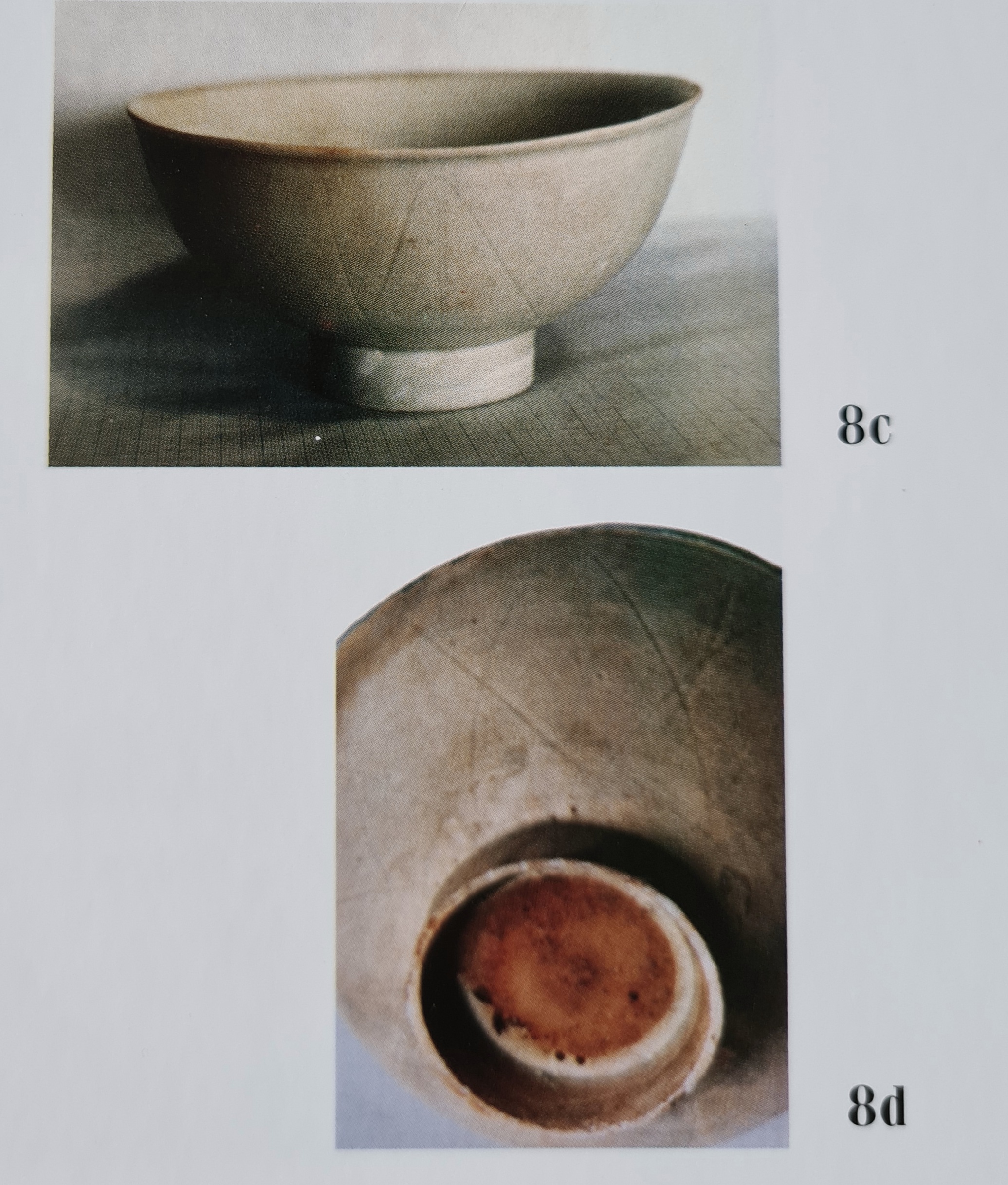 |
| High footed qingbai bowl with angular incised lines on the exterior from the Pulau Buaya wreck |
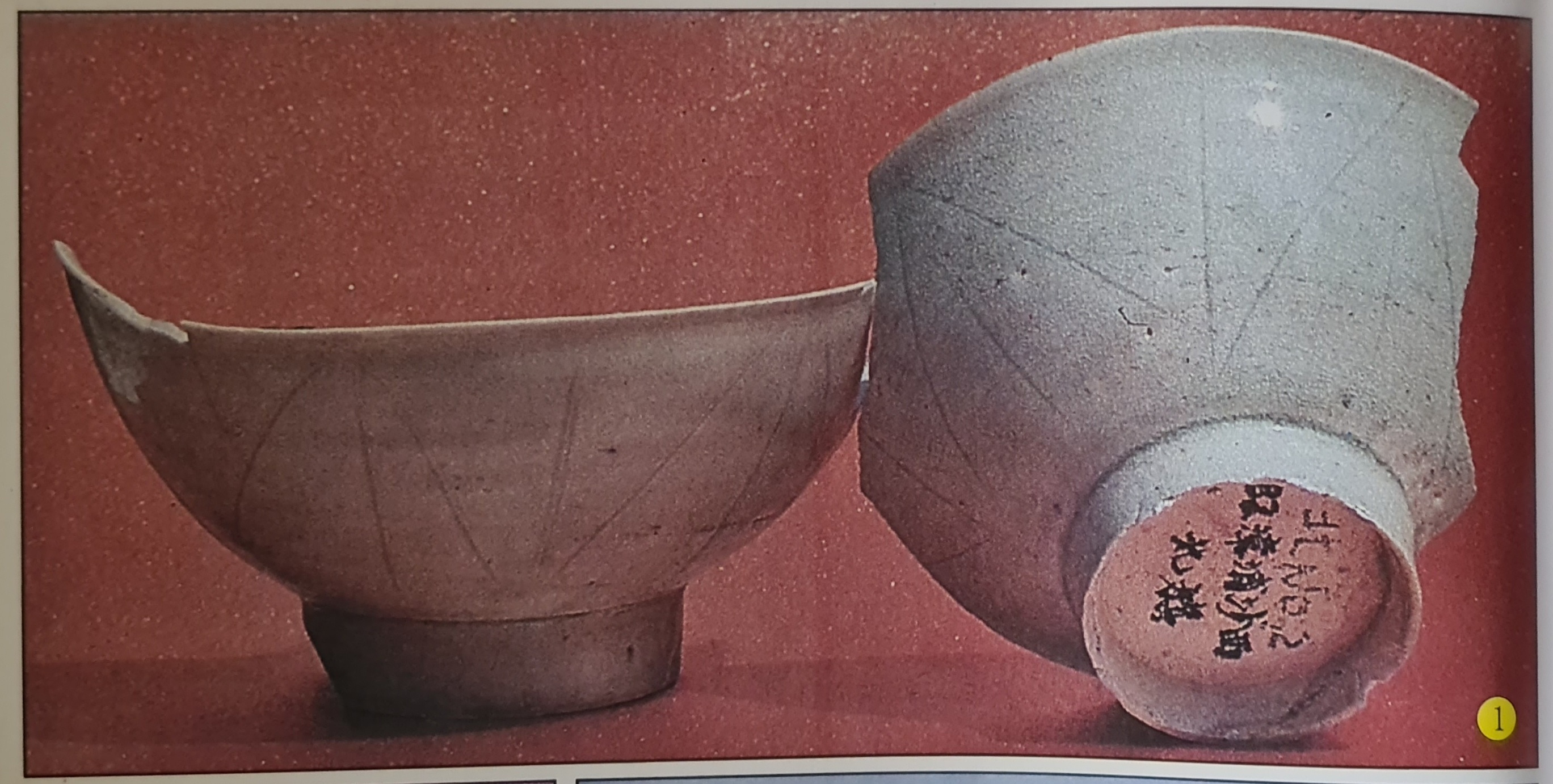 Similar
example from Fujian Zhangpu kiln Similar
example from Fujian Zhangpu kiln |
In 2017, a wreck was discovered near Sabah and named "The Flying Fish" by the marine archaeologist Dr Michael Flecker. So far, detailed information is still not available. However, it is very likely that majority of the ceramics cargo could be of Fujian origin. Among them, those brown glaze jarlets and basins with iron-brown painted fish decoration are from Quanzhou Cizao kiln. From a published photo of a group of ceramics recovered, they are also Minnan Qingbai and green glaze wares.
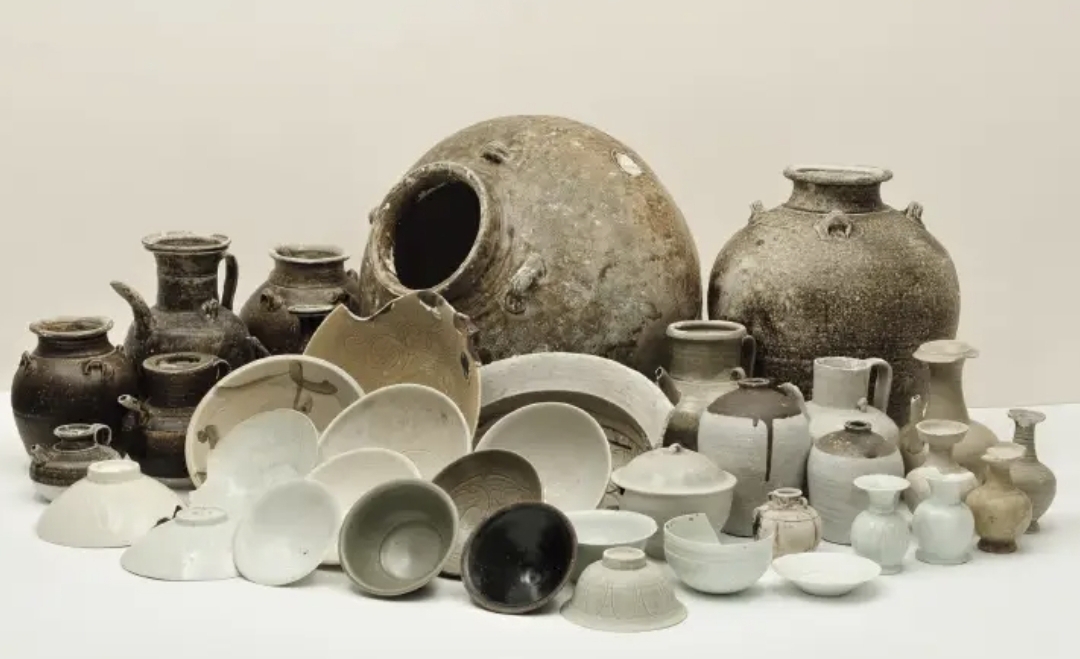 |
| Ceramics salvaged from the Fly Fish wreck |
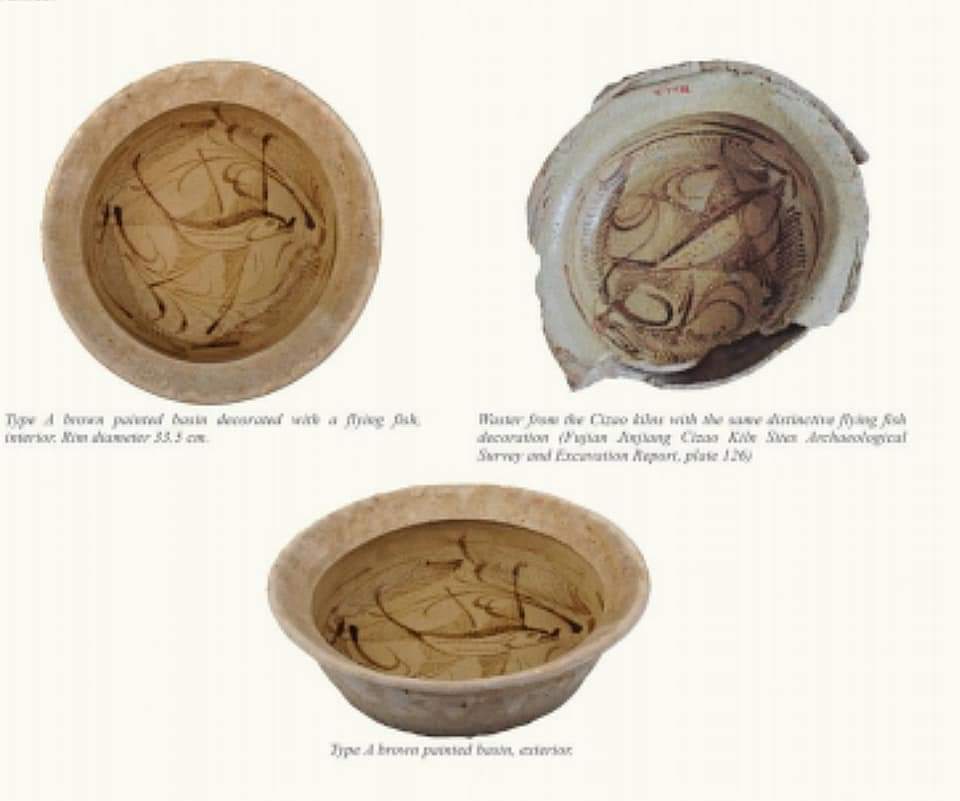 |
| Basins with iron-brown painted decoration from the Cizao kiln |
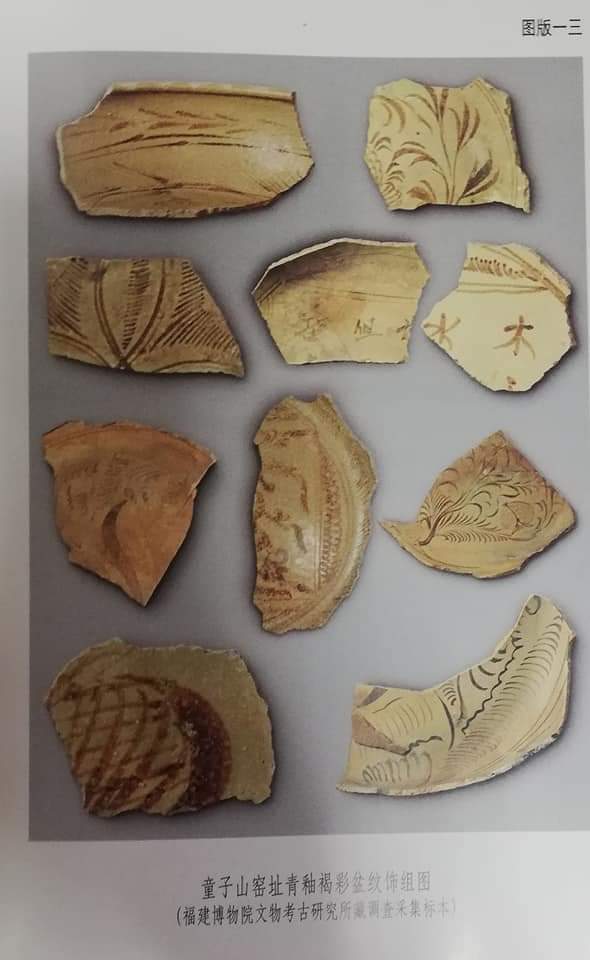 |
| Examples from Cizao kiln |
Concluding remarks
Written by: NK Koh (16 Nov 2012) updated: 30 Jun 2013, 18 Jan 2017, 3 Jul 2017, 18 Apr 2020, 6 Jul 2021, 15 Feb 2023
References:
1. Ceramic Finds from Tang and Song Kilns in Guangdong
2. Guangdong Ceramics from Butuan and other Philippine sites
3. A Ceramic Legacy of Asia's Maritime Trade - Song Dynasty Guangdong Wares and other 11th- -19th Trade Ceramics found on Tioman Island, Malaysia
4. The Pulau Buaya Wreck